Pulmonary Exam 1: Physical Examination of the Respiratory System
1/97
There's no tags or description
Looks like no tags are added yet.
Name | Mastery | Learn | Test | Matching | Spaced |
|---|
No study sessions yet.
98 Terms
Type of respiratory assessment involving:
- Posture, shape, movement & dimensions of the chest
- Flared nostrils
- Use of accessory muscles
- Skin & nail color, rate
- Rhythm and depth of respiration & ability to speak
inspection
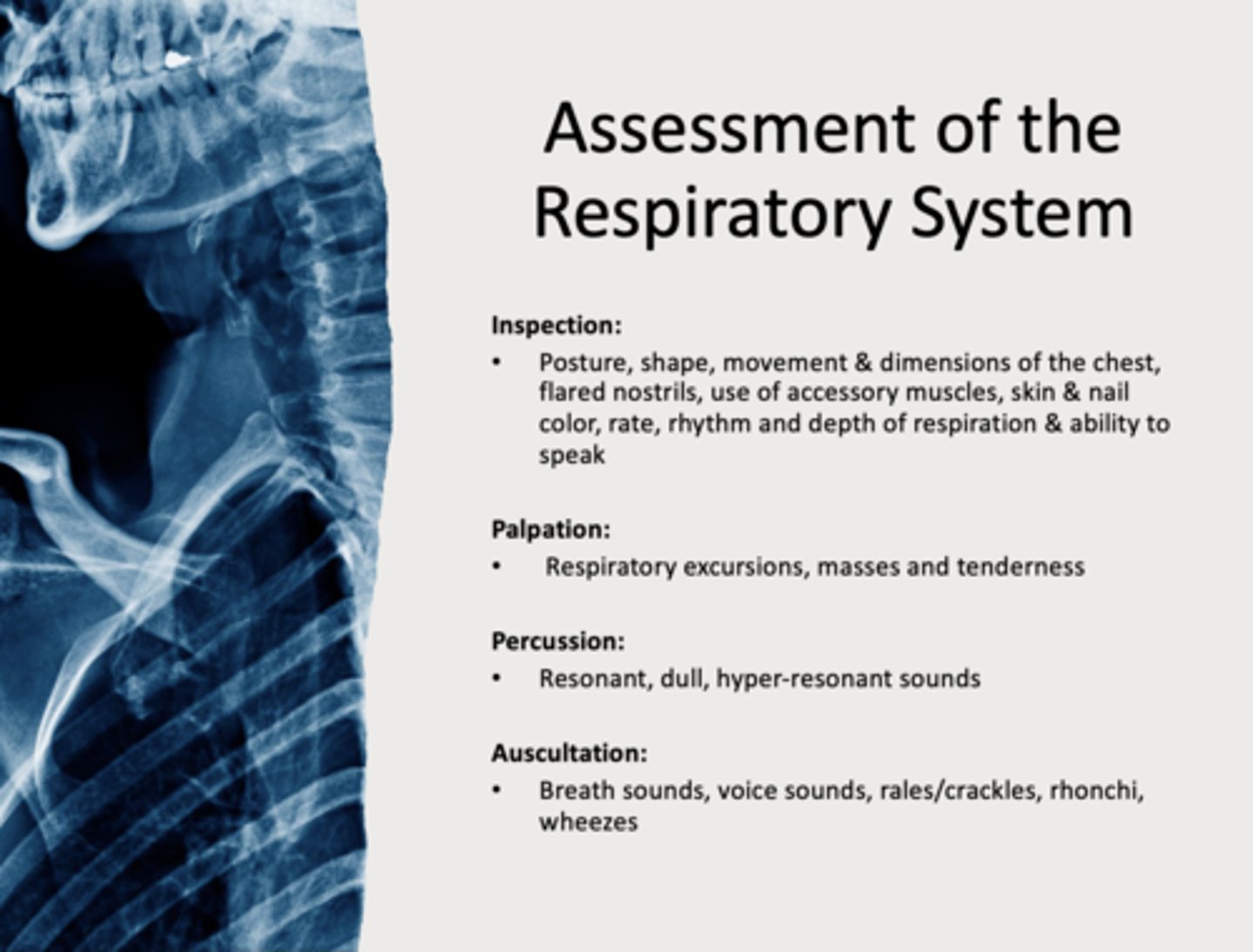
Type of respiratory assessment involving:
- Respiratory excursions, masses and tenderness
Palpation

Type of respiratory assessment involving:
- Resonant, dull, hyper-resonant sounds
Percussion

Type of respiratory assessment involving:
- Breath sounds, voice sounds, rales/crackles, rhonchi, wheezes
Auscultation
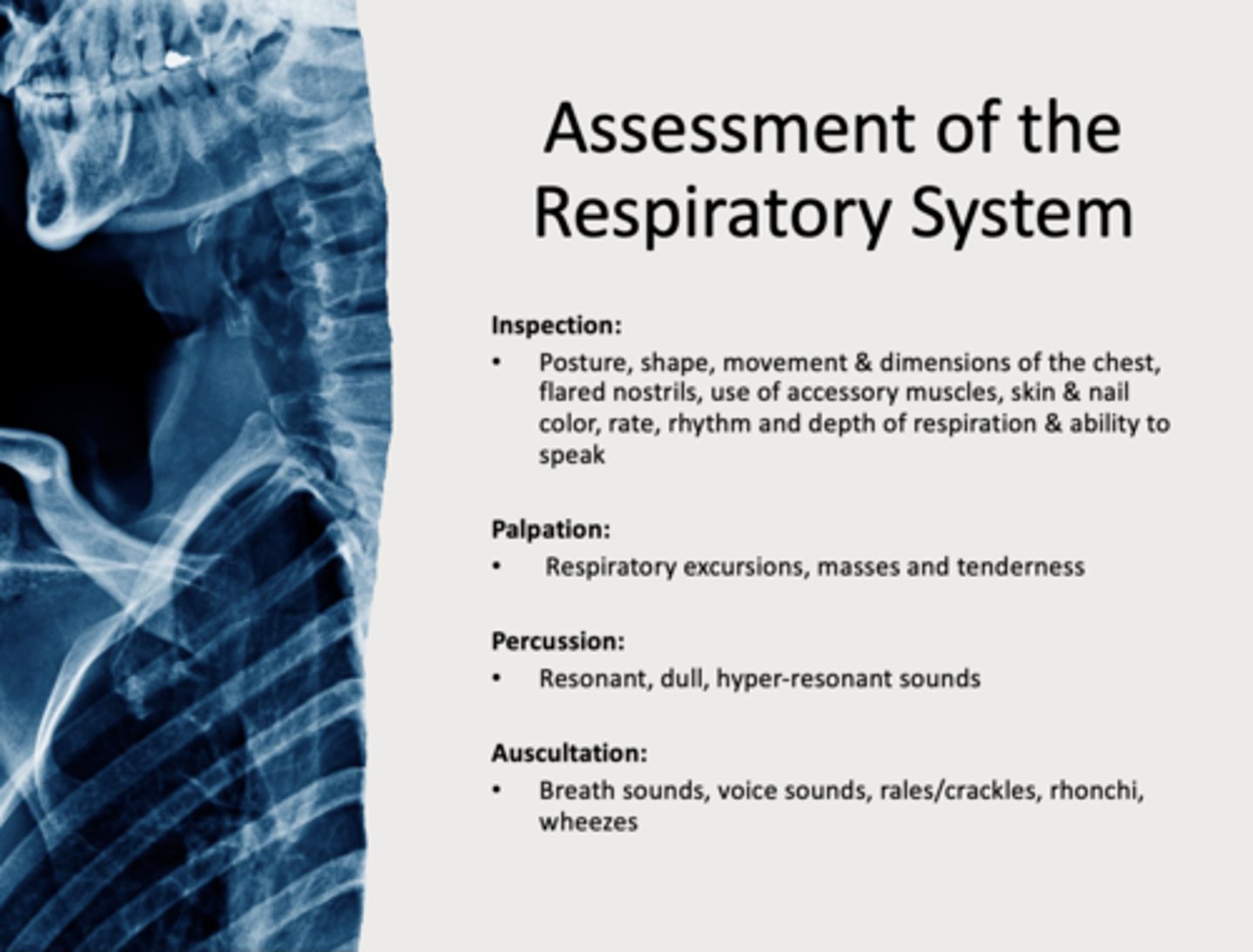
What should you gather from watching a patient breathe?
Comfort and breathing pattern
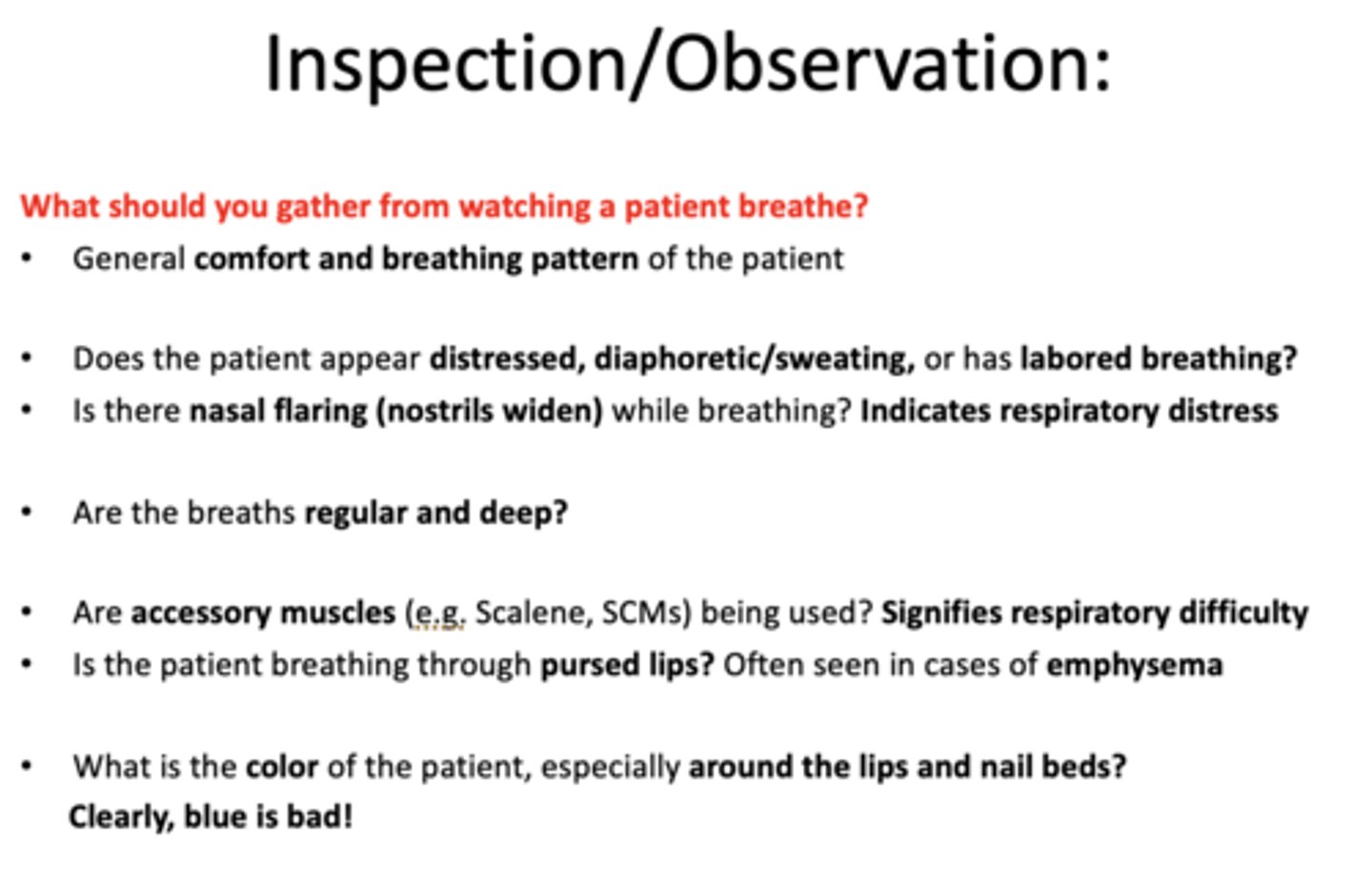
All of the following are questions to ask when observing what?
- Does the patient appear distressed, diaphoretic/sweating, or has labored breathing?
- Is there nasal flaring (nostrils widen) while breathing? Indicates respiratory distress
- Are the breaths regular and deep?
- Are accessory muscles (e.g. Scalene, SCMs) being used? Signifies respiratory difficulty
- Is the patient breathing through pursed lips? Often seen in cases of emphysema
- What is the color of the patient, especially around the lips and nail beds? (Clearly, blue is bad!)
Comfort and breathing pattern
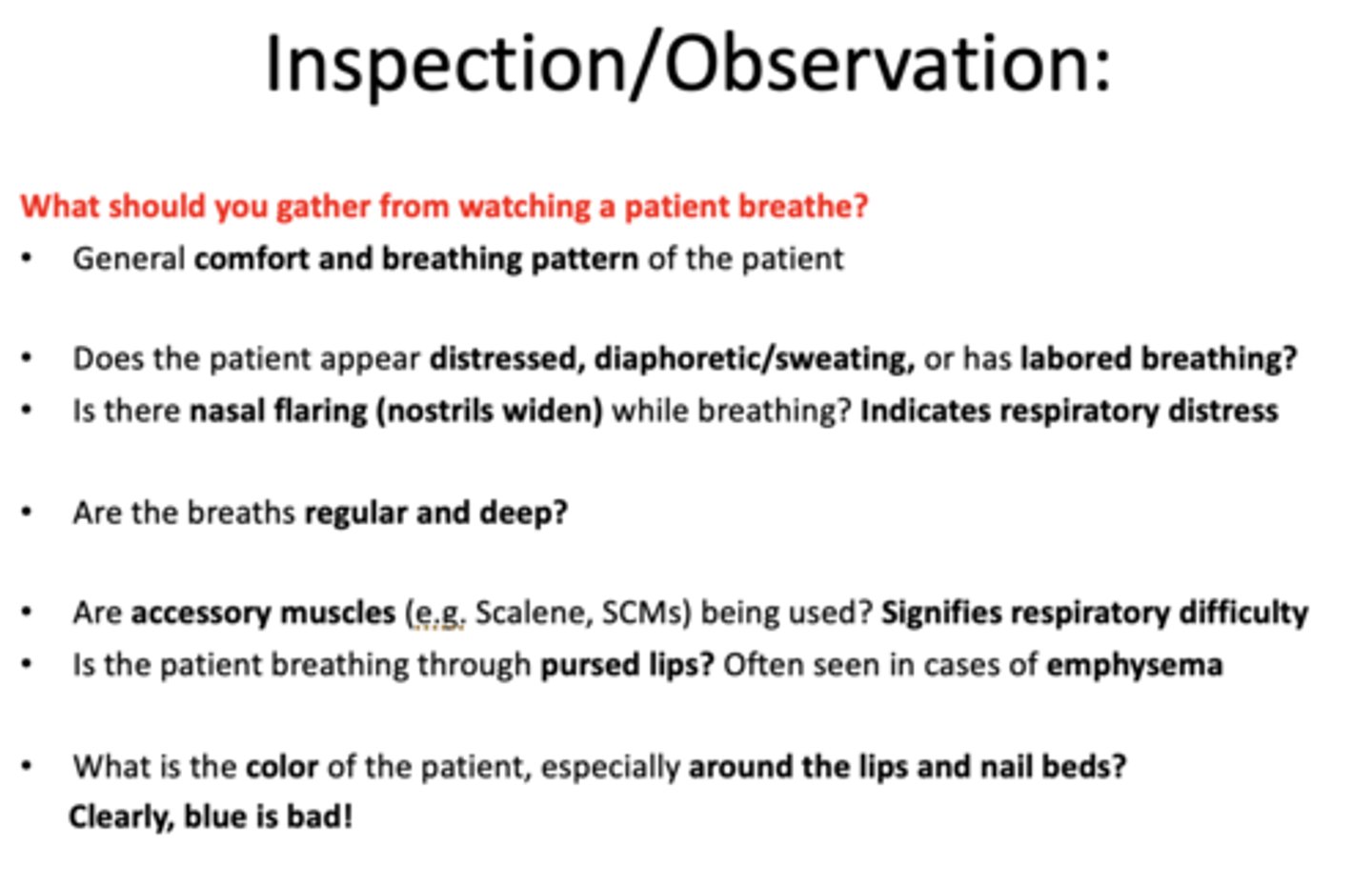
In cases of real distress, patients will lean forward, resting their hands on their knees This position is known as the ____________ position
tri-pod position
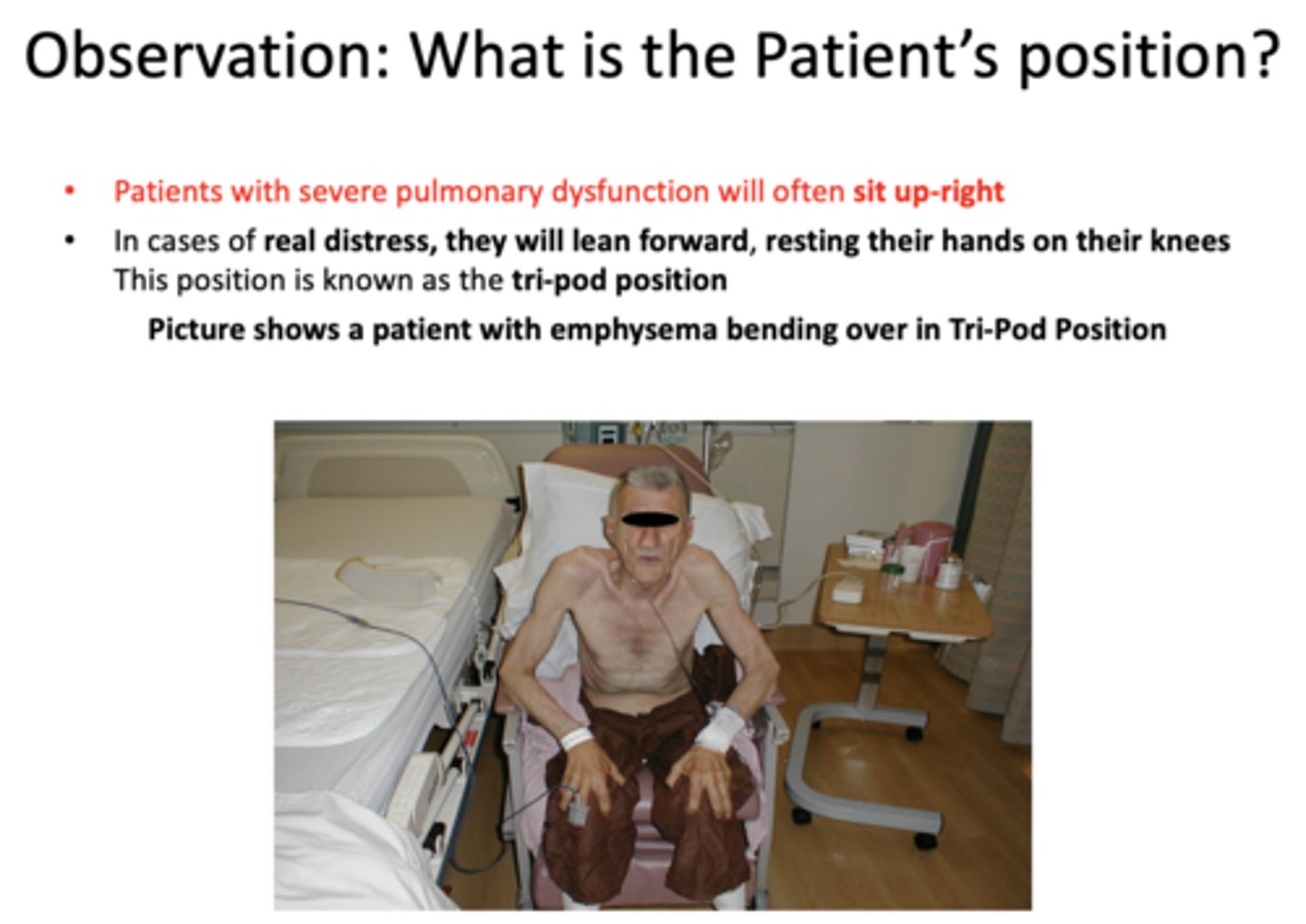
The following is inspection/observation of what?
- Very high RR &/or with labored breathing, patient is unable to speak in full sentences
- If this occurs, note how many words the patient can speak
- The fewer words per breath, the worse the problem
ability to speak
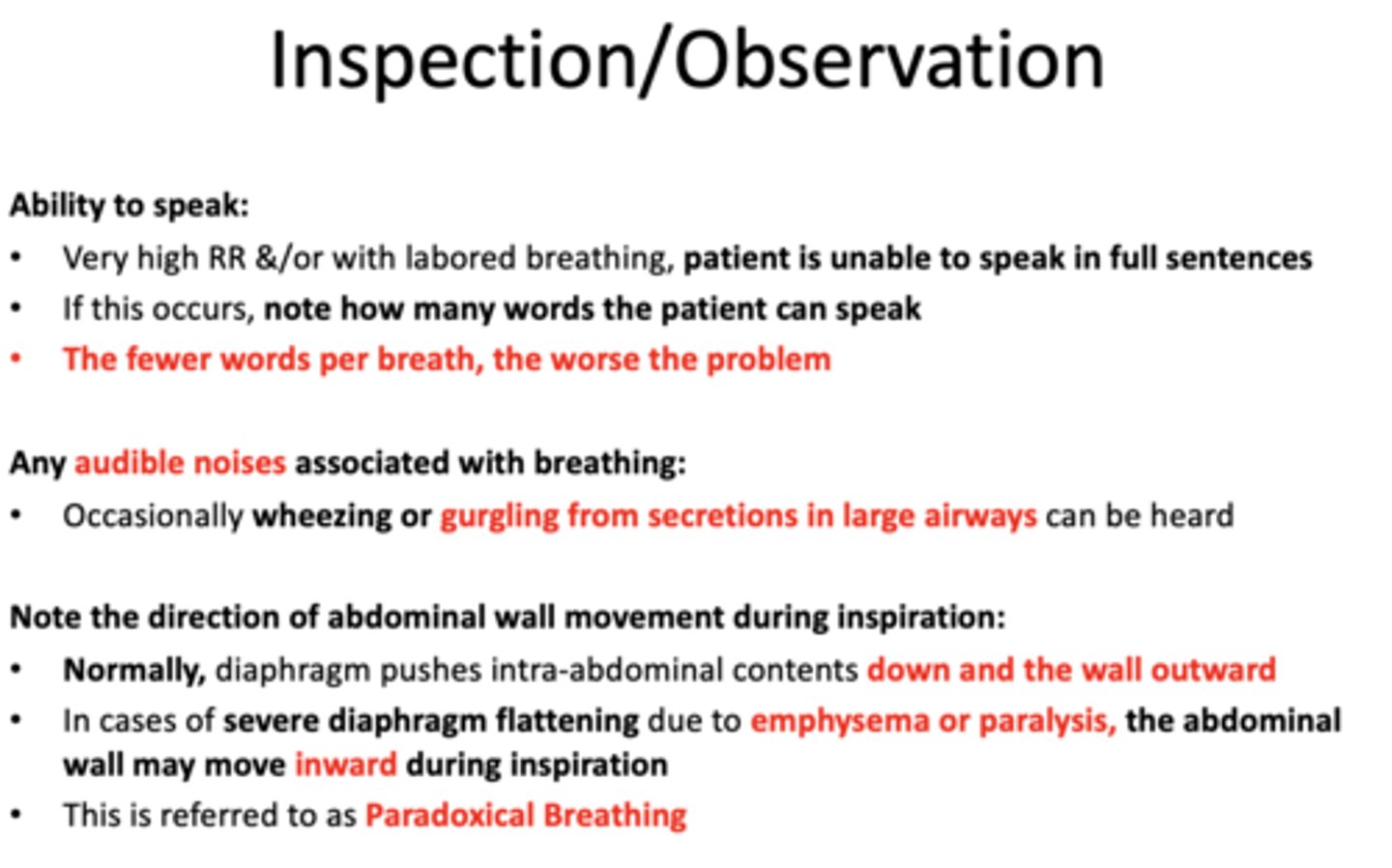
The fewer words per breath a patient is able to speak, :
the worse the problem

audible noises associated with breathing (2)
wheezing or gurgling
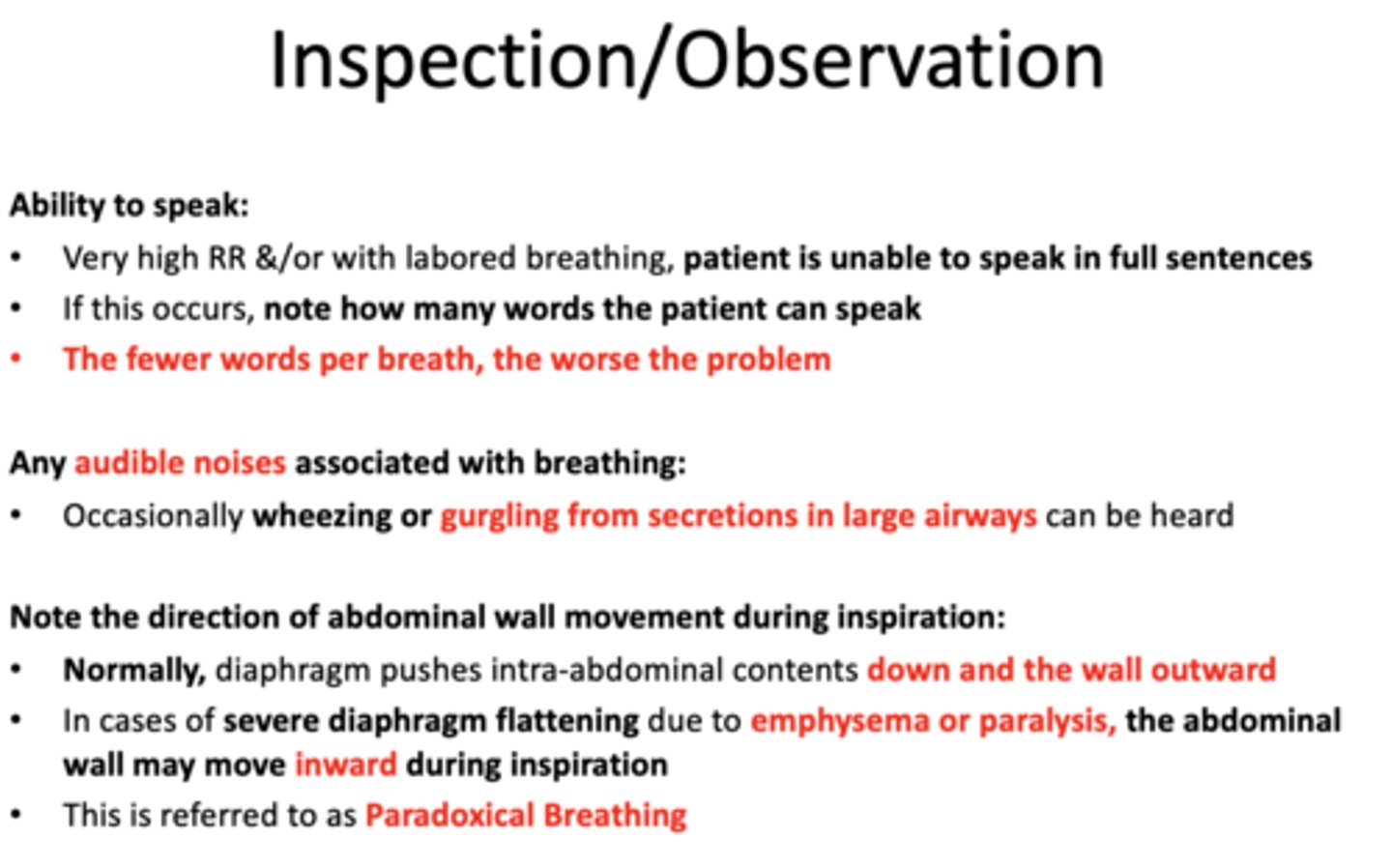
audible wheezing or gurgling can indicate:
secretions in large airways
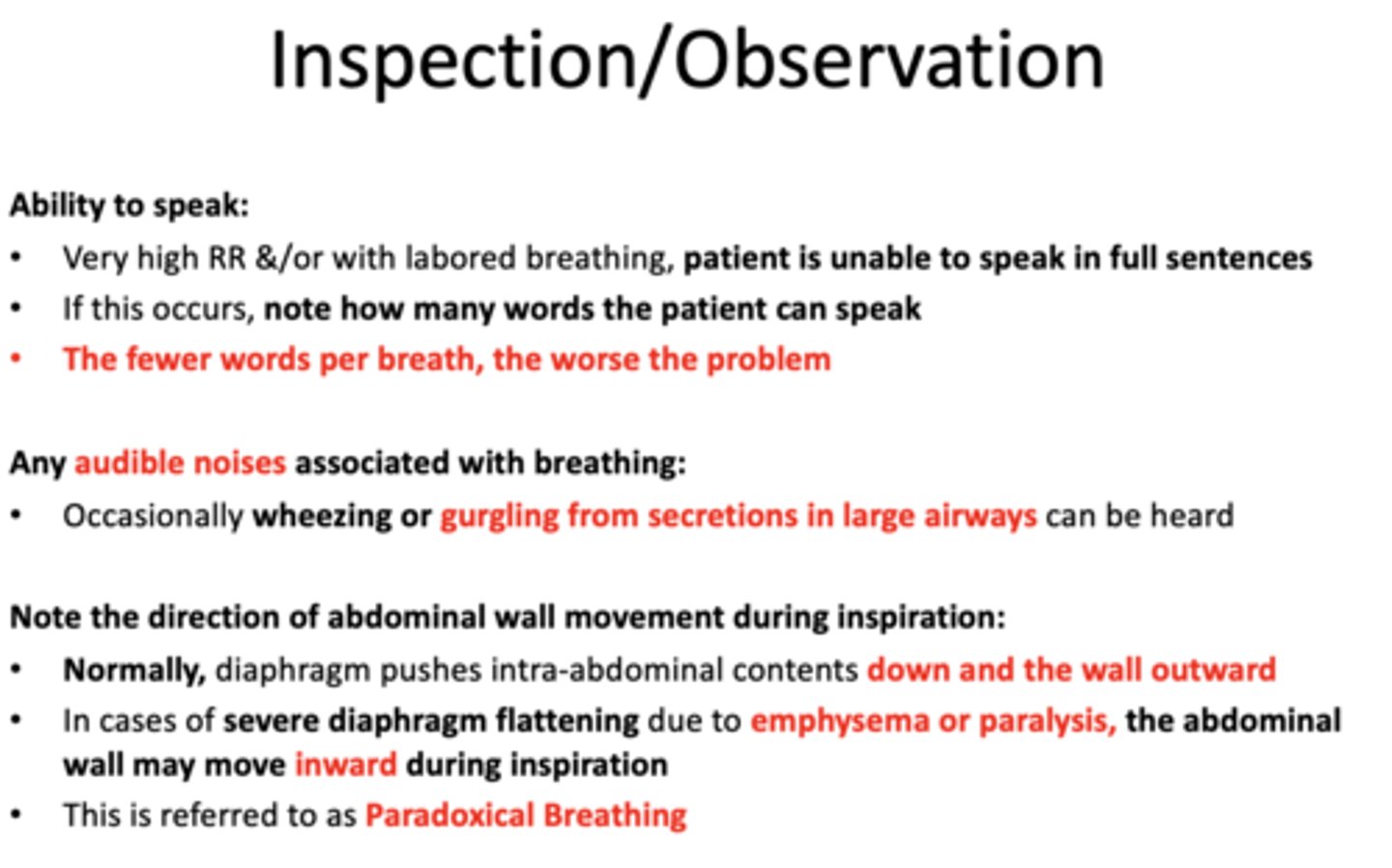
Normally during inspiration, diaphragm pushes intra-abdominal contents:
down and the wall outward
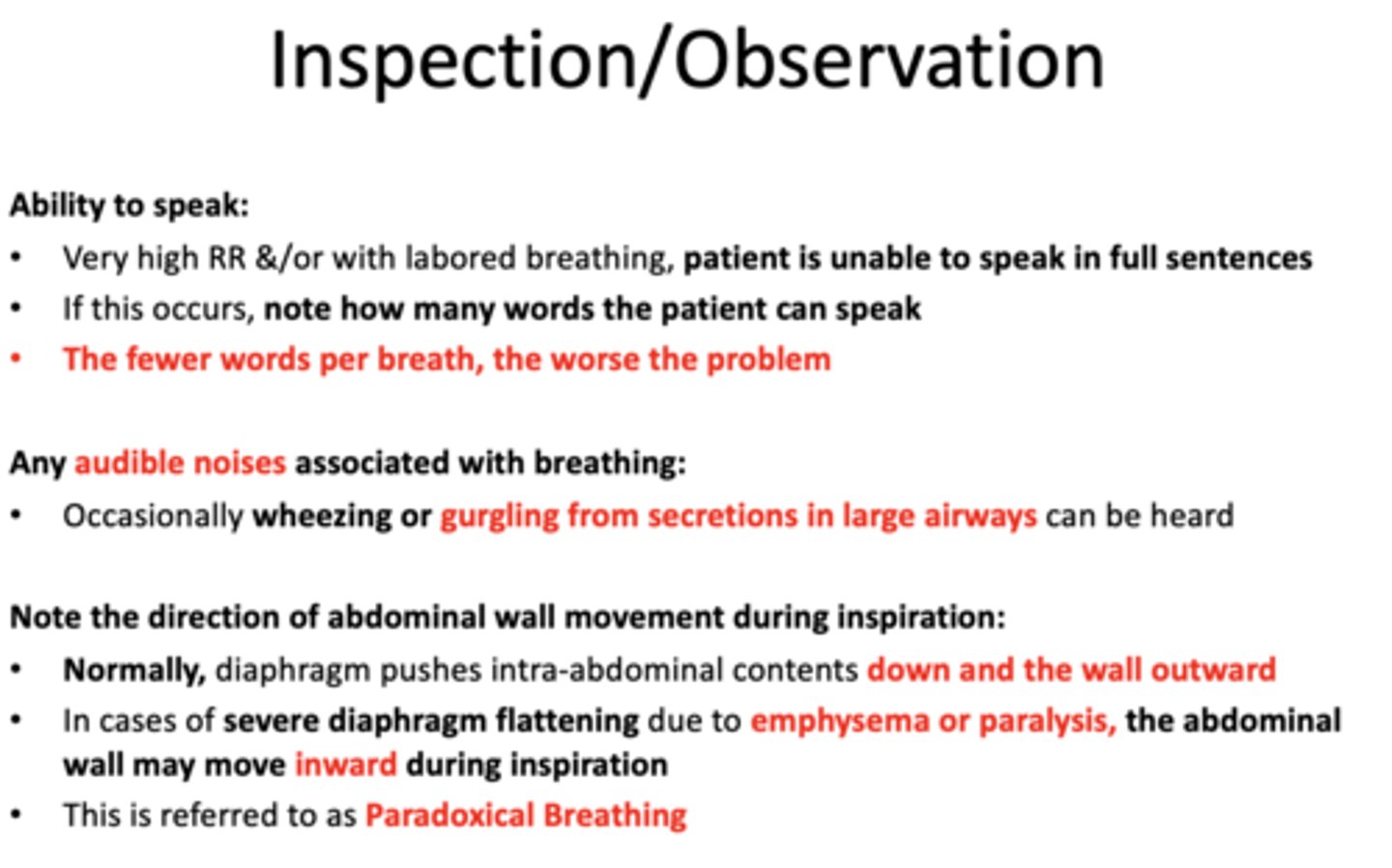
severe diaphragm flattening due to emphysema or paralysis, the abdominal wall may move _______ during inspiration
inward
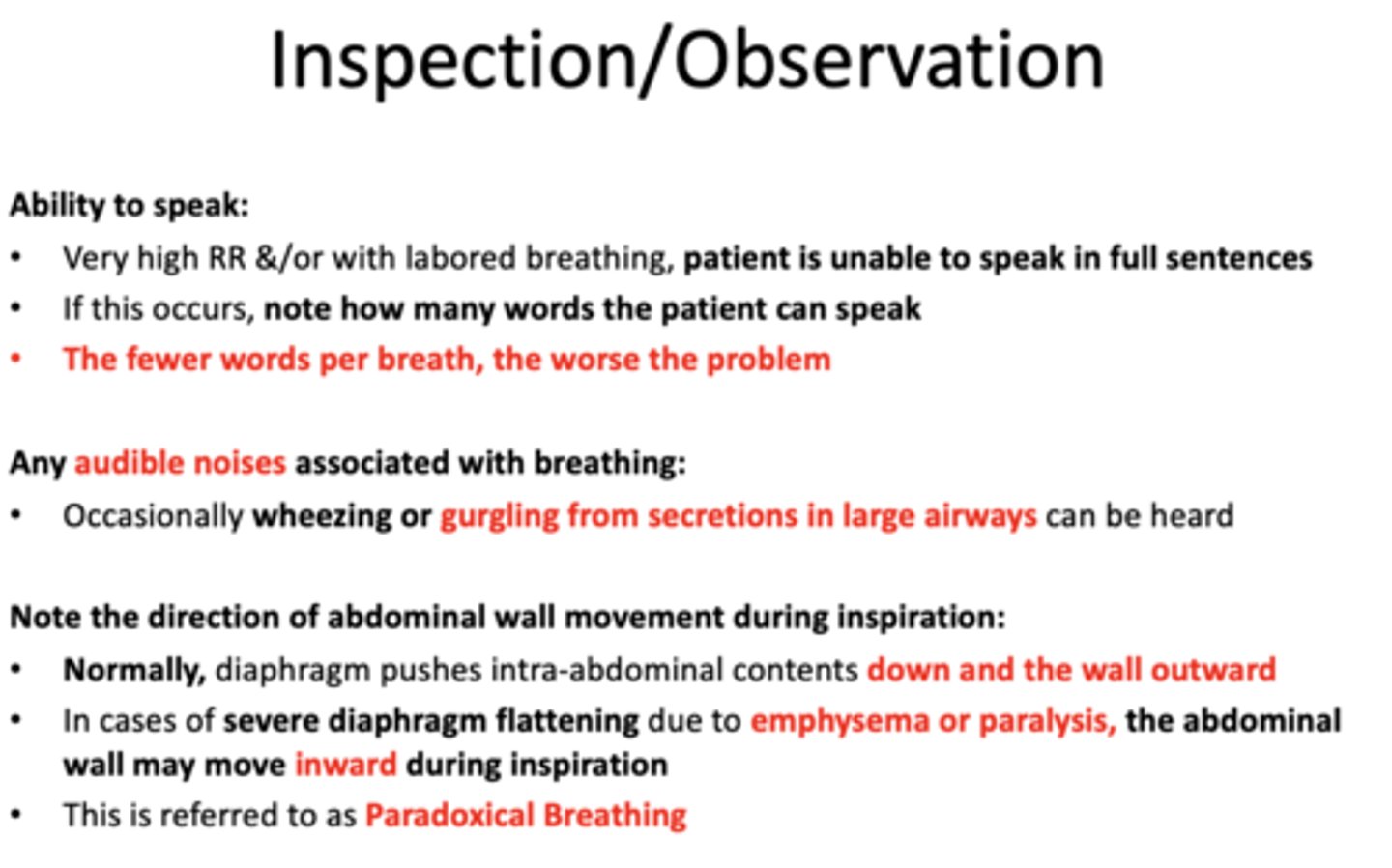
due to emphysema or paralysis, the abdominal wall may move inward during inspiration is known as ____________
Paradoxical Breathing

Chest or spine deformities can occur from what two things?
- Chronic lung disease (e.g. emphysema)
- Congenitally
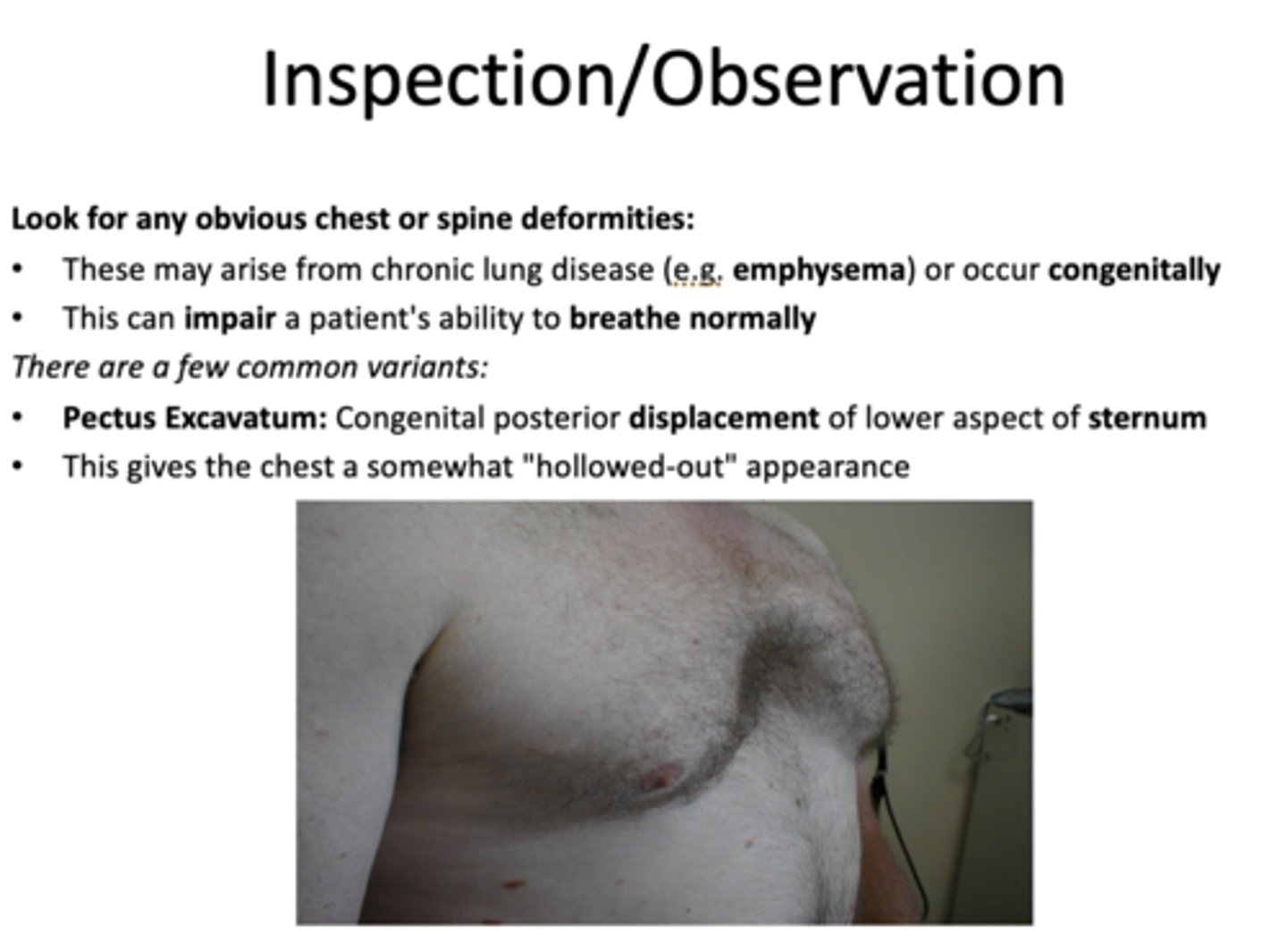
What has the following characteristics?
- Congenital posterior displacement of lower aspect of sternum
- This gives the chest a somewhat "hollowed-out" appearance
Pectus Excavatum
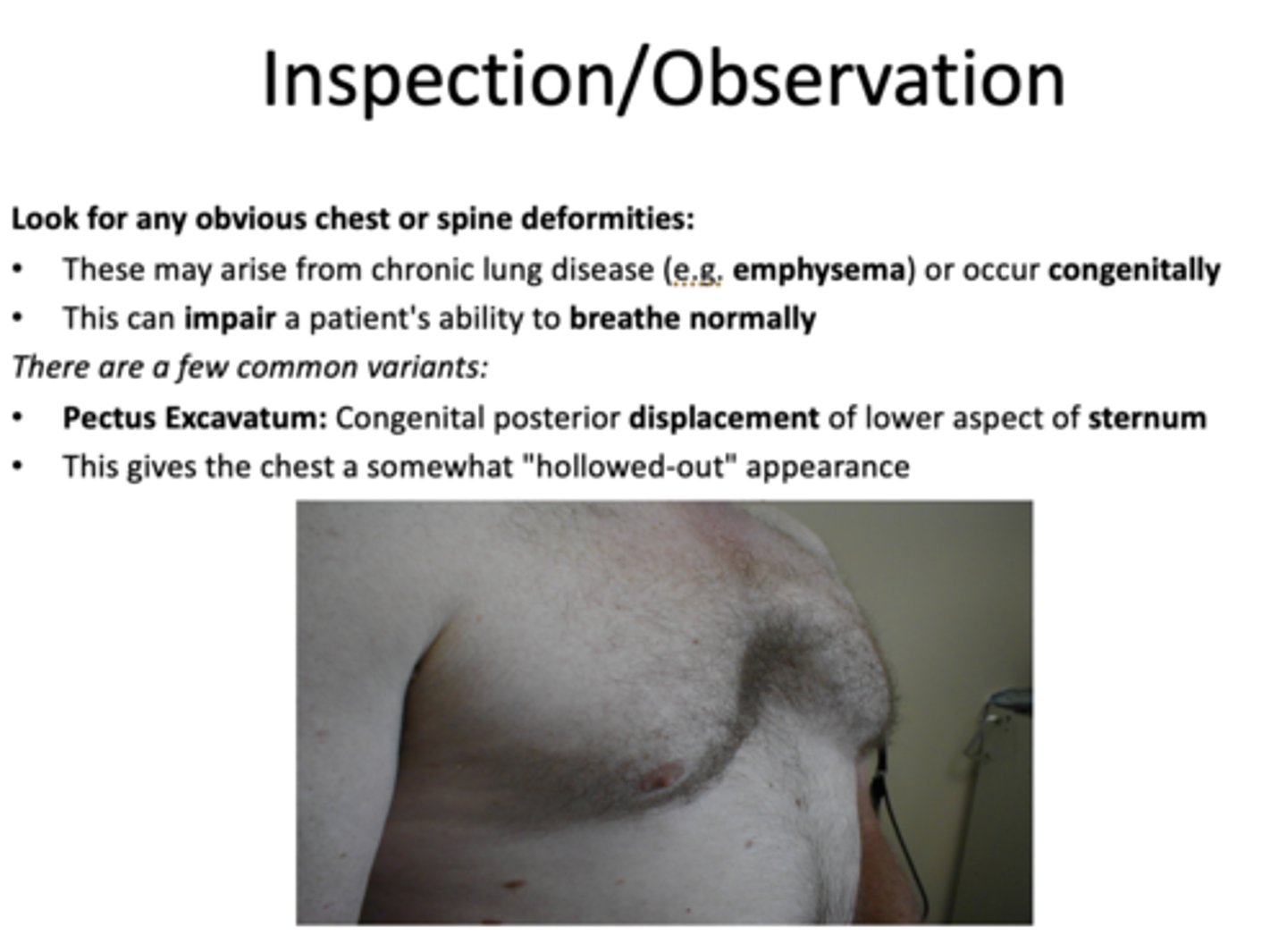
Note patient's Anterior-Posterior diameter!!!!!
Normally, shoulder-to-shoulder (STS) dimensions are always ________ than the back-to-front chest dimensions
greater
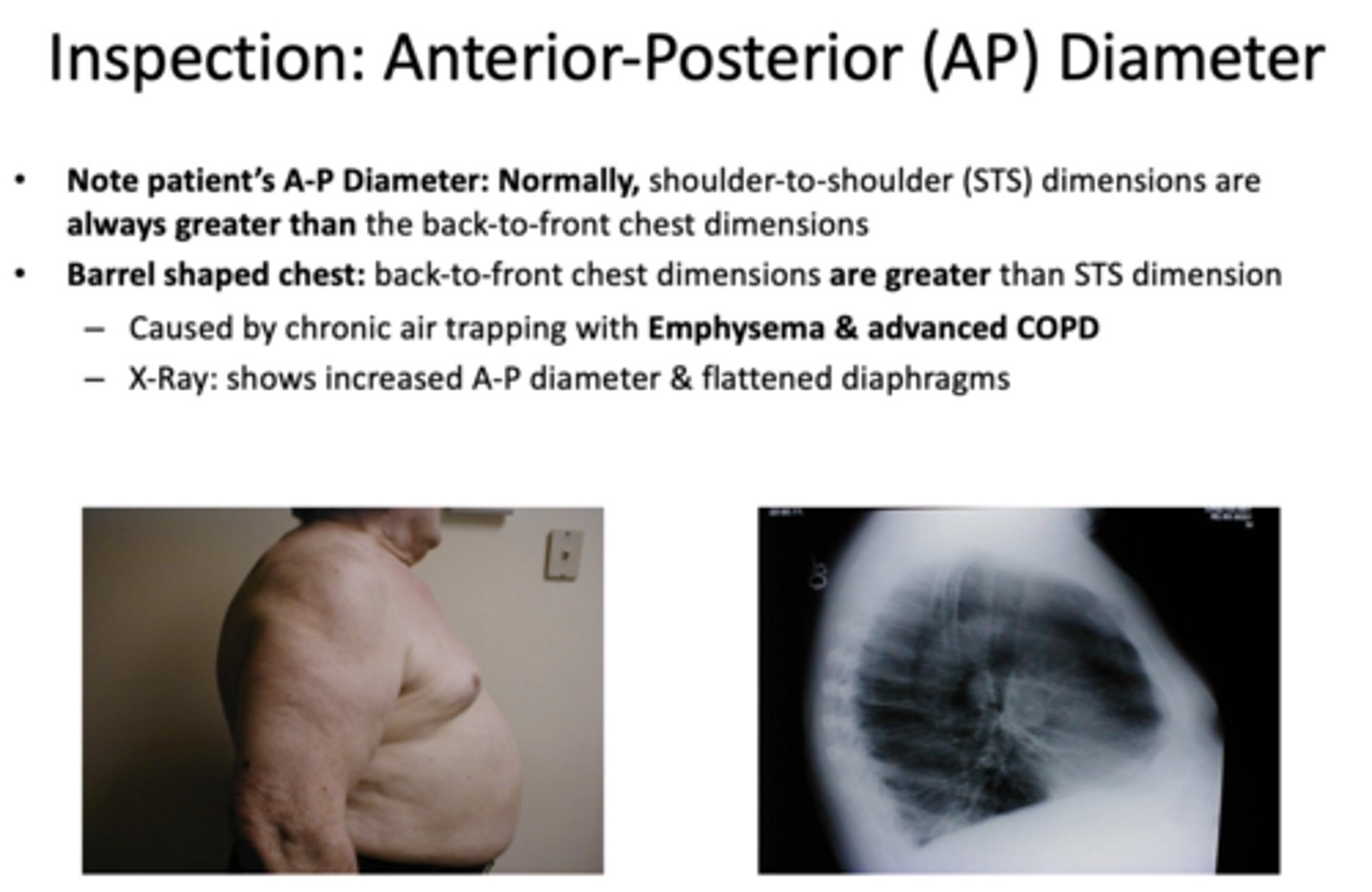
What has the following characteristics?
- Back-to-front chest dimensions are greater than STS dimension
– Caused by chronic air trapping with Emphysema & advanced COPD
Barrel shaped chest

The second rib joins the Sternum & the Trachea bifurcates at this location:
sternal angle
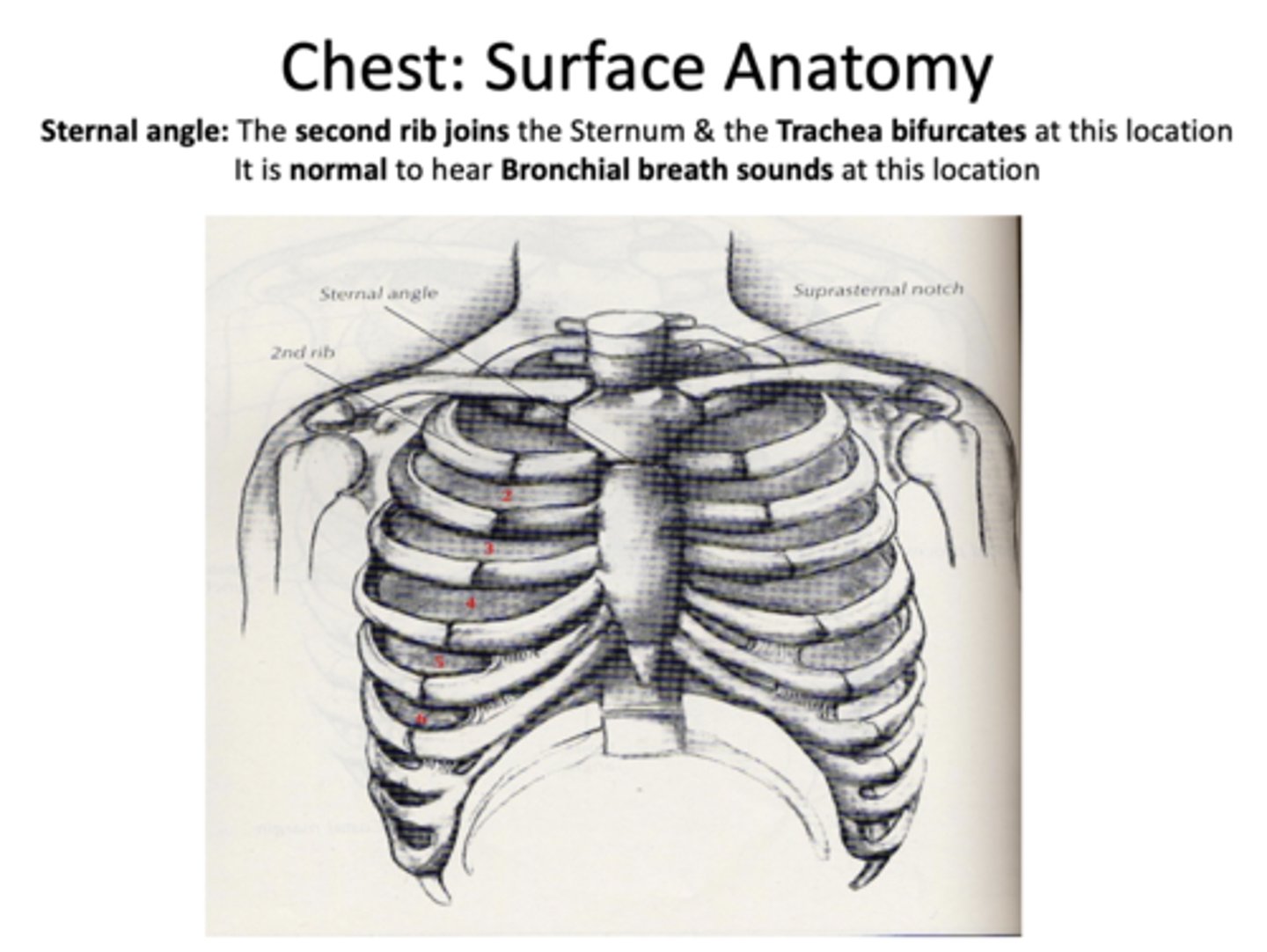
It is normal to hear Bronchial breath sounds at this location:
sternal angle

what two anatomic features occur at the sternal angle?
second rib joins the Sternum & the Trachea bifurcates
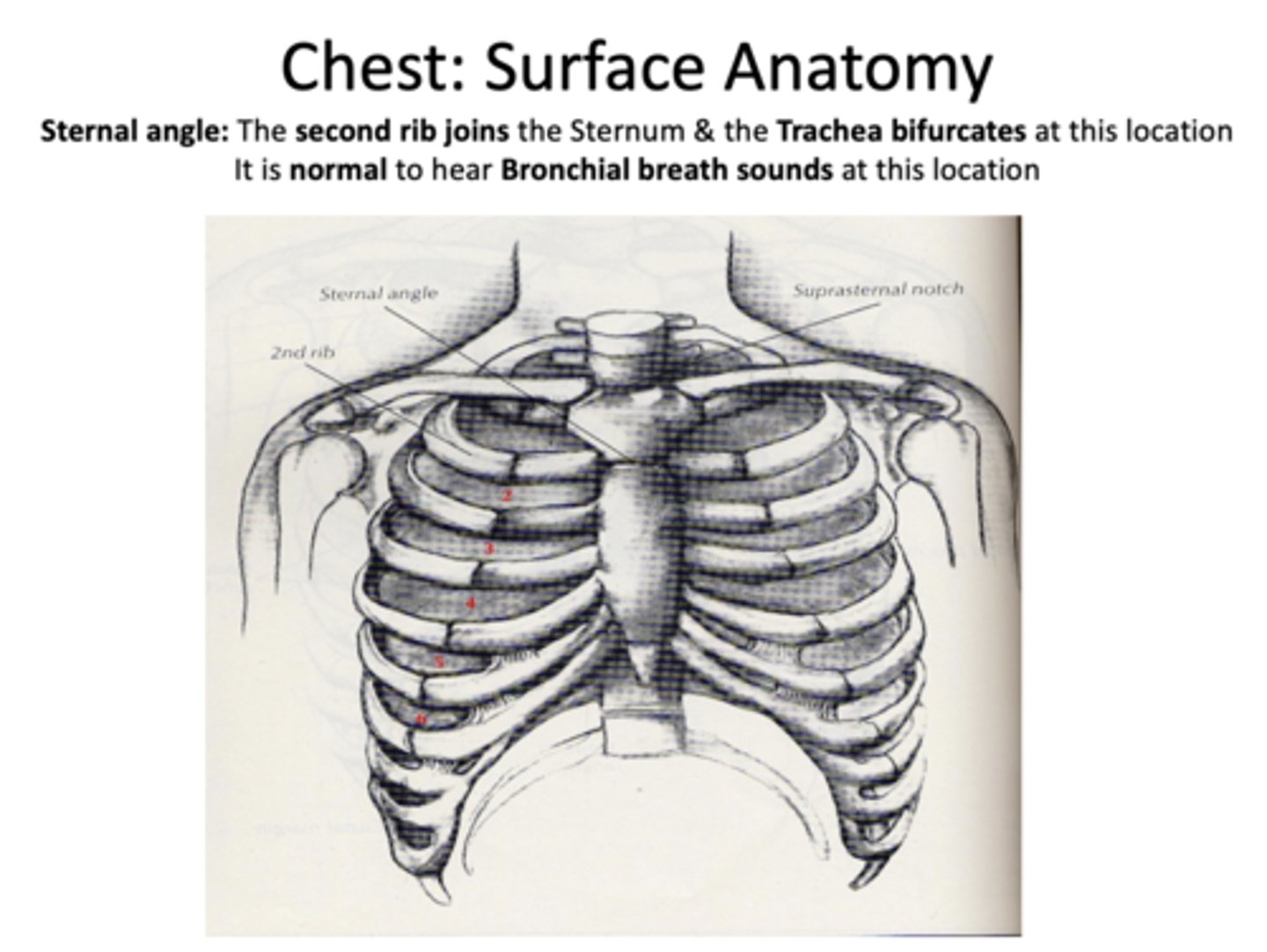
Patients with severe pulmonary dysfunction will often sit ______
up-right
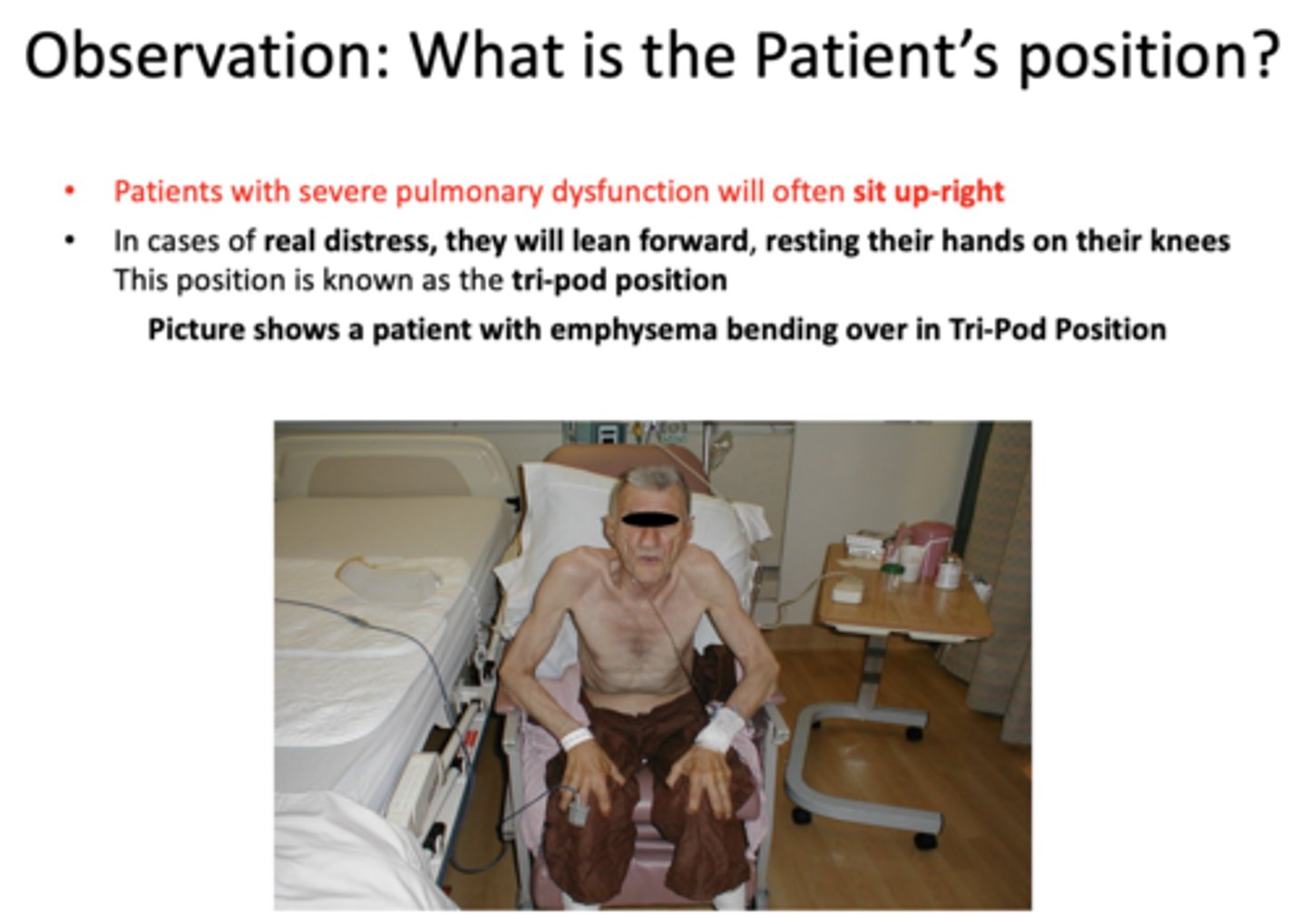
What type of assessment is this?
- Gently press & percuss on sinus to elicit tenderness/swelling
- Apply GENTLE pressure above & below the medial end of the eyebrows
sinus palpatation

For sinus palpation, where do you test for Frontal sinuses?
press above eyebrows
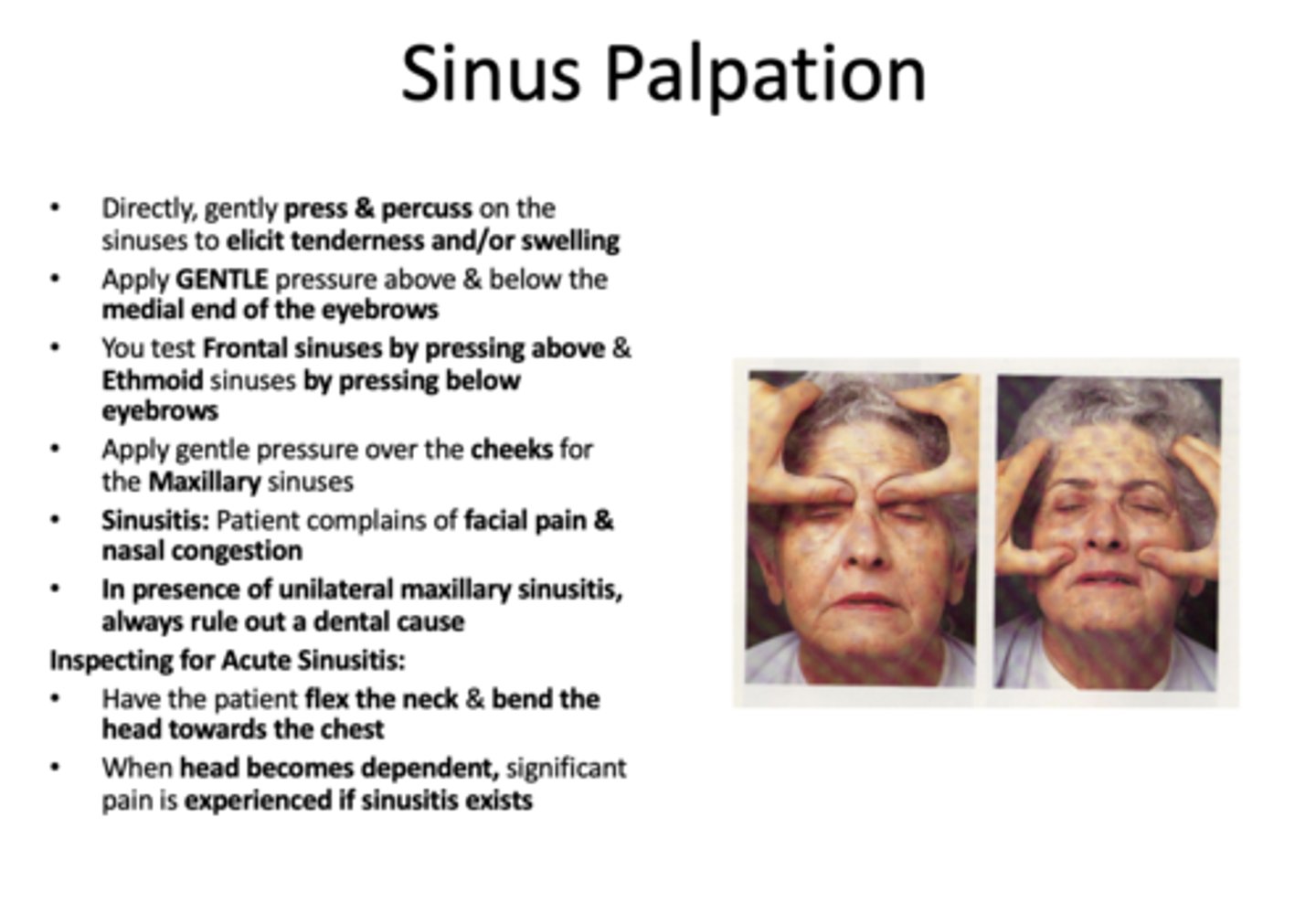
For sinus palpation, where do you test for Ethmoid sinuses?
press below eyebrows
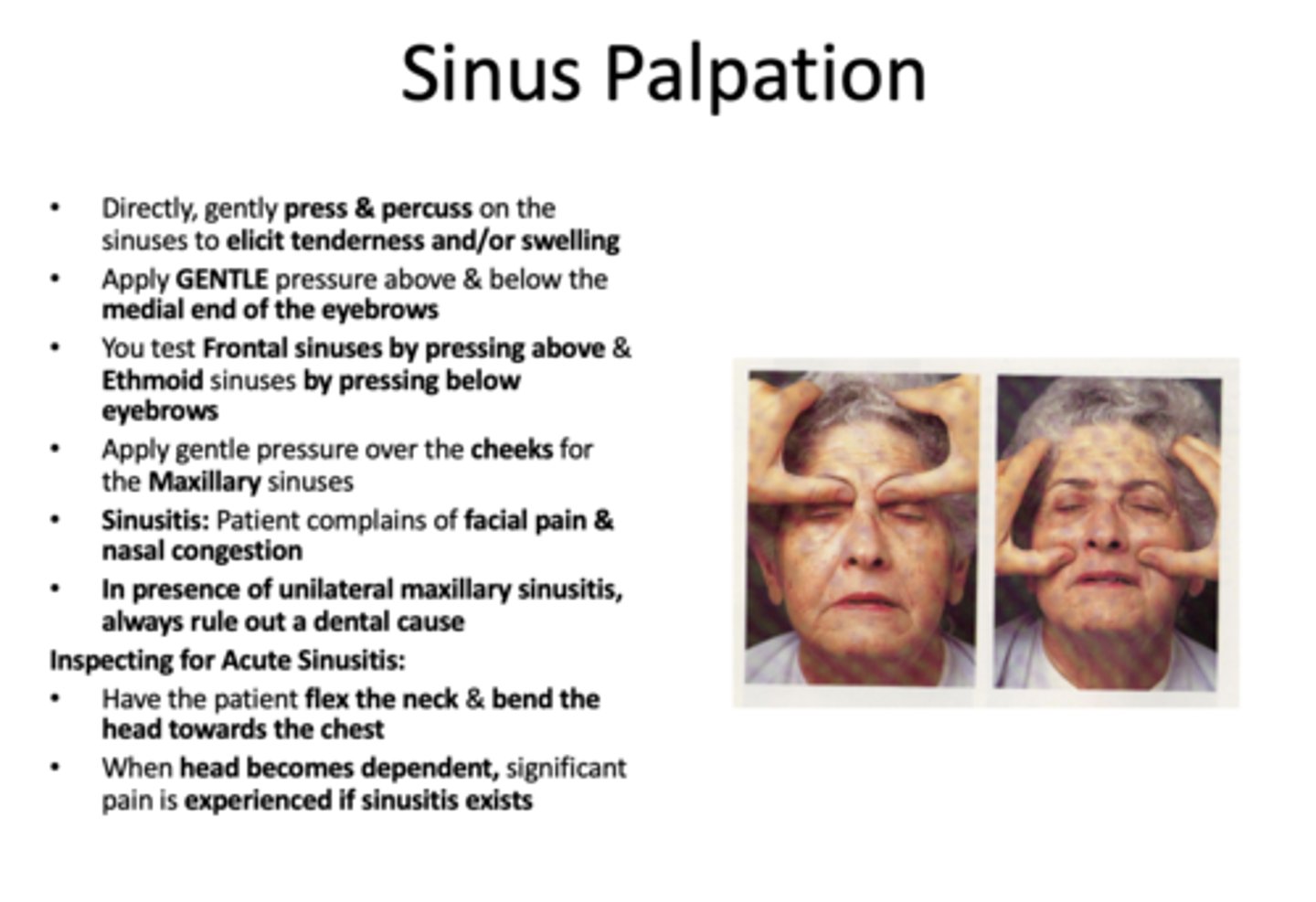
For sinus palpation, where do you test for Maxillary sinuses?
pressure over cheeks
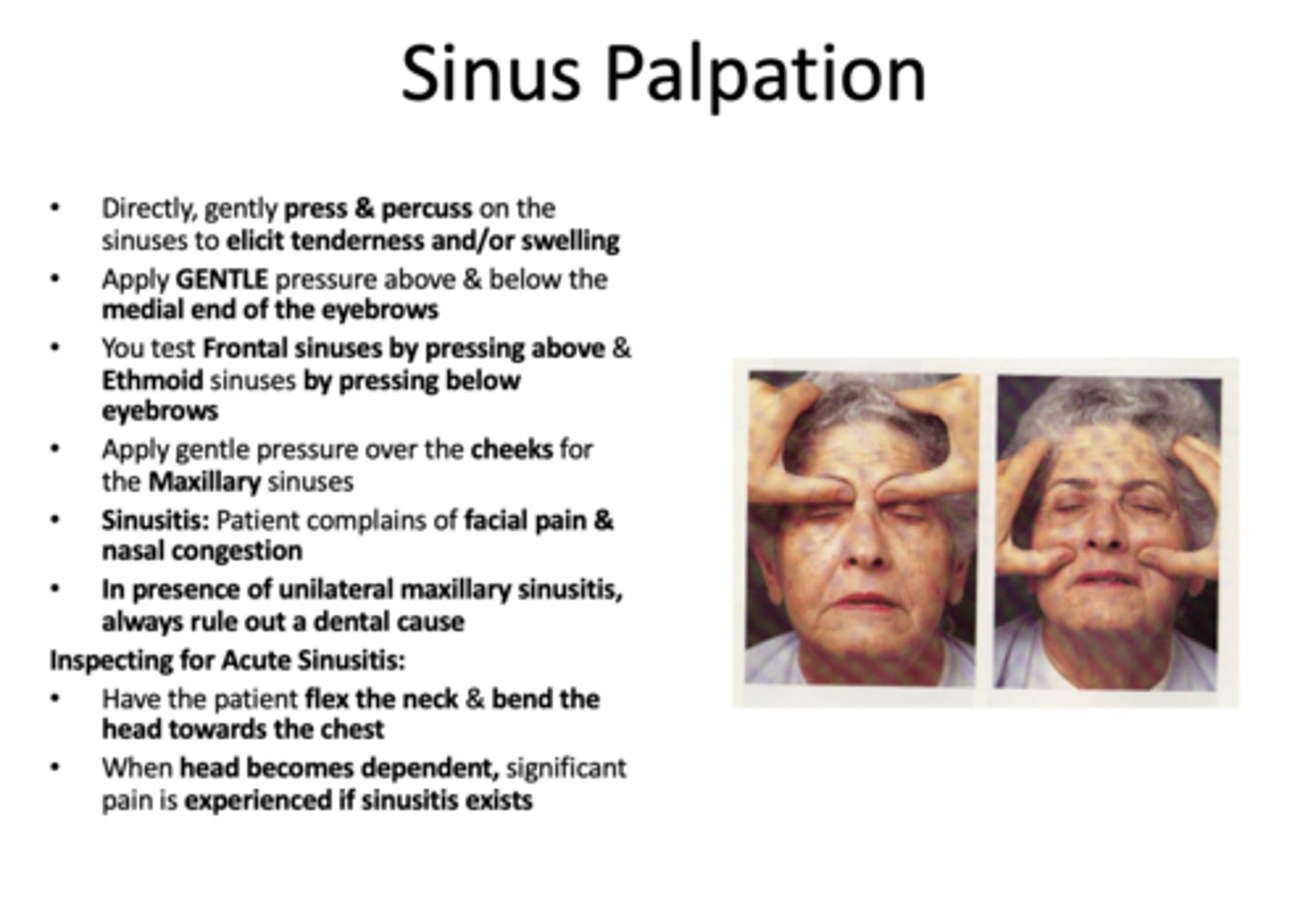
In sinusitis, patients complain of (2)
- Facial pain
- Nasal congestion

In presence of unilateral maxillary sinusitis, always rule out:
dental cause
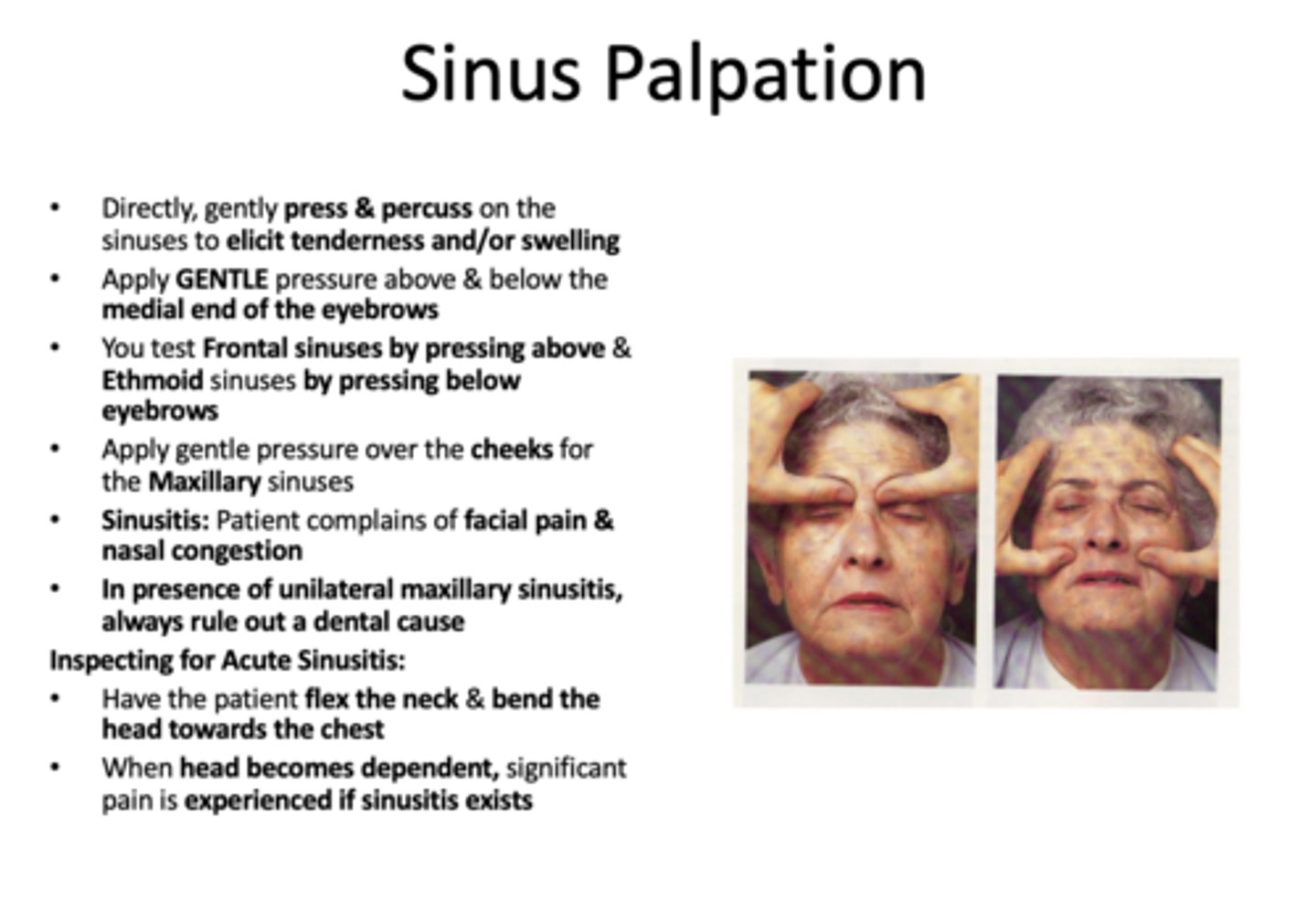
-Have the patient flex the neck & bend head towards the chest
-When head becomes dependent, significant pain is experienced if ______ exists
acute sinusitis
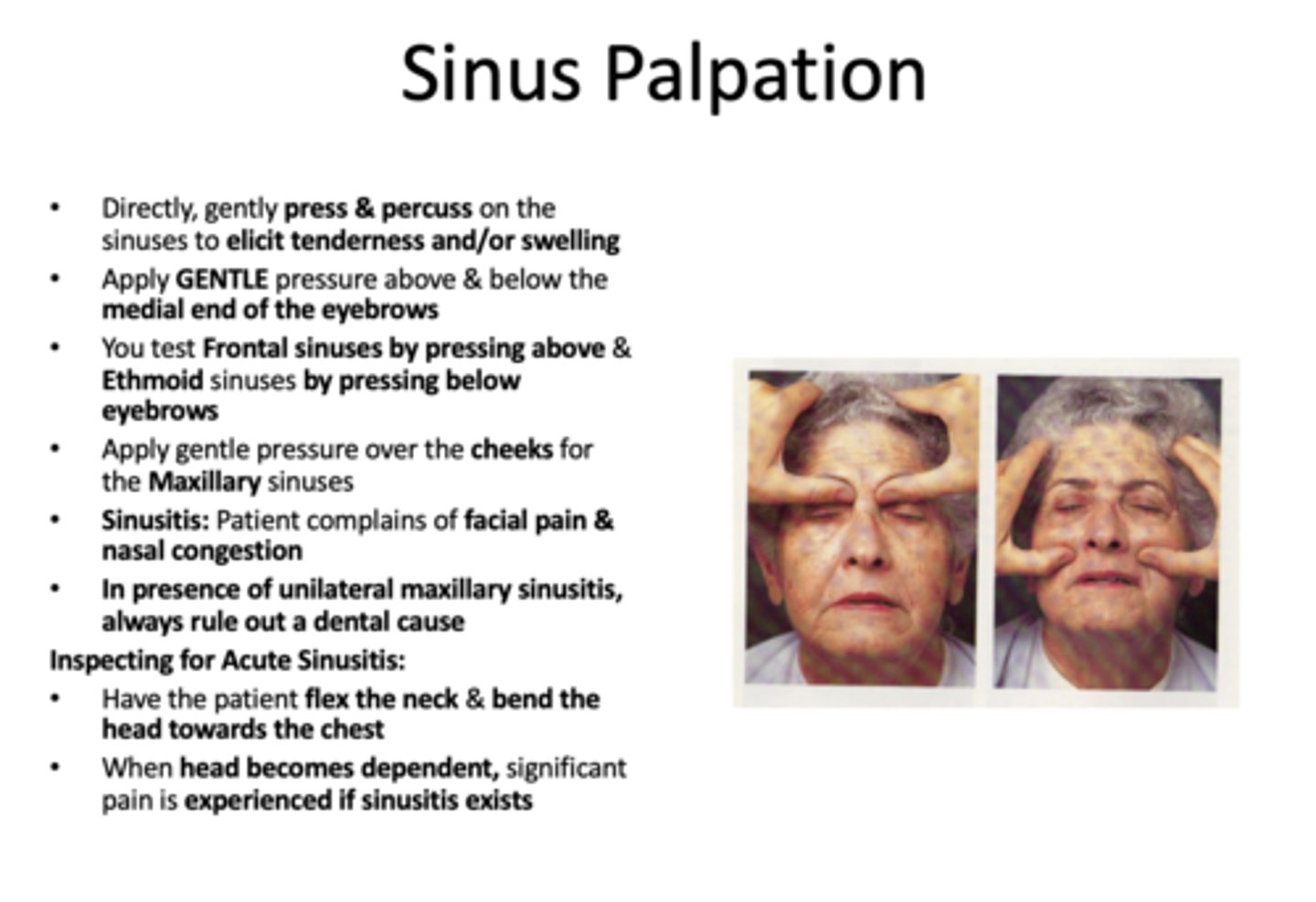
how do you inspect for acute sinusitis?
have patient flex the neck & bend the head towards the chest
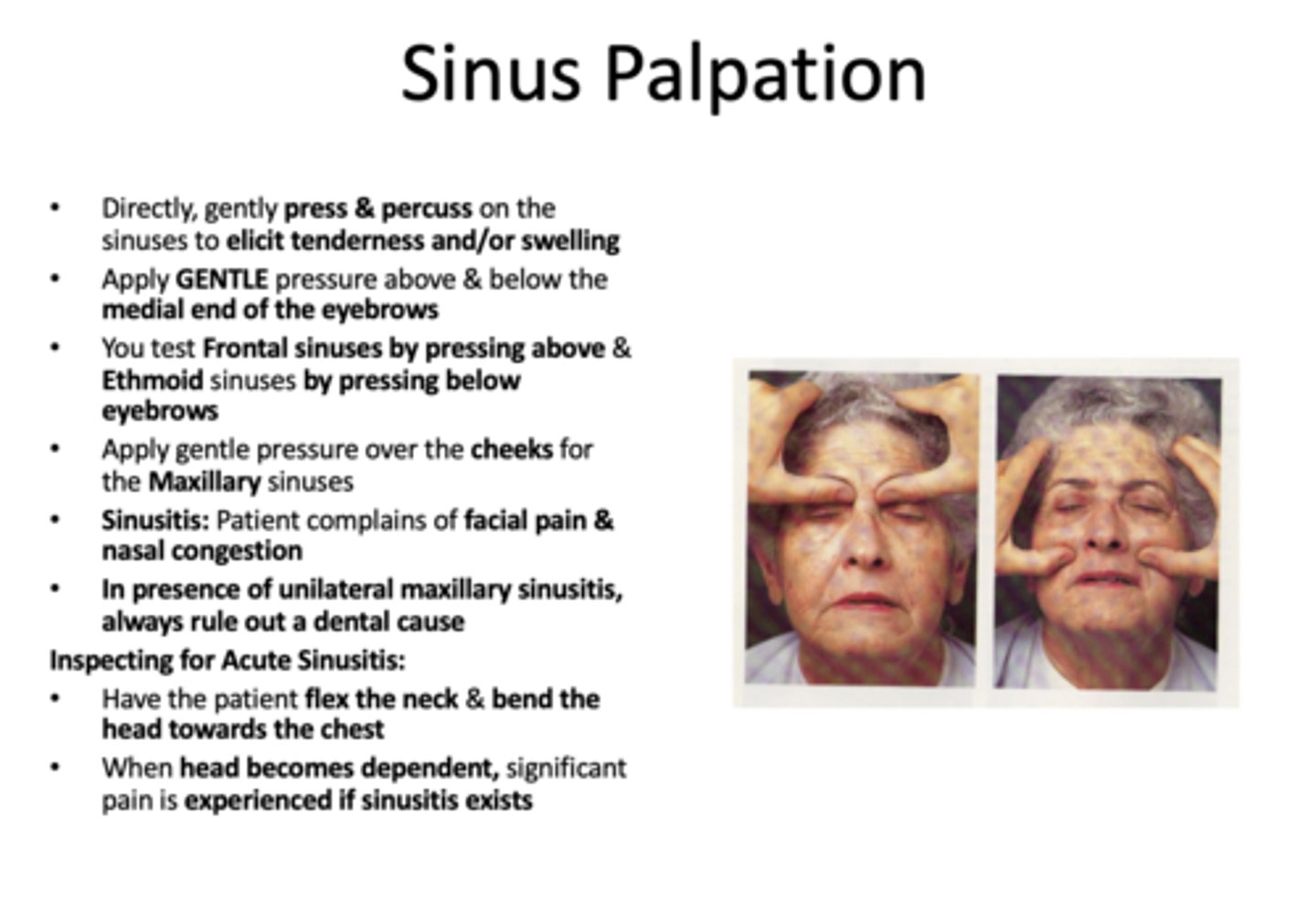
positive sign for sinusitis:
significant pain is experienced when neck is flexed and head bent towards chest
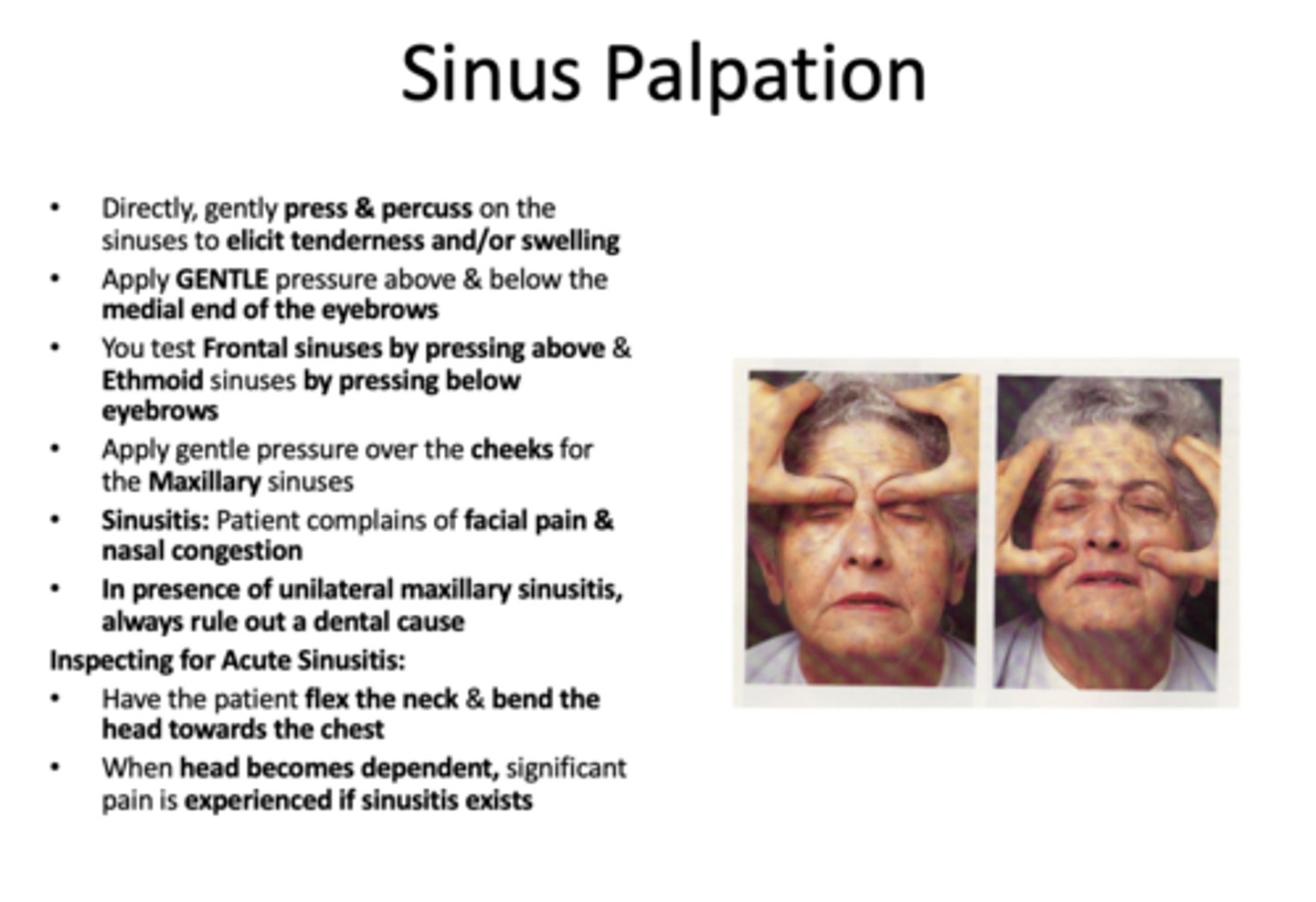
Dim the room lights & place a lighted flashlight on the face just below the eye. If the light is not seen on the roof of the oral mucosa it indicates...
inflamed maxillary sinuses

you tap on teeth around the maxillary sinus and it elicits pain/discomfort. This is indicative of...
inflamed maxillary sinuses
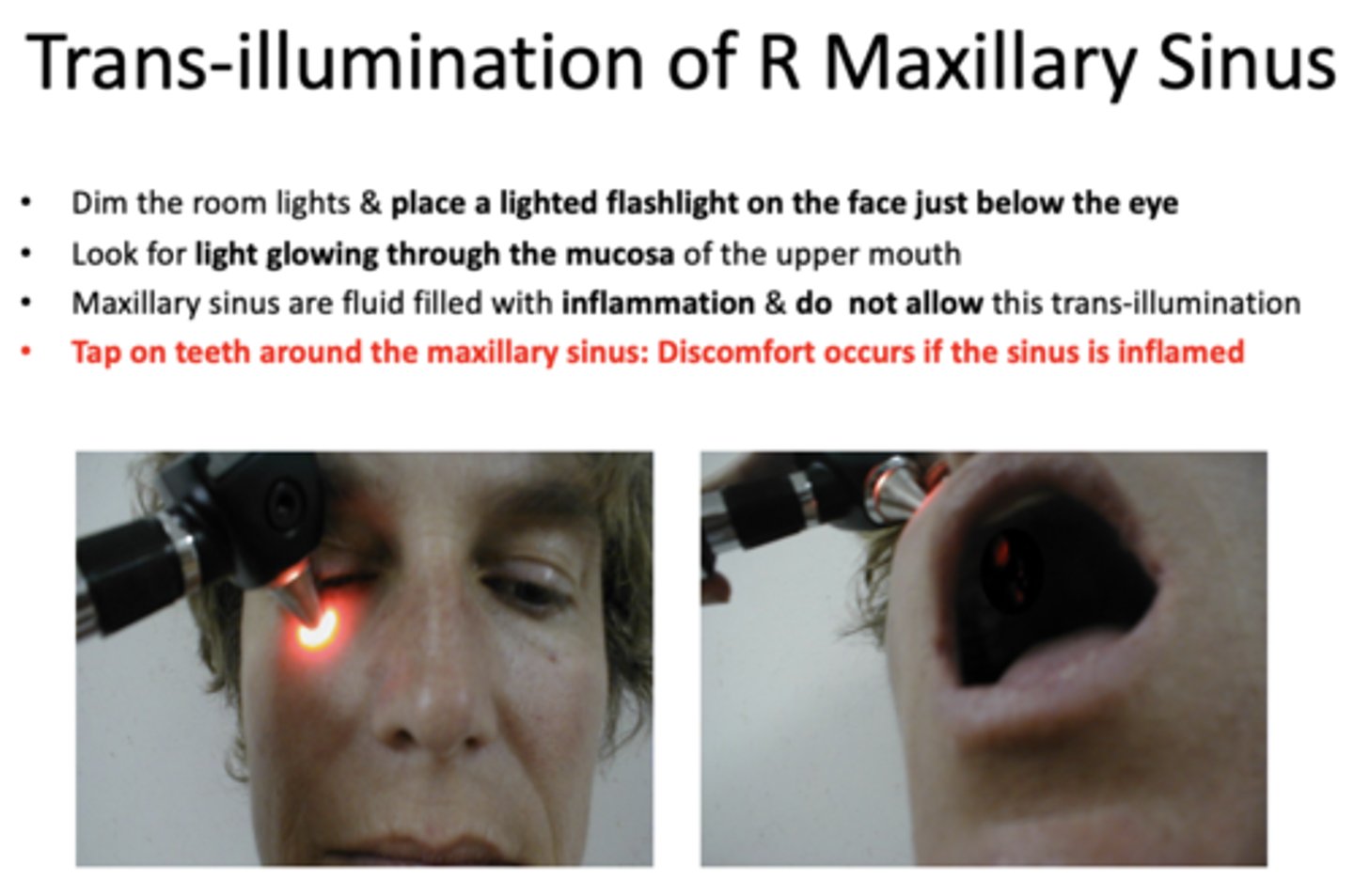
What type of assessment is this?
- Locate the Sternal notch and (SCM) muscle•
- Feel the space between trachea & SCM muscle: Space must be equal on both sides
- Confirms normal mid-line location of the Trachea
trachea palpation
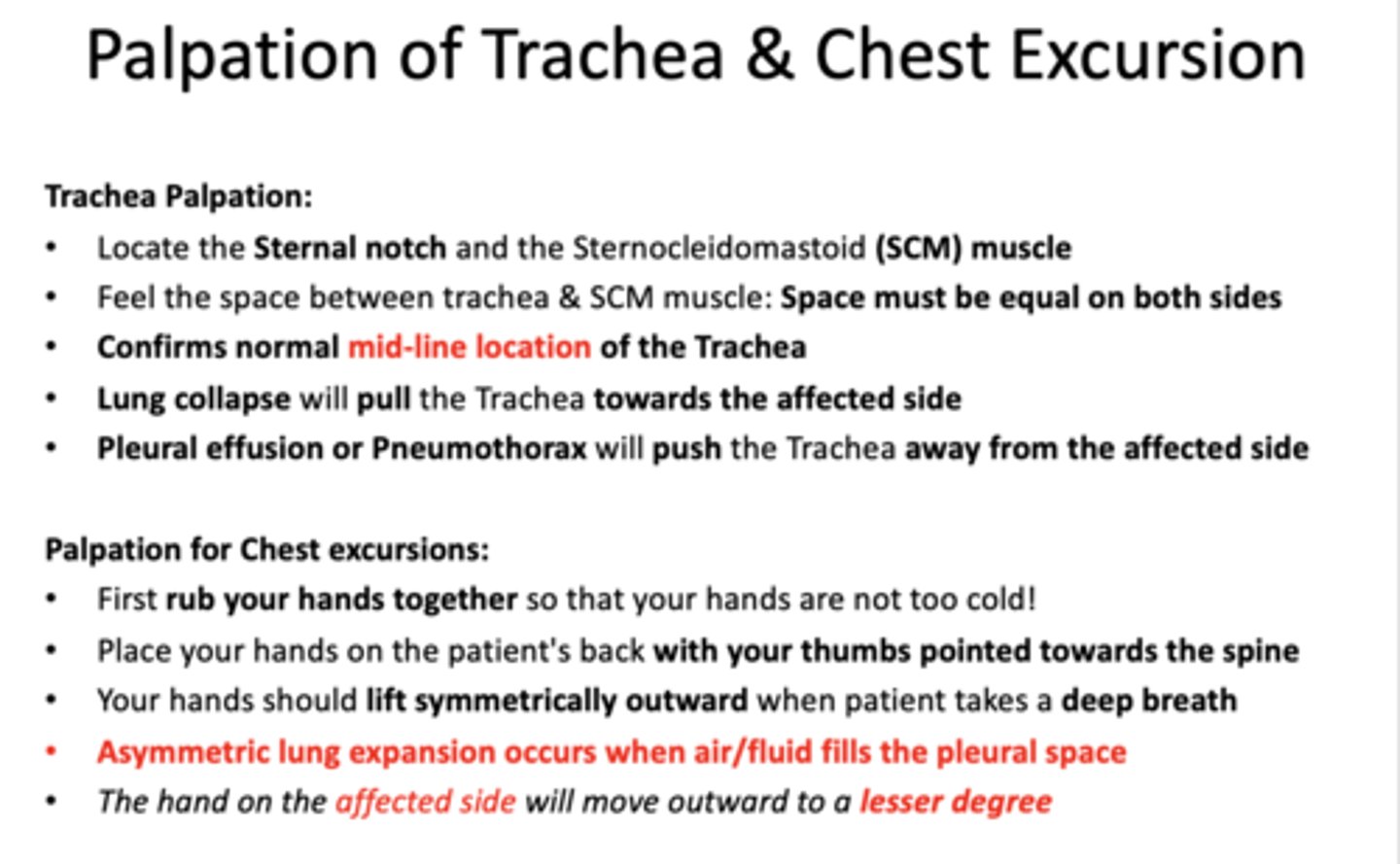
Pleural effusion or Pneumothorax will push the Trachea....
away from affected side
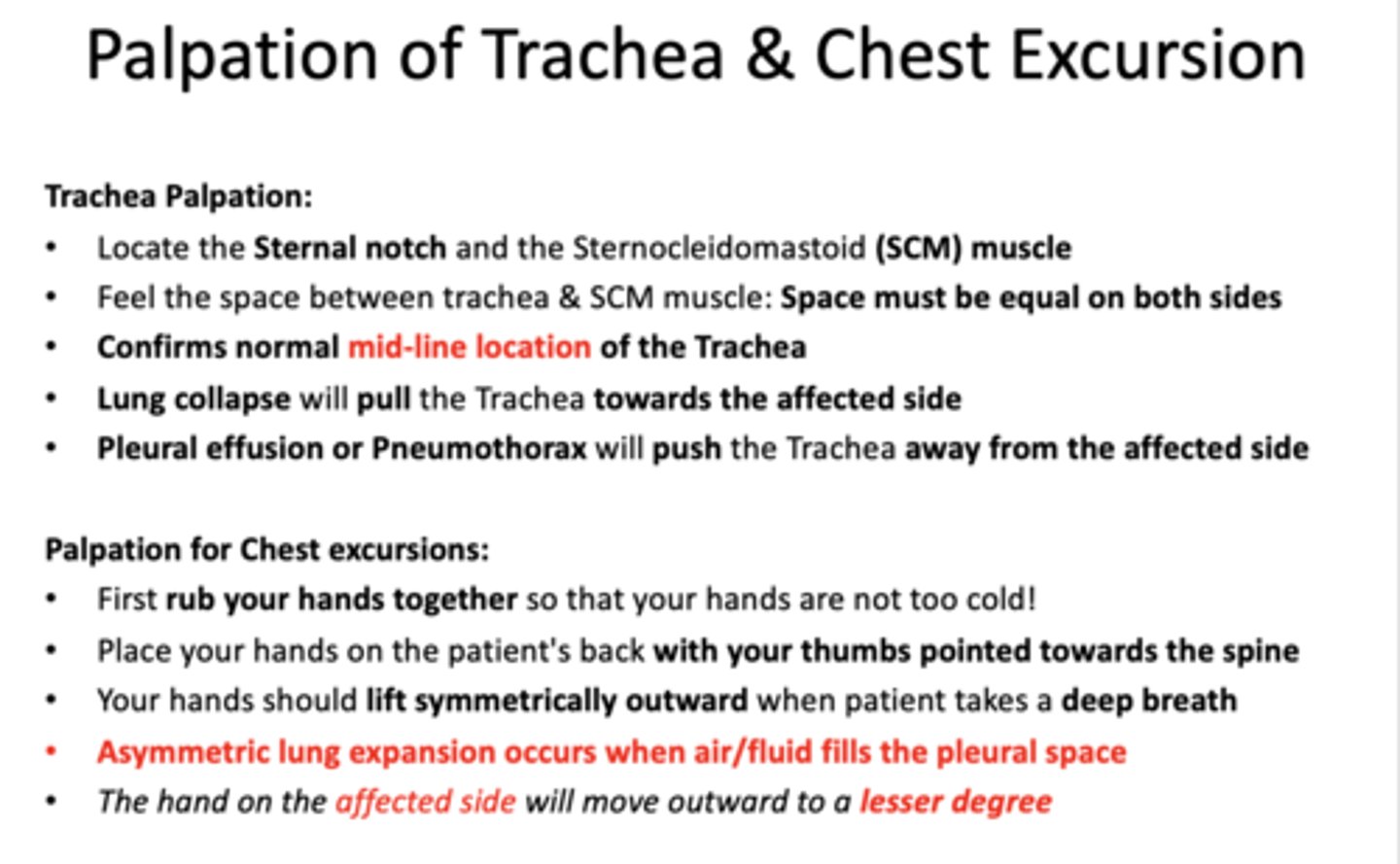
Lung collapse will pull trachea towards the
affected side

during a trachea palpation, the trachea deviates to the left during aspiration. An x-ray confirms that the left side is affected. What is the diagnosis?
lung collapse
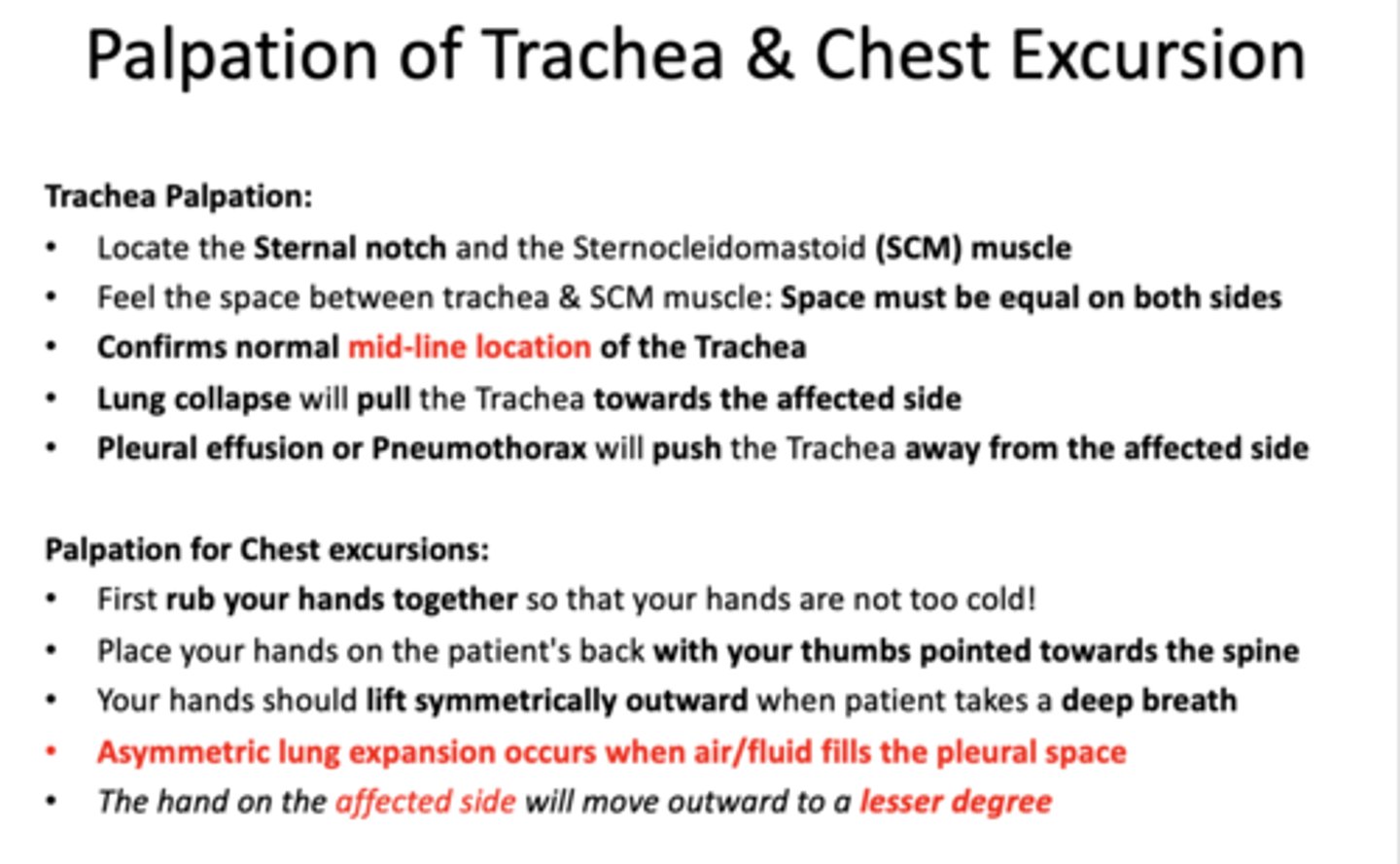
during a trachea palpation, the trachea deviates to the left during aspiration. An x-ray confirms that the right side is affected. What is the diagnosis?
Pleural effusion or Pneumothorax
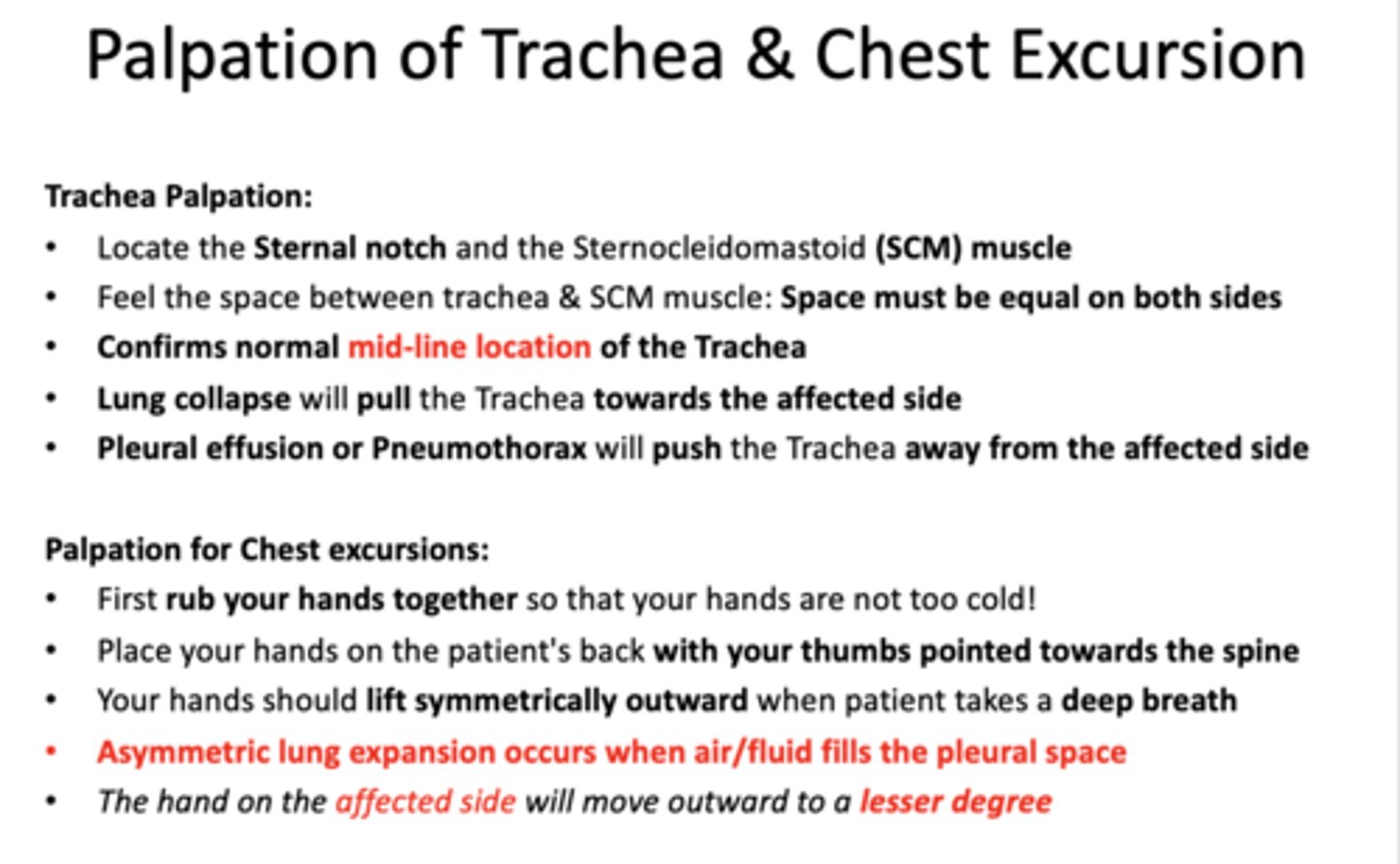
What type of assessment is this?
- First rub your hands together so that your hands are not too cold!
- Place your hands on the patient's back with your thumbs pointed towards the spine
- Your hands should lift symmetrically outward when patient takes a deep breath
palpation for chest excursions
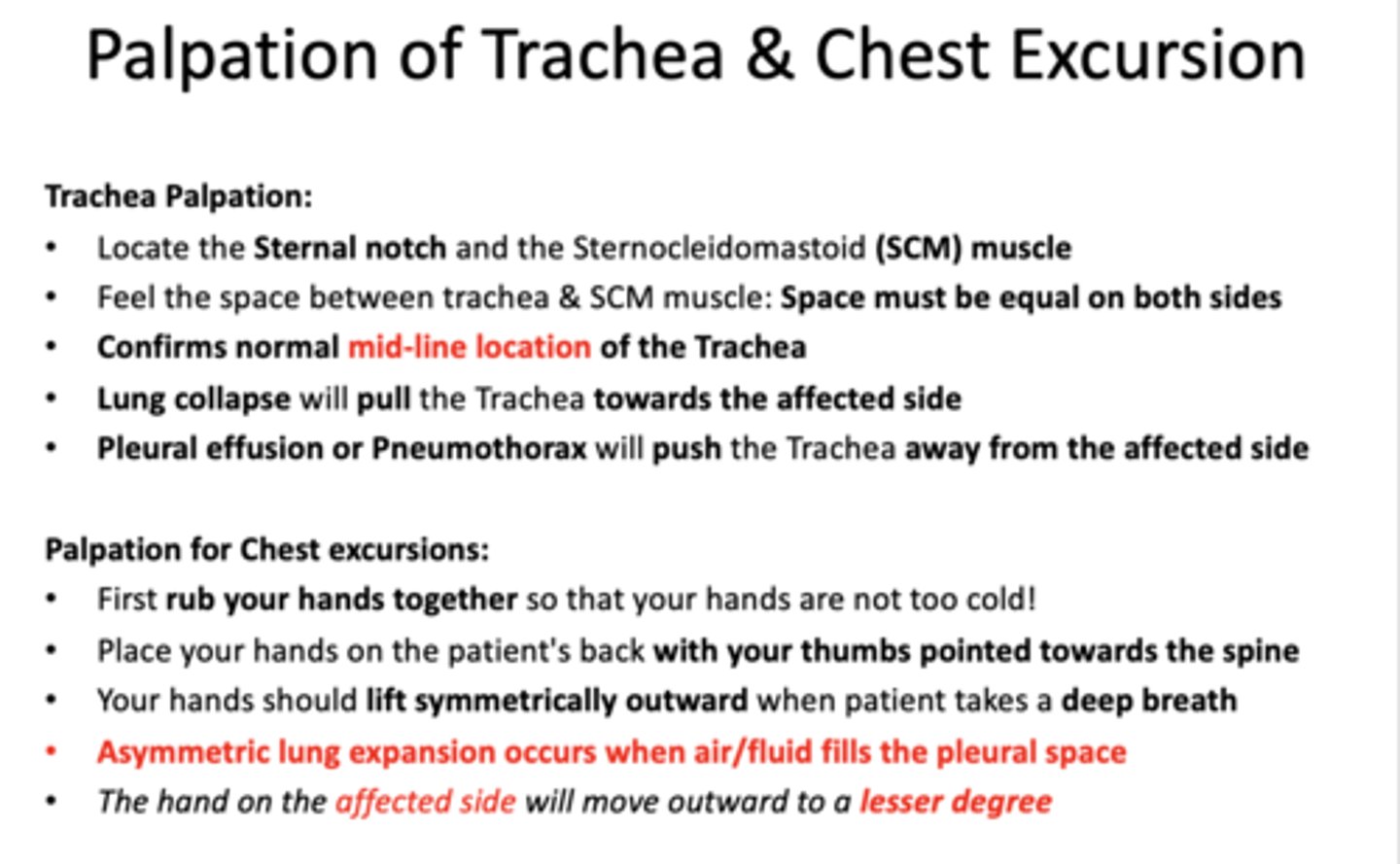
- Asymmetric lung expansion occurs when air/fluid fills the pleural space
- The hand on the affected side will move outward to a ______
lesser degree
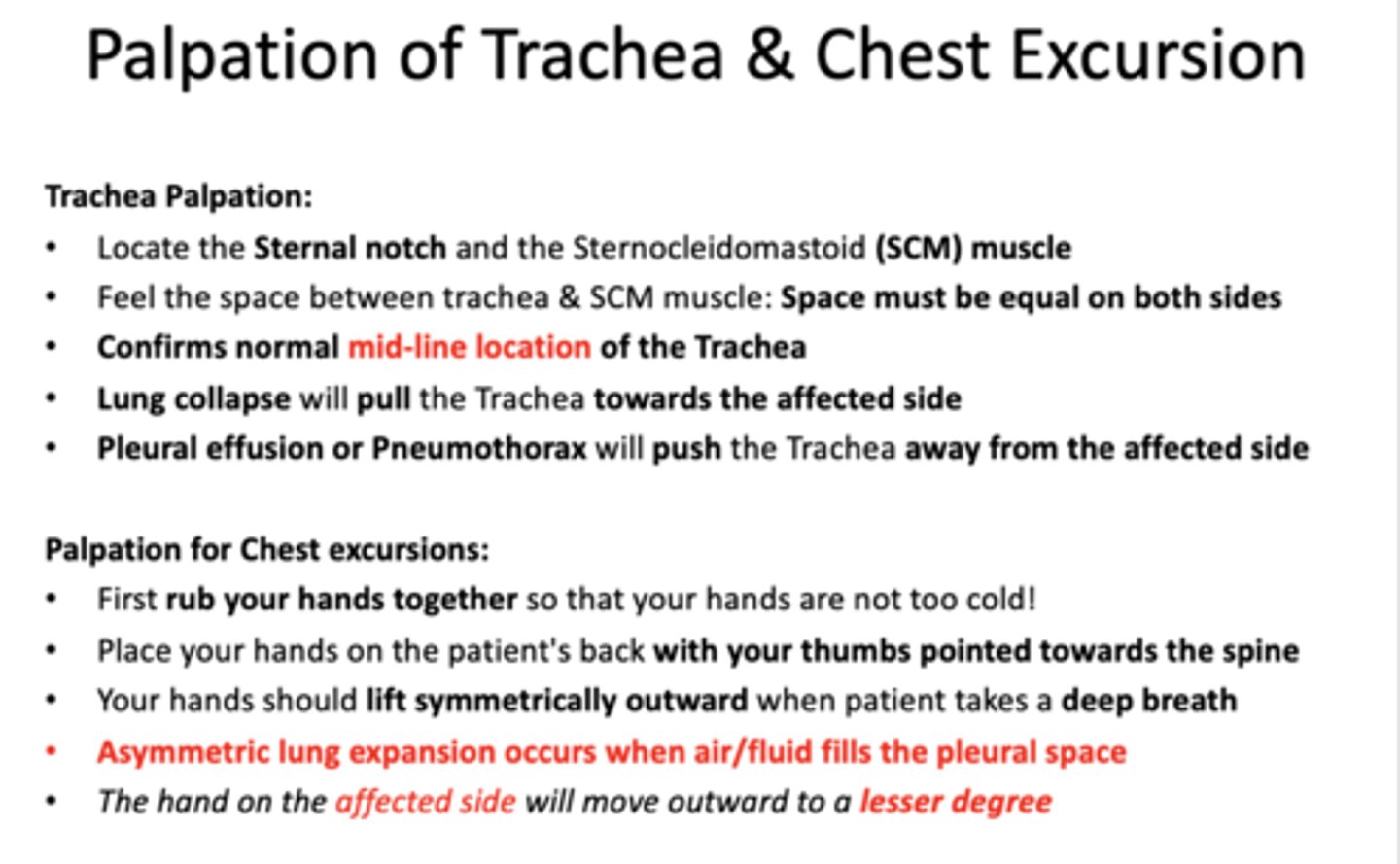
How do you palpate the apex of the lungs?
- Place your palms on the patients shoulders
- Press down firmly & ask the patient to breath deeply
- Note if the apex of both lungs rise up equally
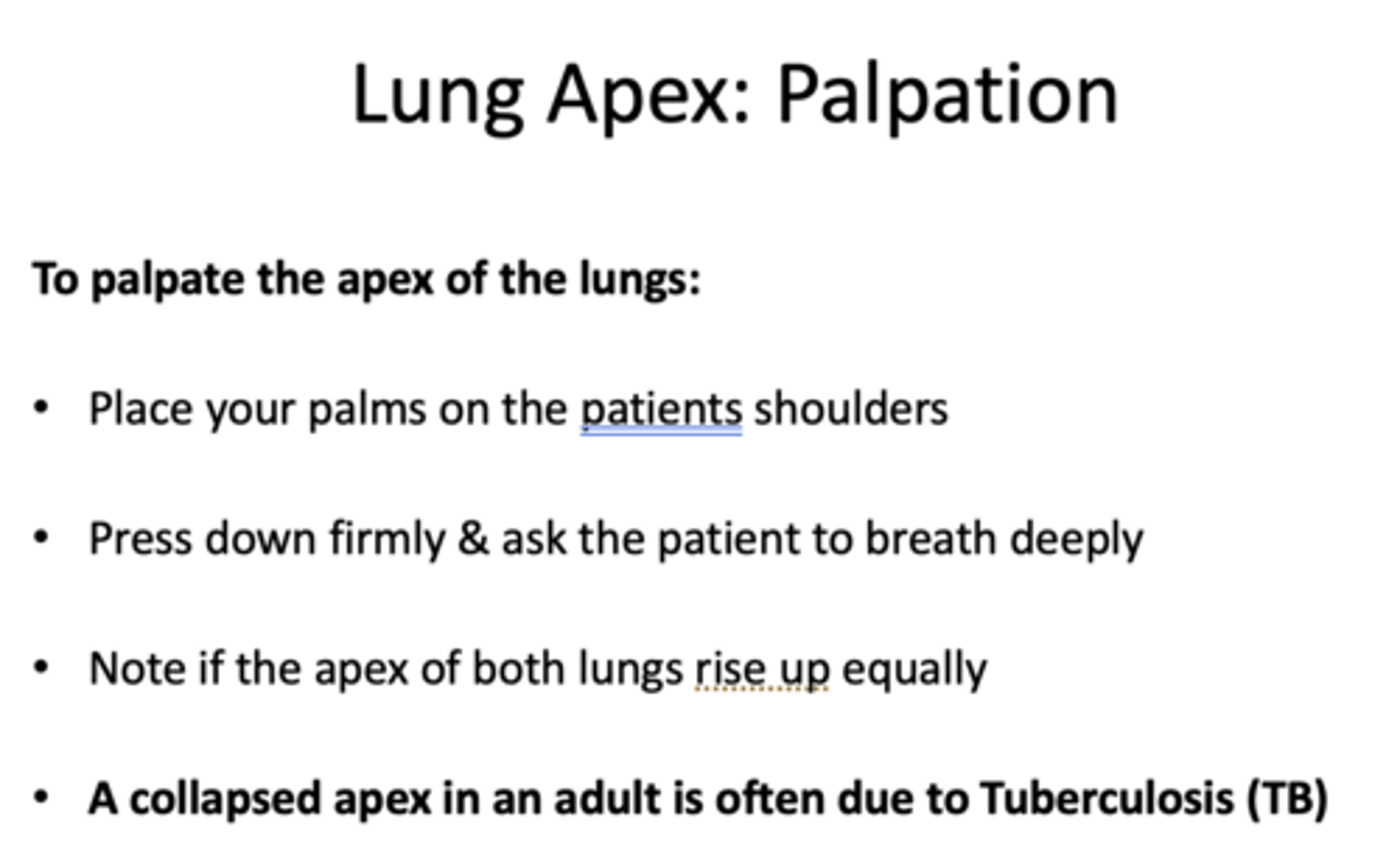
A collapsed apex in an adult is often due to ______________
Tuberculosis (TB)
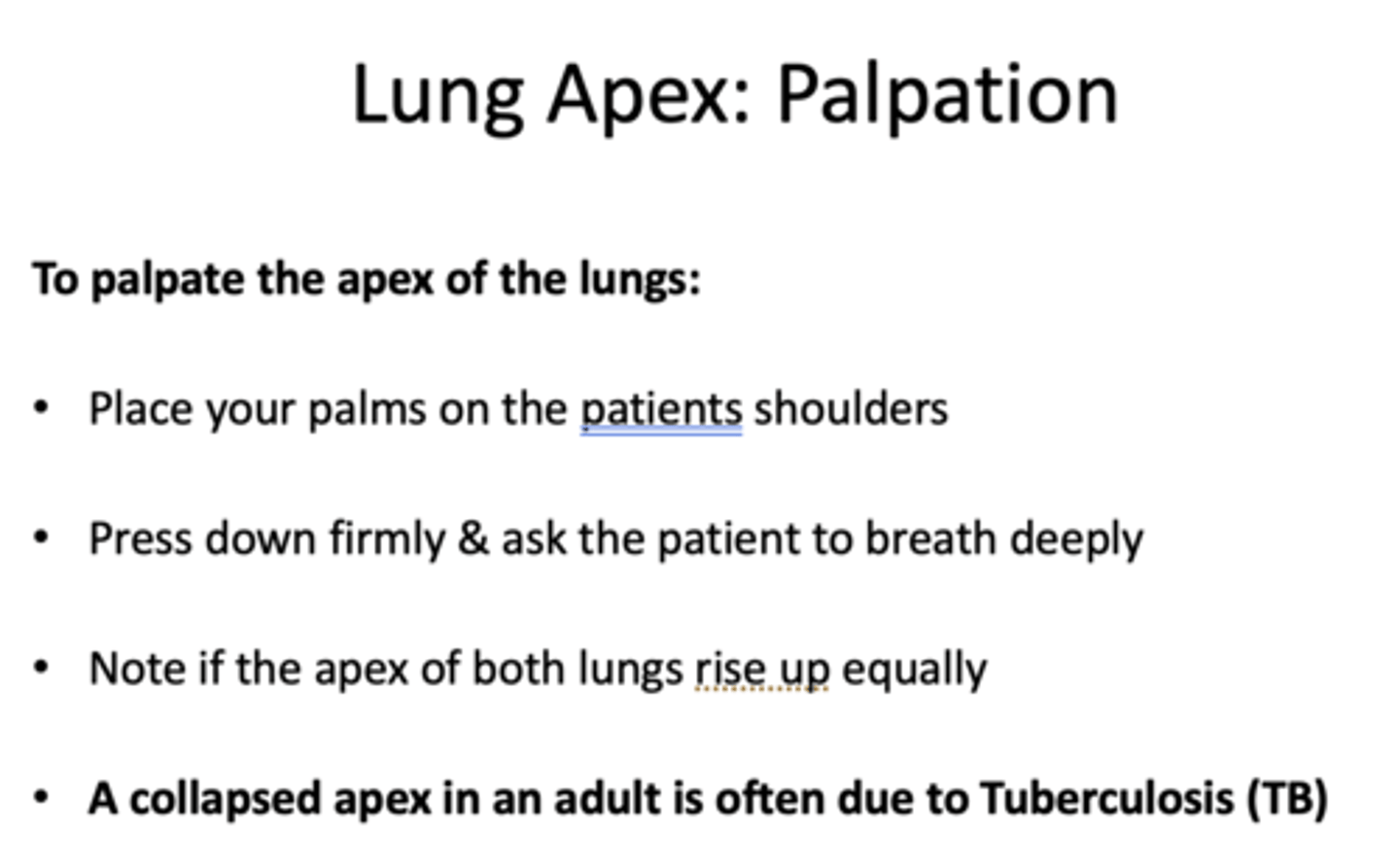
Normal lung transmits a palpable vibration sensation to the chest wall. This is referred to as ___________
fremitus
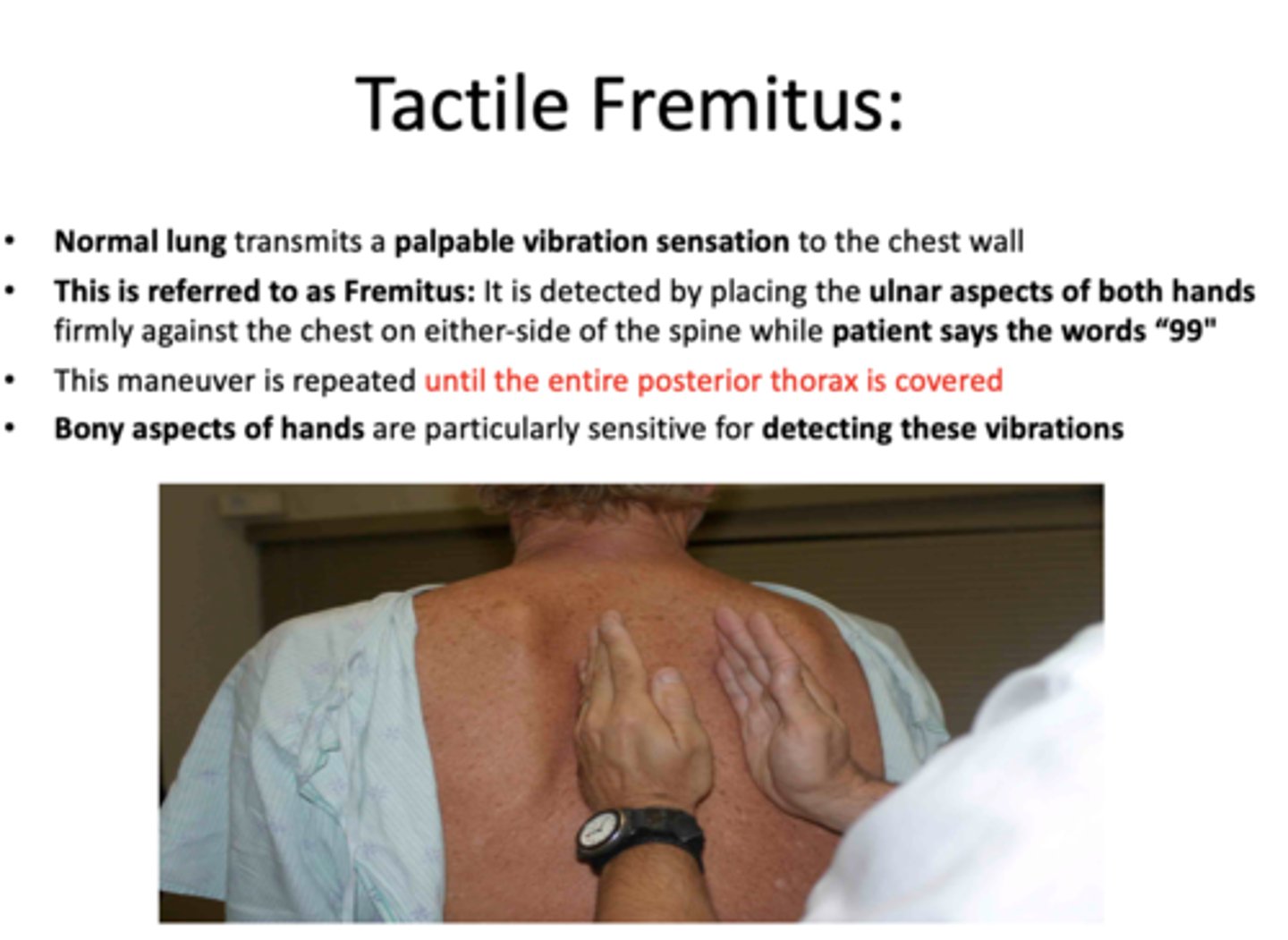
____________ is detected by by placing the ulnar aspects of both hands firmly against the chest on either-side of the spine while patient says the words "99"
tactile fremitus
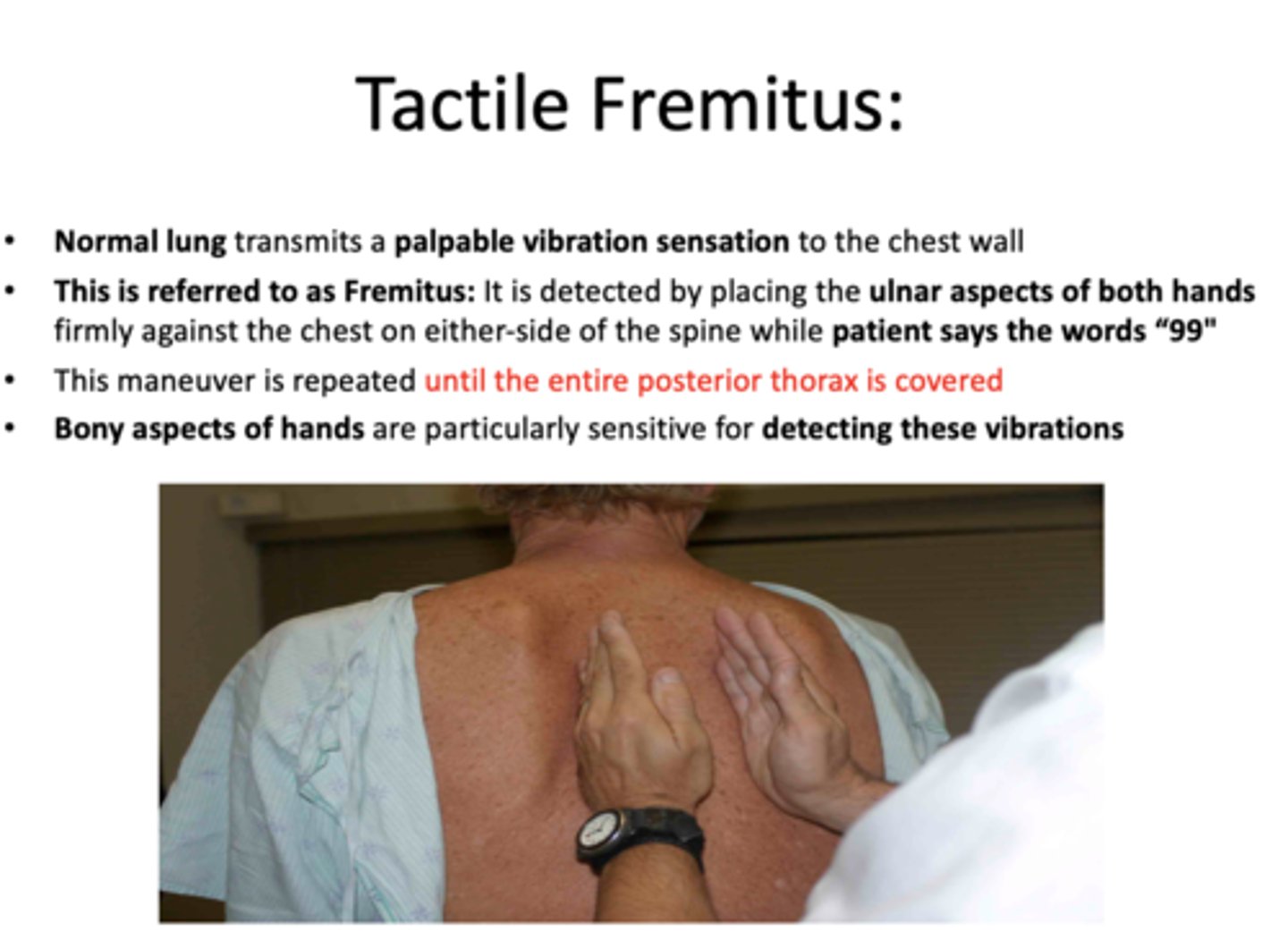
Fremitus is by placing the ulnar aspects of both hands firmly against the chest on either-side of the spine while patient says the words “99". This maneuver is repeated until when?
the entire posterior thorax is covered

t/f: bony aspects of hands are particularly sensitive for detecting these vibrations in tactile fremitus
true

Fremitus becomes _______ due to consolidation
more pronounced/increased
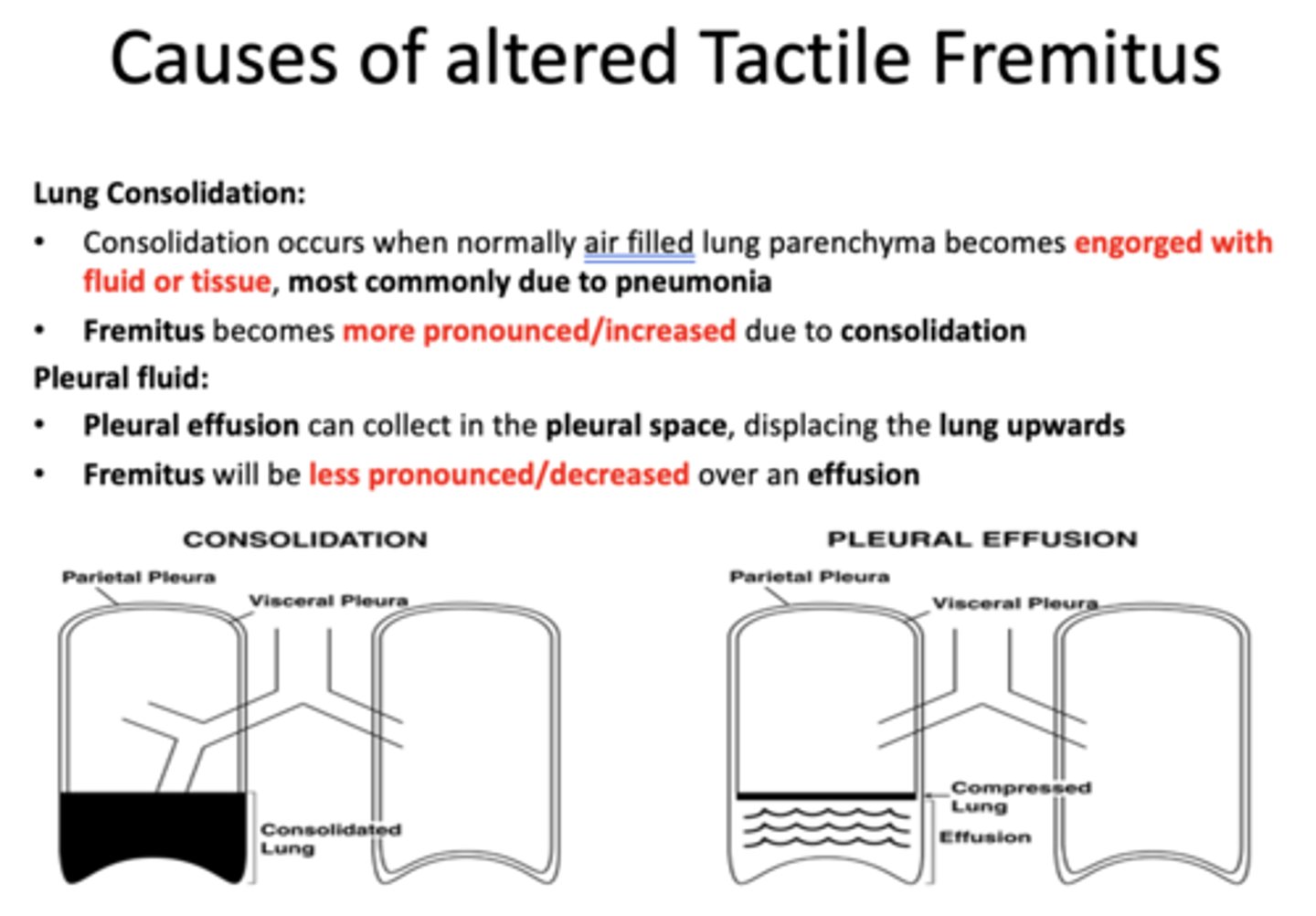
______________ occurs when normally air filled lung parenchyma becomes engorged with fluid or tissue, most commonly due to pneumonia
lung consolidation

Fremitus becomes _______ pronounced/increased due to pleural effusion
less
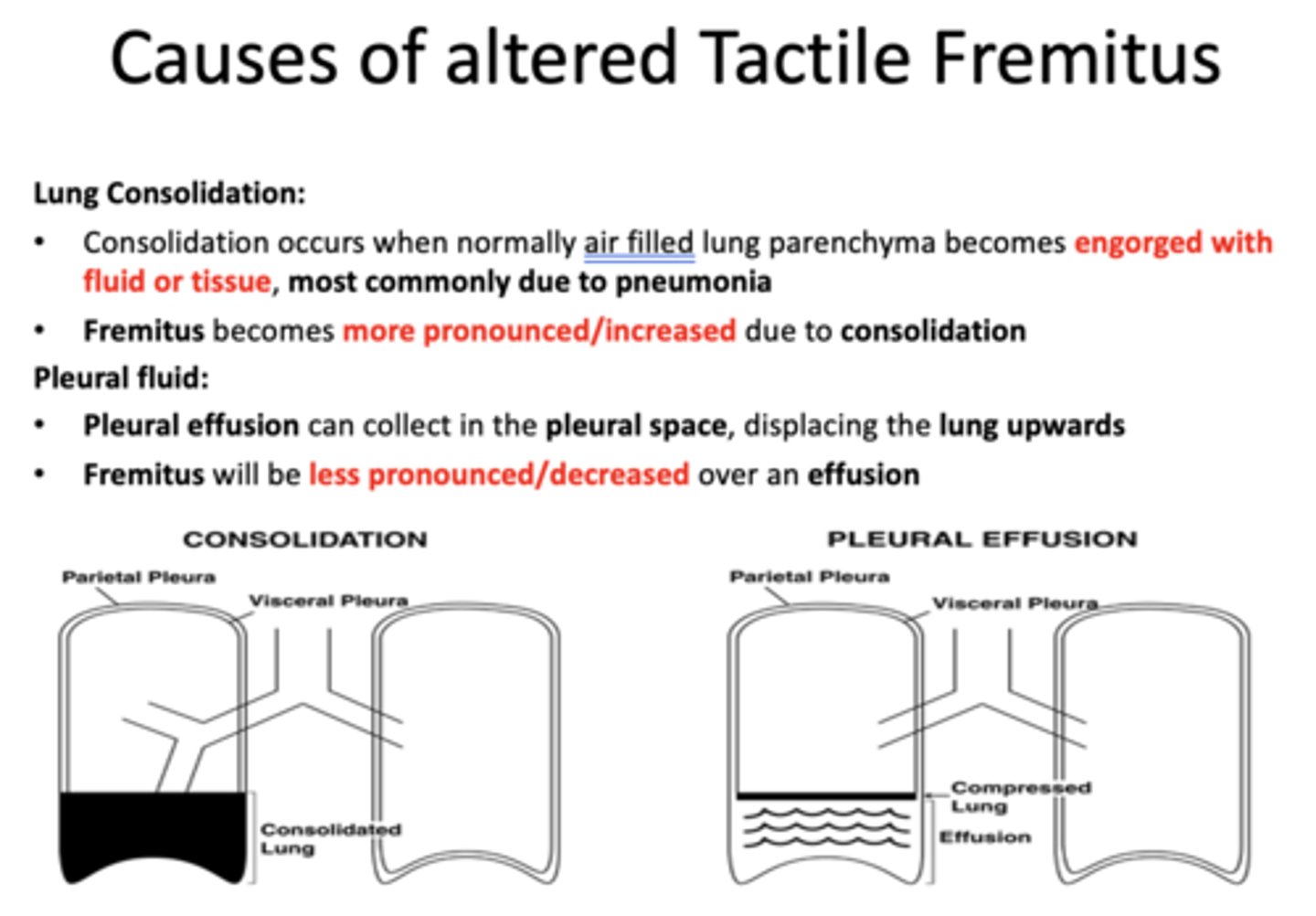
___________ can collect in the pleural space, displacing the lung upwards
plerual effusion

T/F: Percussion should NOT be on the patient's bone and it should follow a sequential pattern
True
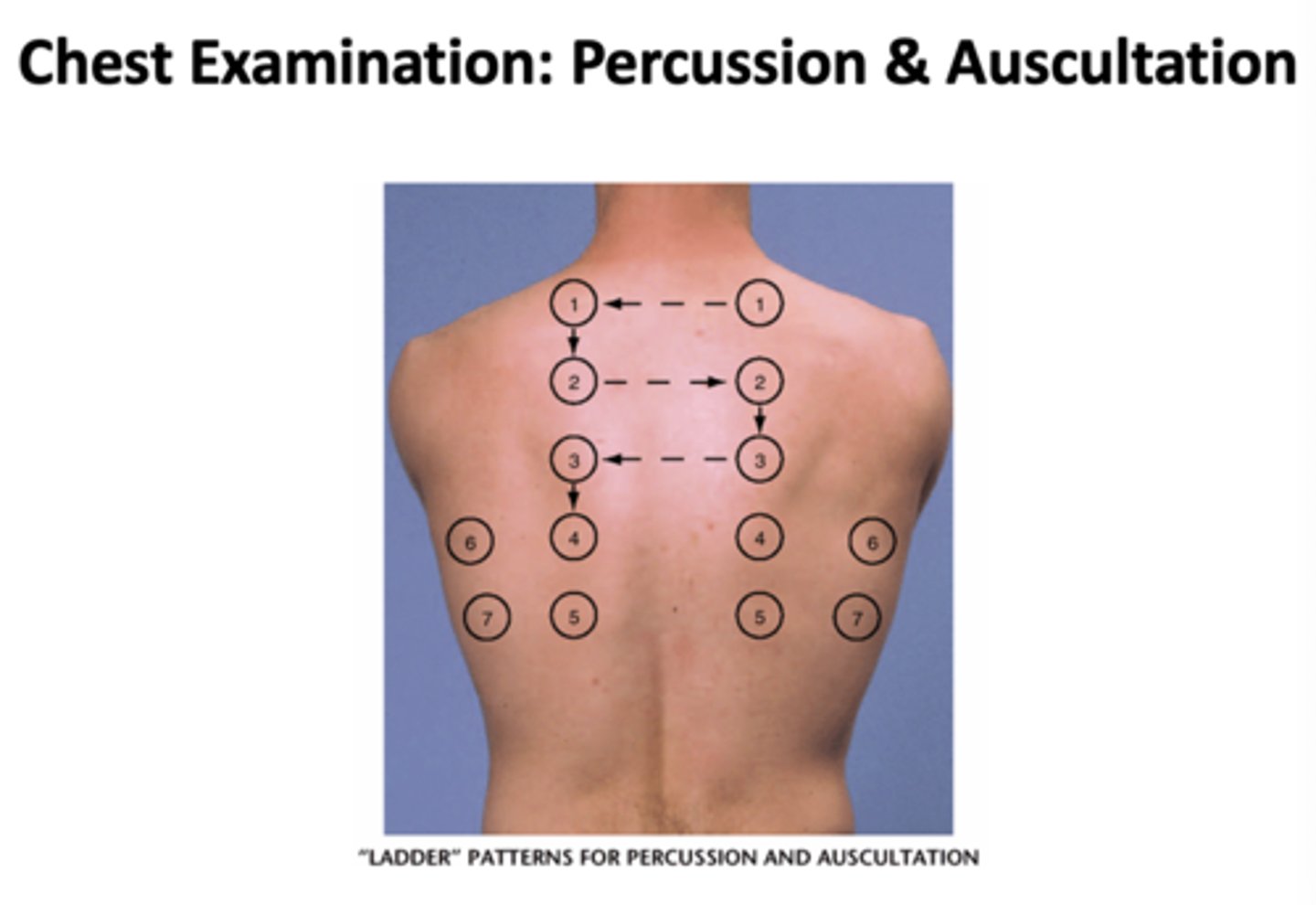
What type of assessment is this?
Allow your hand to swing freely at the wrist, hammering your finger onto the target
Percussion
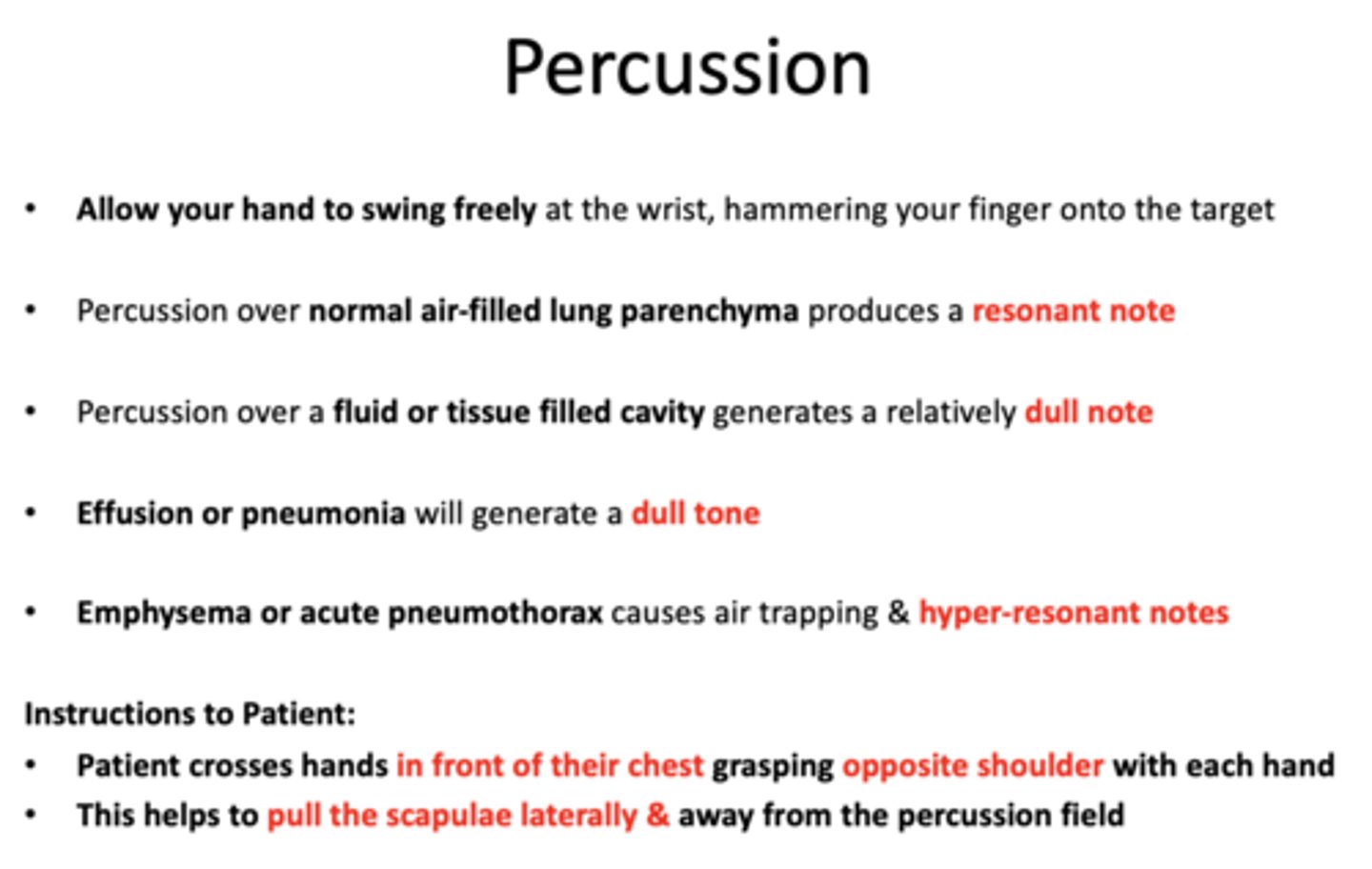
Percussion over normal air-filled lung parenchyma produces a ____________
resonant note
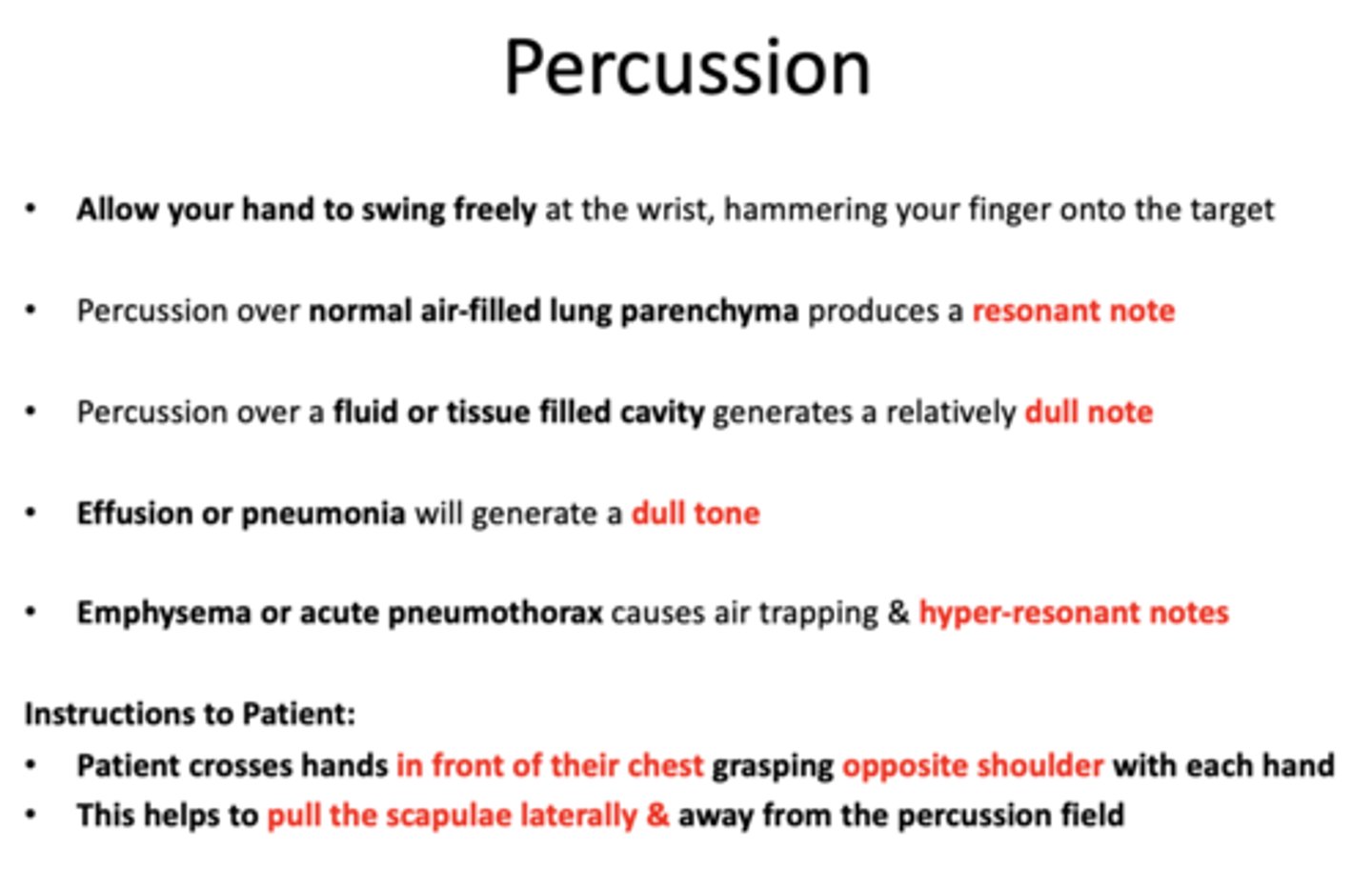
Percussion over a fluid or tissue filled cavity generates a relatively ____________
dull note

Effusion or pneumonia will generate a ____________
dull tone

Emphysema or acute pneumothorax will generate a ____________
hyper-resonant note
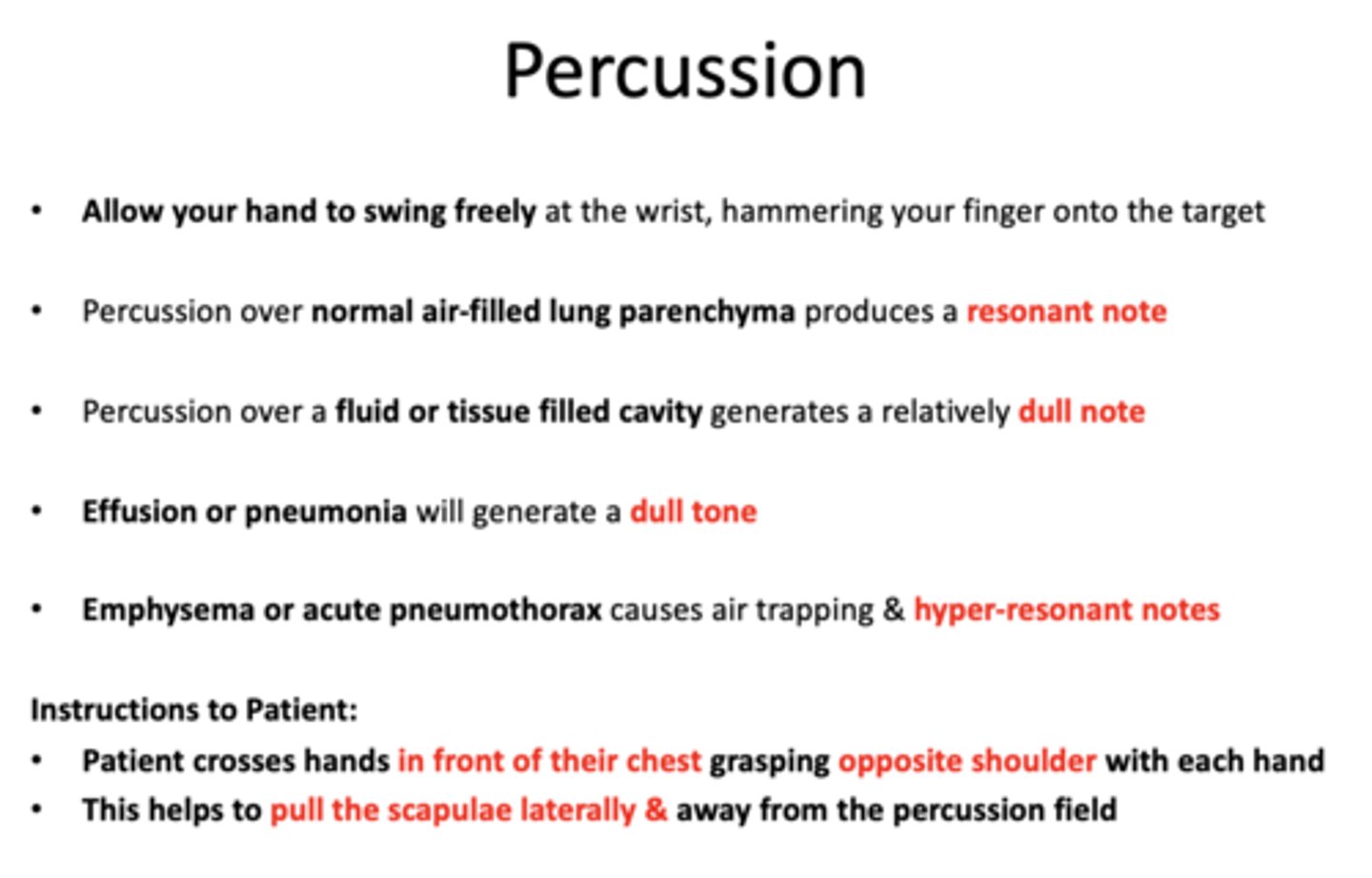
What should we instruct the patient in order to test for percussion?
- Pts cross hands in front of their chest grasping opposite shoulder
- This helps pull scapulae laterally & away from percussion field
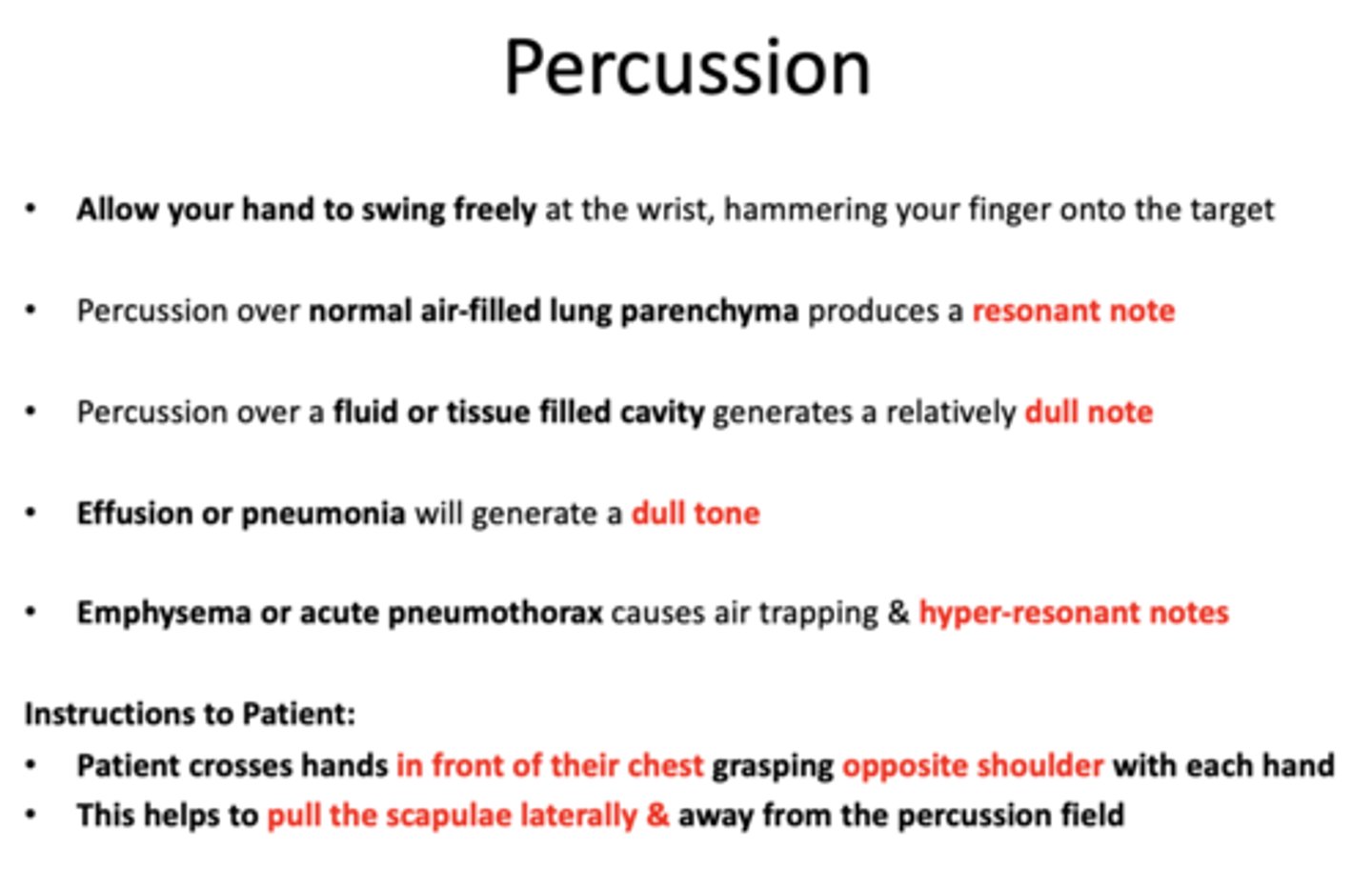
The following are key instructions for what assessment?
- Stand to the left side of the patient's back when percussing with your right hand
- Percuss down "alley" that exists between scapula & spine: avoid percussing over bone
- Deliver 2 or 3 sharp taps at each area & keep moving to other inter-spaces
- Compare R & L percussion note at EACH inter-costal space
- When you detect any abnormality, you use the other side for comparison
Percussion

Ask patient to take ________, _________ breaths through the mouth while you auscultate. This way the patient takes greater volume of air with each breath. Also, any abnormal breath sounds that might be present are easily detectable
Slow, deep
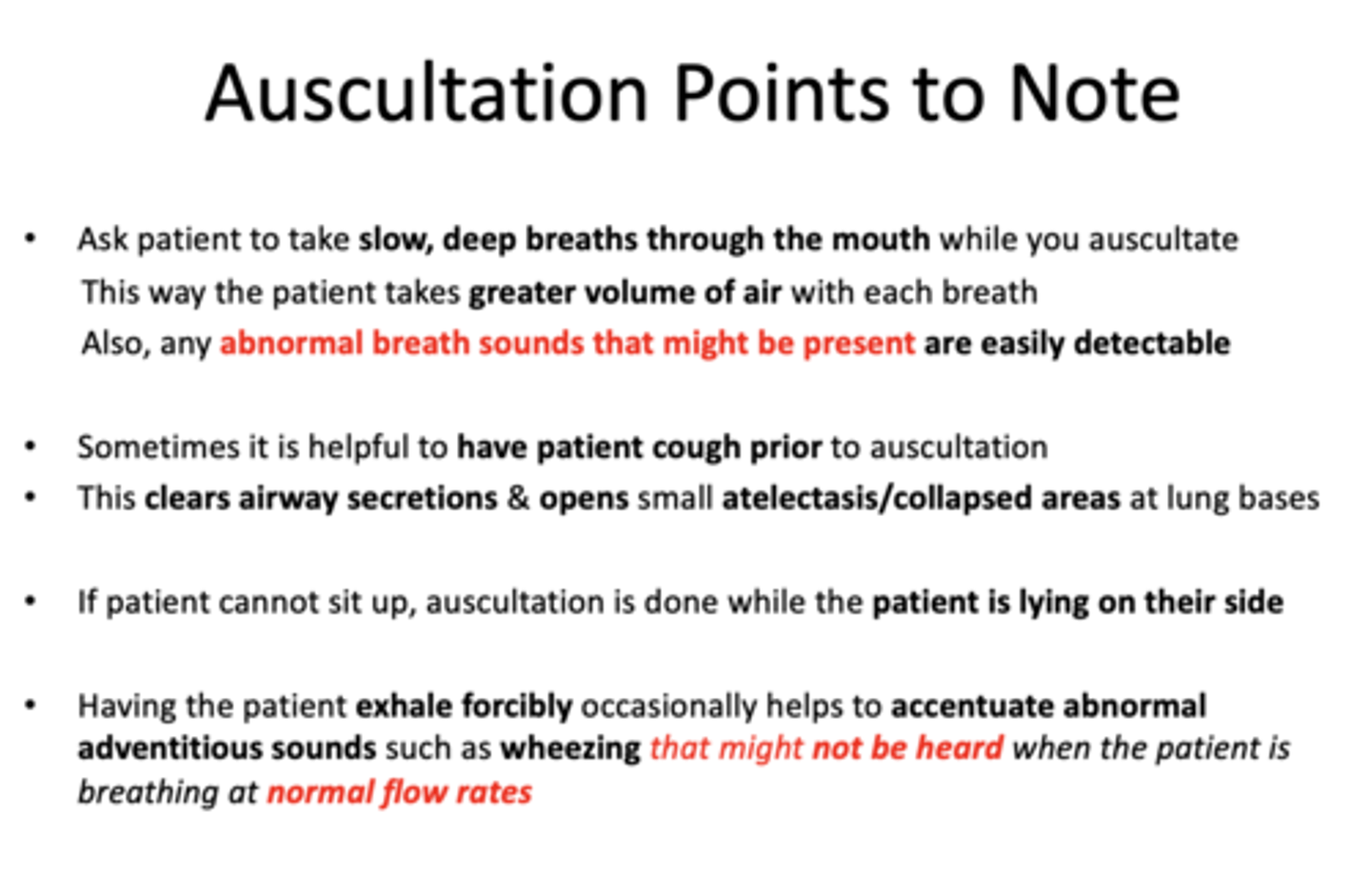
What is it sometimes helpful to have a patient do prior to auscultation?
Cough (clears airway secretions & opens small atelectasis/collapsed areas at lung bases)
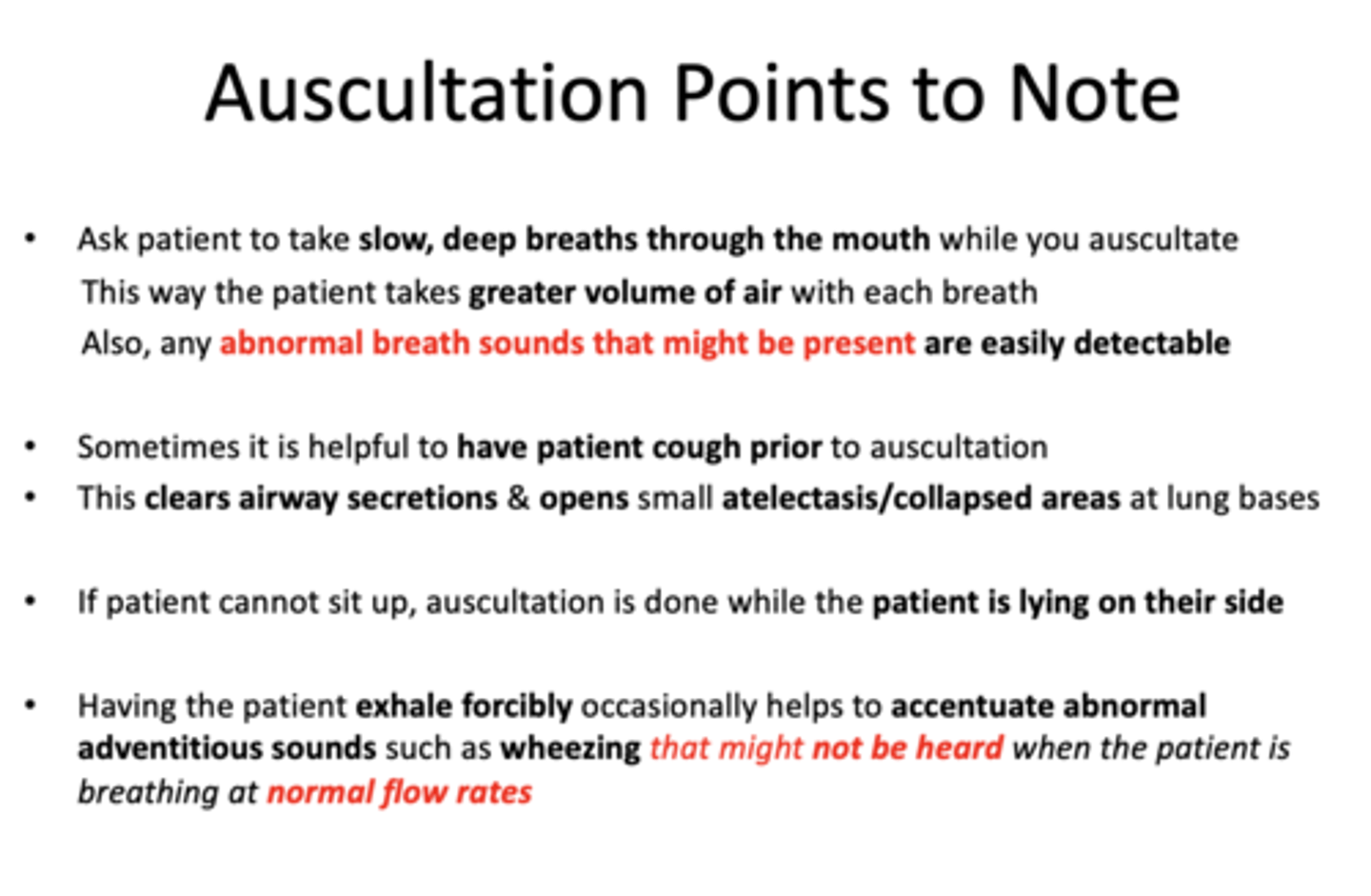
If patient cannot sit up, auscultation is done while the patient is in what position?
Lying on their side
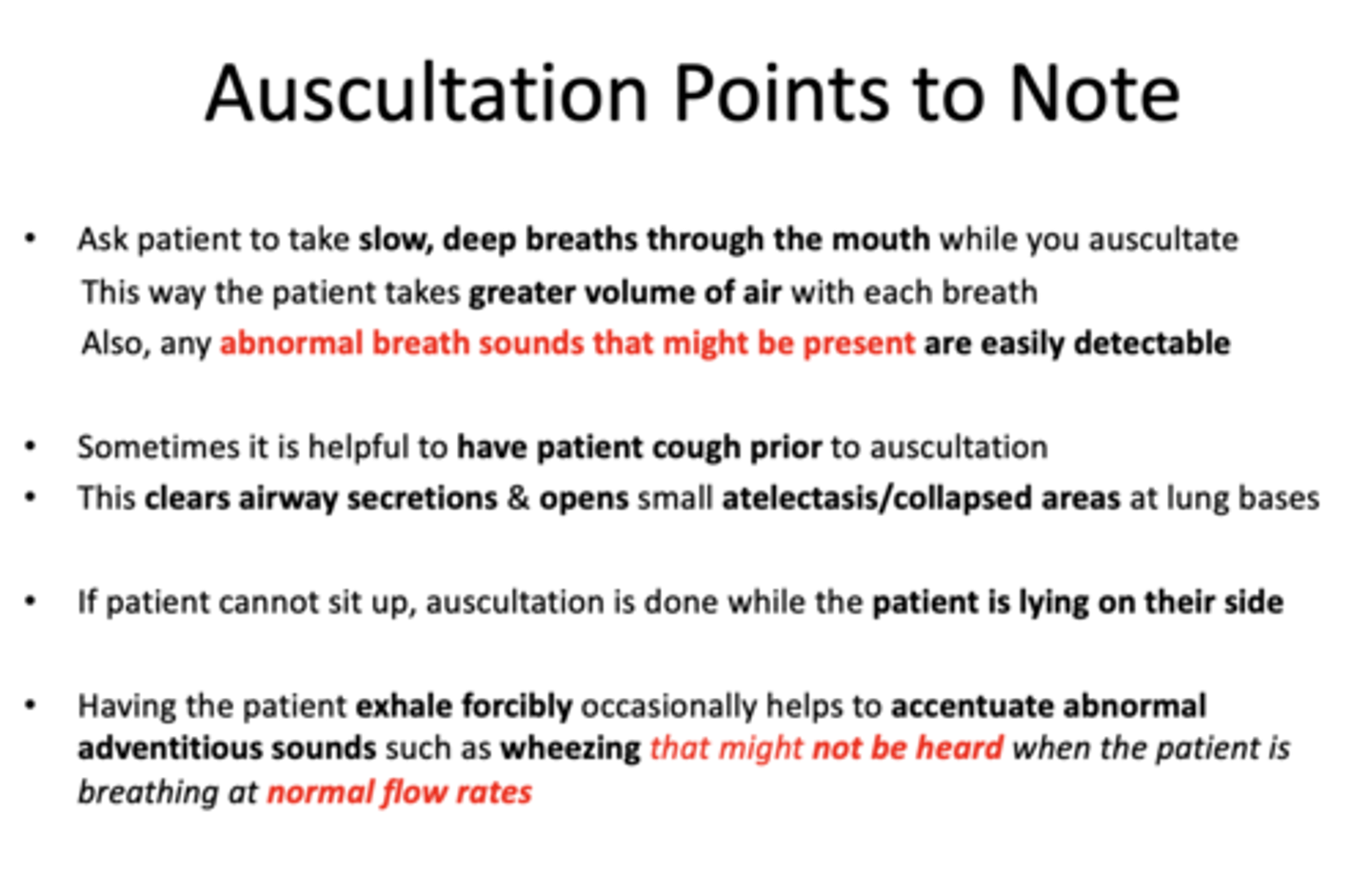
T/F: Having the patient exhale forcibly occasionally helps to accentuate abnormal adventitious sounds such as wheezing that might not be heard when the patient is breathing at normal flow rates
True
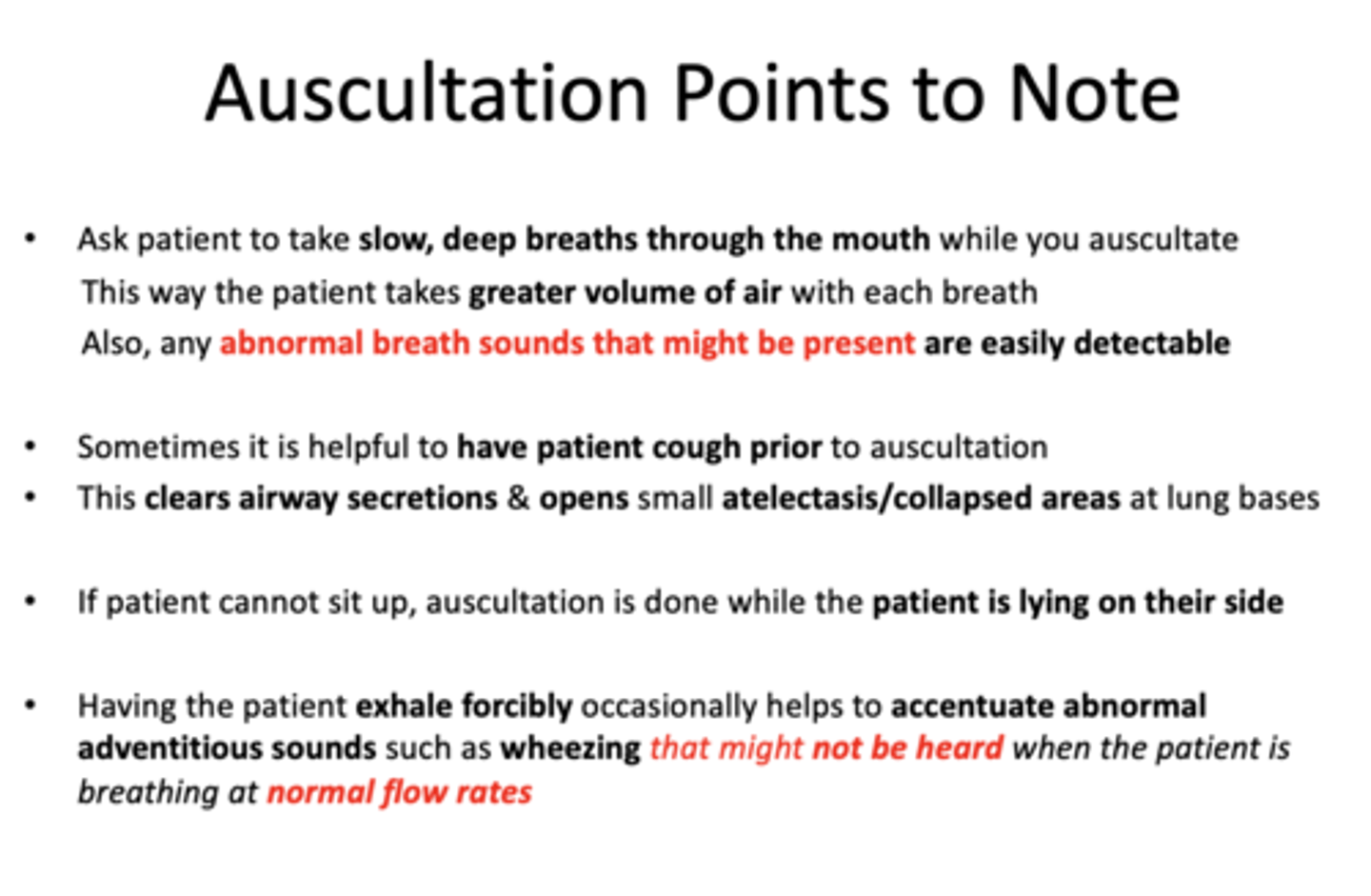
Auscultation of the lungs is generally done while the patient is in what position?
Patient is sitting upright
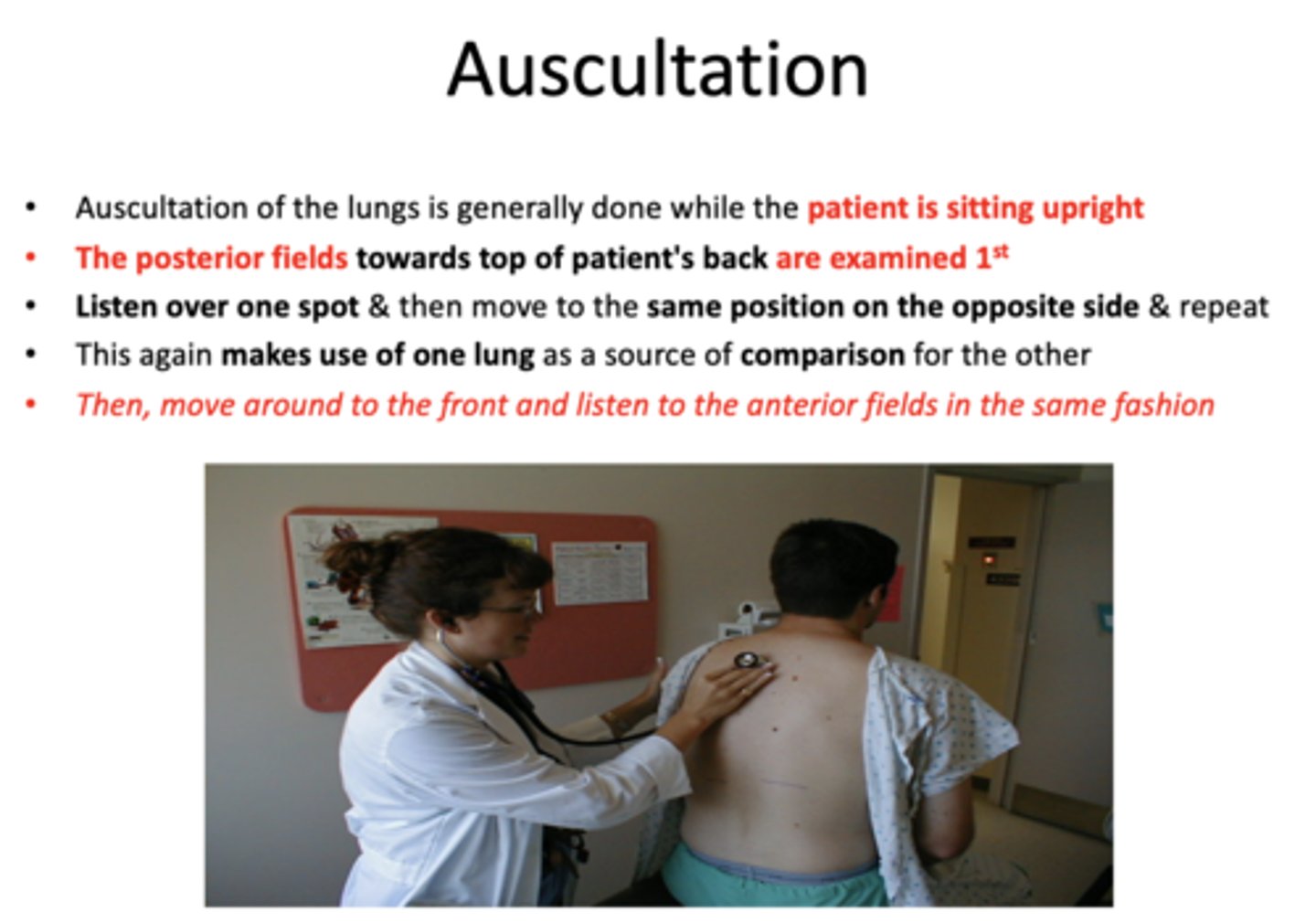
Auscultation of the lungs is generally done with the patient sitting upright. The _______ fields towards top of patient's back are examined 1st
posterior
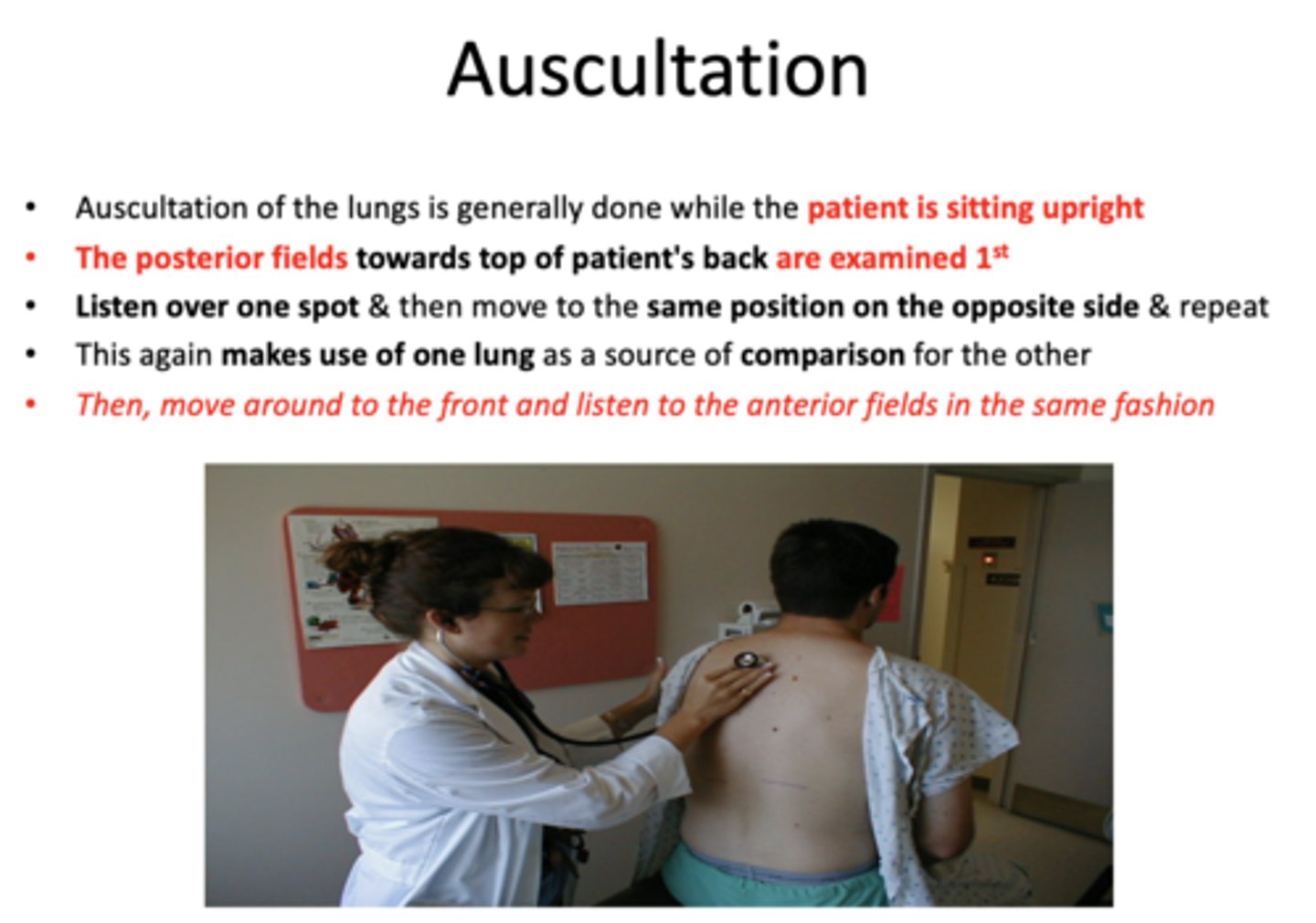
During auscultation, how should you check each position?
Listen to one spot then move to the same position on opposite side and then move around to the front and listen from the anterior view (allows for comparions)
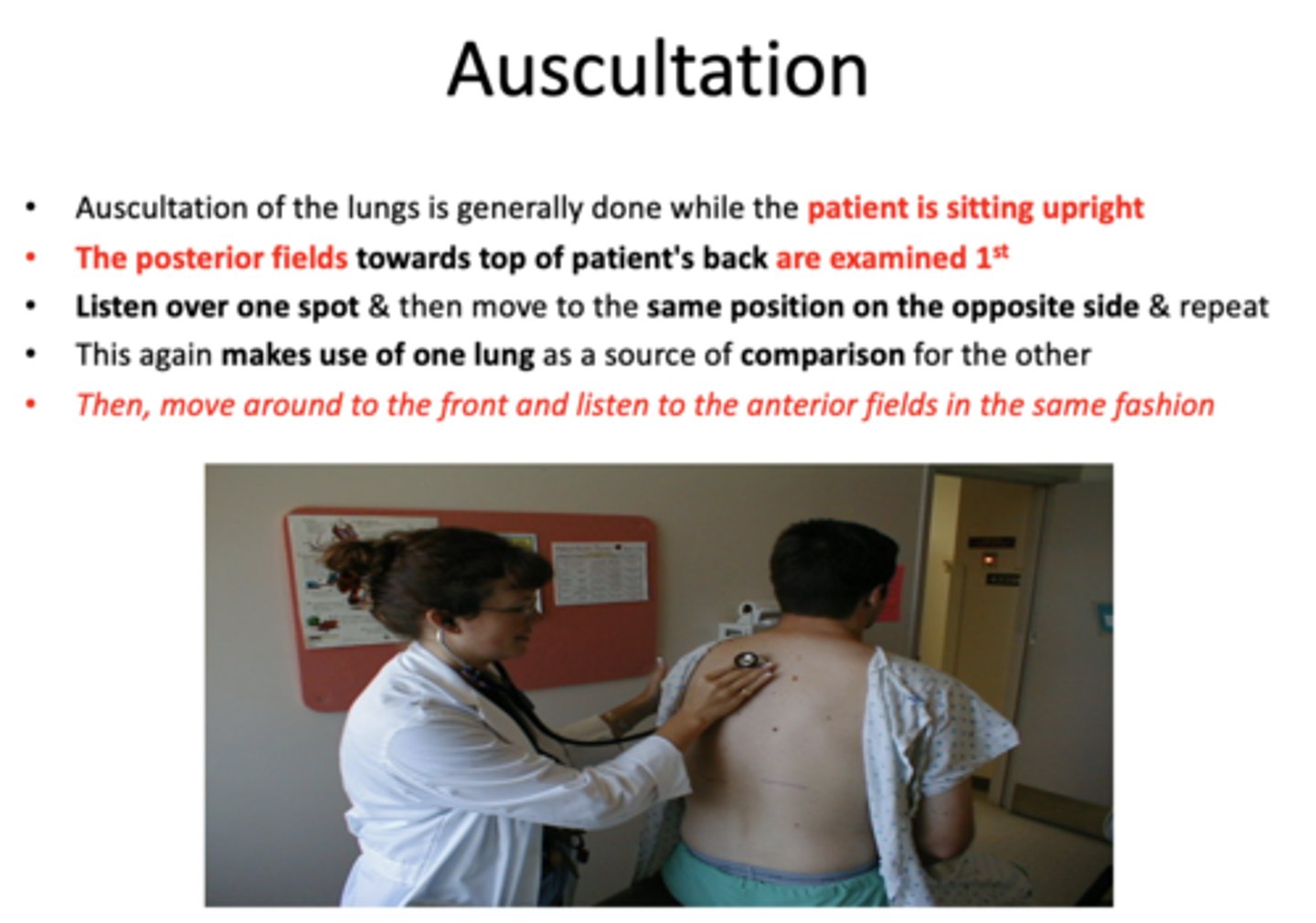
Name 4 breath sounds:
- Vesicular
- Bronchial
- Broncho-Vesicular
- Tubular
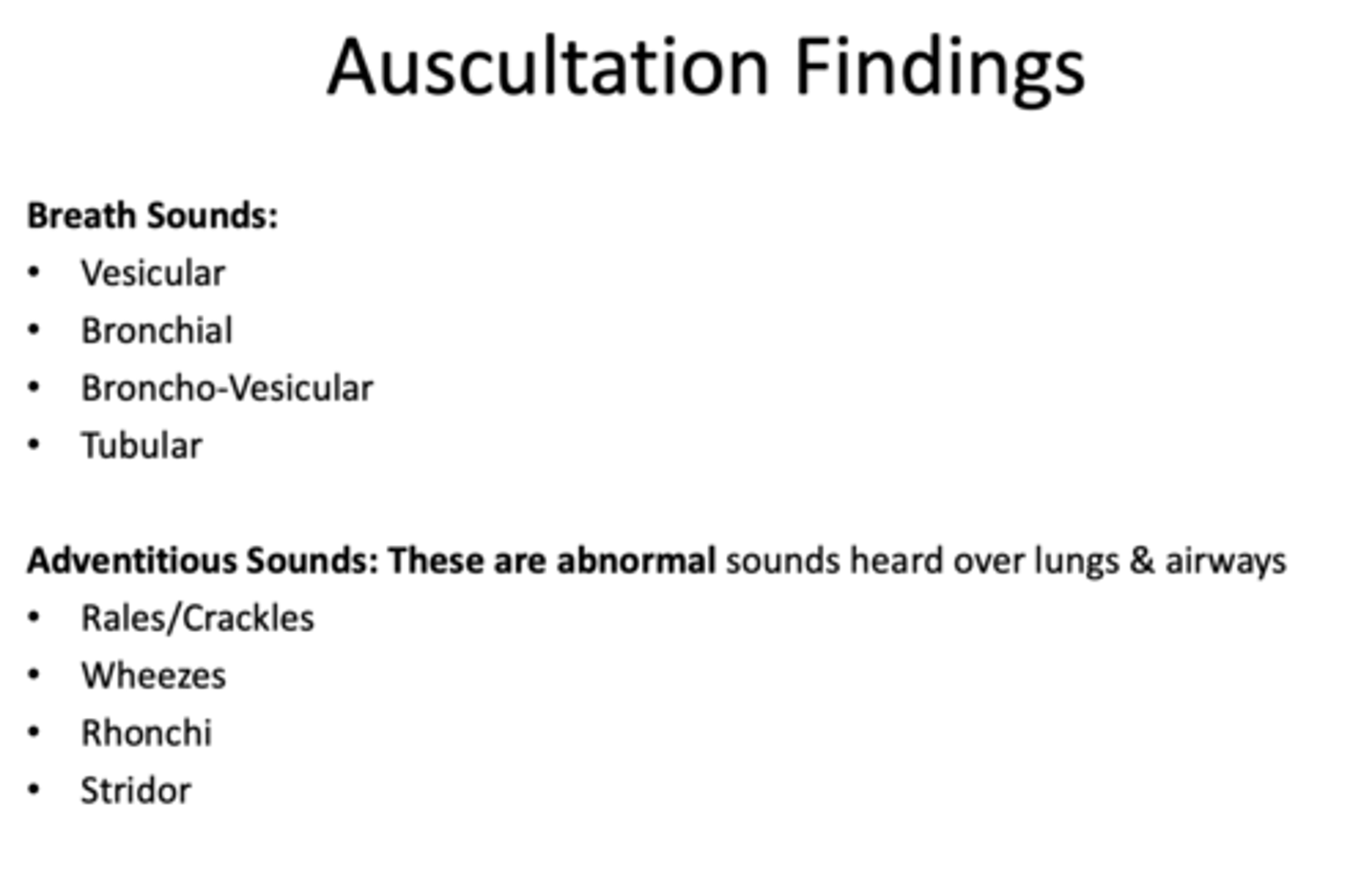
Name 4 adventitious sounds (abnormal sounds heard over lung and airways)
- Rales/crackles
- Wheezes
- Rhonchi
- Stridor

What type of breath sound is the following?
- Produce a soft inspiratory sound as air rushes into the lungs
- Very little noise occurs on expiration: NORMAL pattern over lung parenchyma
Vesicular Breath Sounds

What type of breath sound is the following?
- Sounds are tubular, hollow, louder & high-pitched than Vesicular sounds
- There is a pause between inspiration and expiration
Bronchial Breath Sounds

What type of breath sound is the following?
- They are heard NORMALLY over the large airways (e.g. over sternal angle)
- Considered ABNORMAL when heard over the lung parenchyma
bronchial breath sounds

What type of breath sound is the following?
- NORMAL Bronchial breath sounds over the Trachea
- They have a higher pitch & are louder: Inspiration & expiration bars are equal
- There is a pause between inspiration and expiration bars
Tracheal Breath Sounds

What type of breath sound is the following?
- Inspiration & expiration bars are equal
- Sounds have with intermediate intensity & pitch compared to Vesicular Breath Sounds• They are heard NORMALLY in the 1st & 2nd ICS
broncho-vestibular sounds
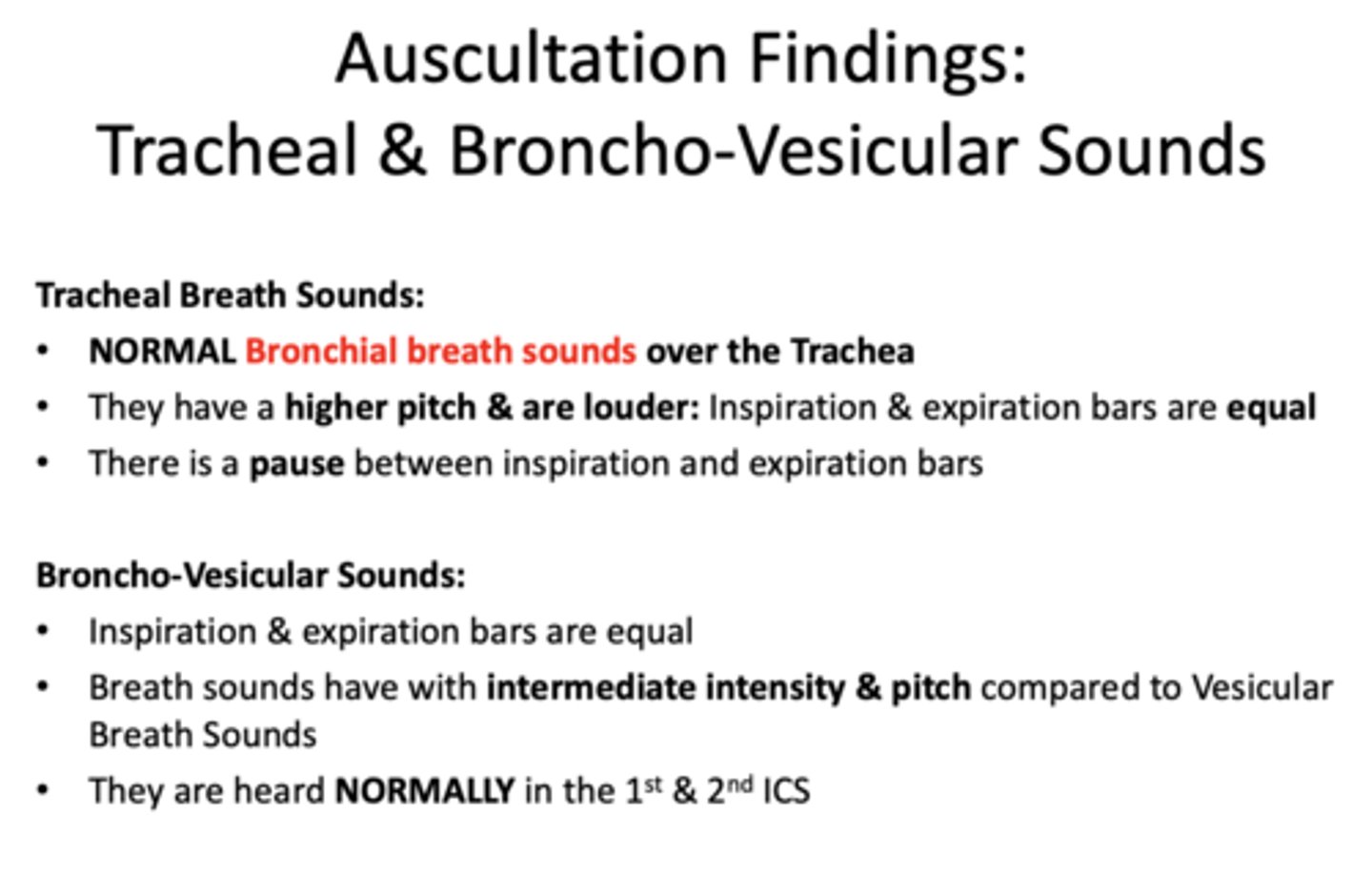
What type of breath sound is the following?
- Inspiratory sound lasts longer
- Expiratory sound is shorter & passive
- Inspiratory sound is low pitched & soft
- No pause between inspiration &expiration
- Heard over normal lung parenchyma
vesicular breathing

What type of breath sound is the following?
- Expiratory sound lasts longer
- Expiratory sound is high pitched
- Intensity of the Expiratory sound is loud
- Pause between inspiration & expiration
bronchial breathing

What type of breath sound is the following?
- Normal when heard at sternal angle
- Abnormal when heard over lung parenchyma: Indicates underlying disease
bronchial breathing

What type of breath sound is the following?
- Inspiration & Expiration bars equal & no space
- Pitch & intensity of Expiration are intermediate
- Heard between 1st & 2nd ICS level in thefront & between scapulae at the back
broncho-vesicular breath sound
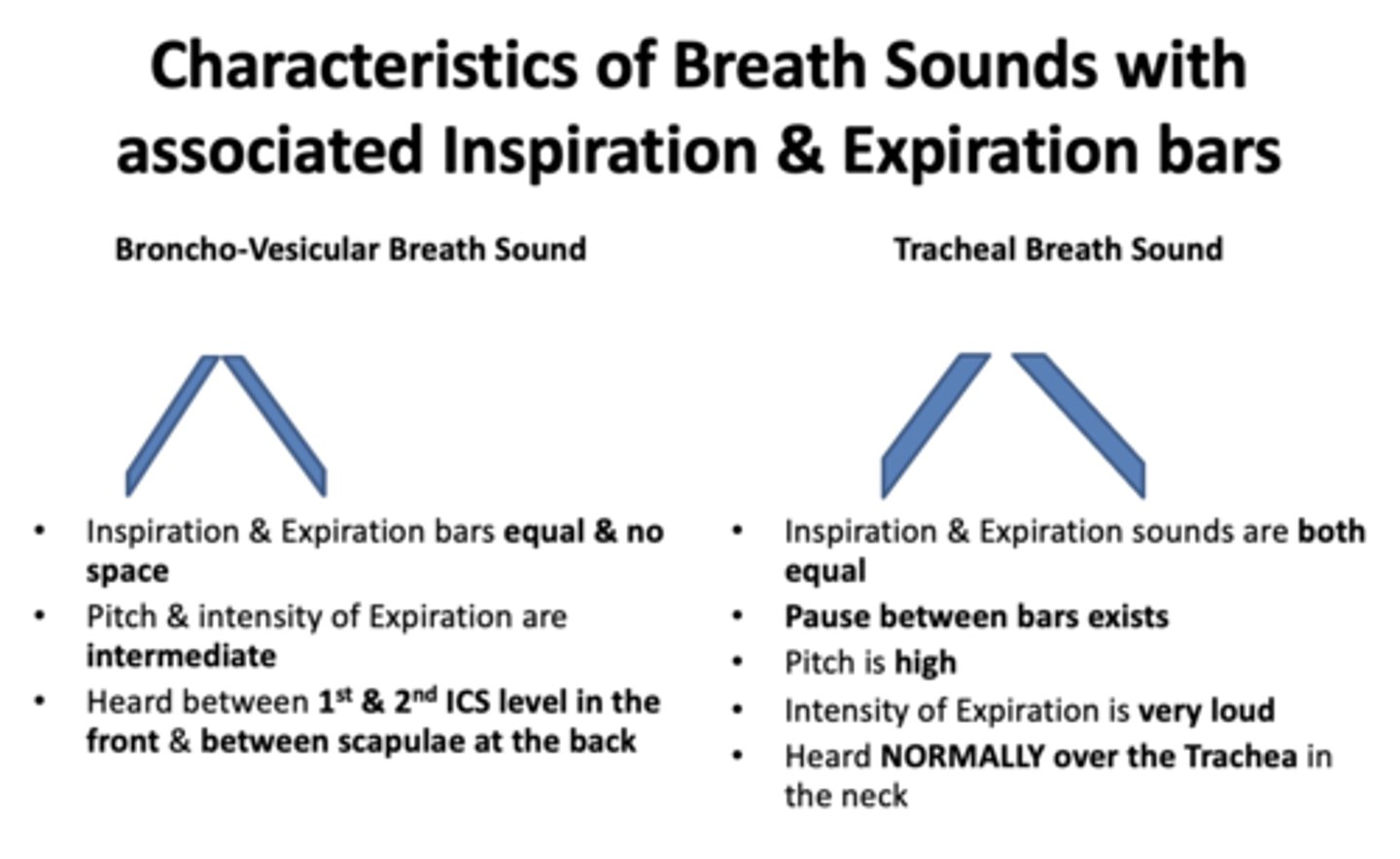
What type of breath sound is the following?
- Inspiration & Expiration sounds are both equal
- Pause between bars exists
- Pitch is high
- Intensity of Expiration is very loud
- Heard NORMALLY over the Trachea in the neck
tracheal breath sound
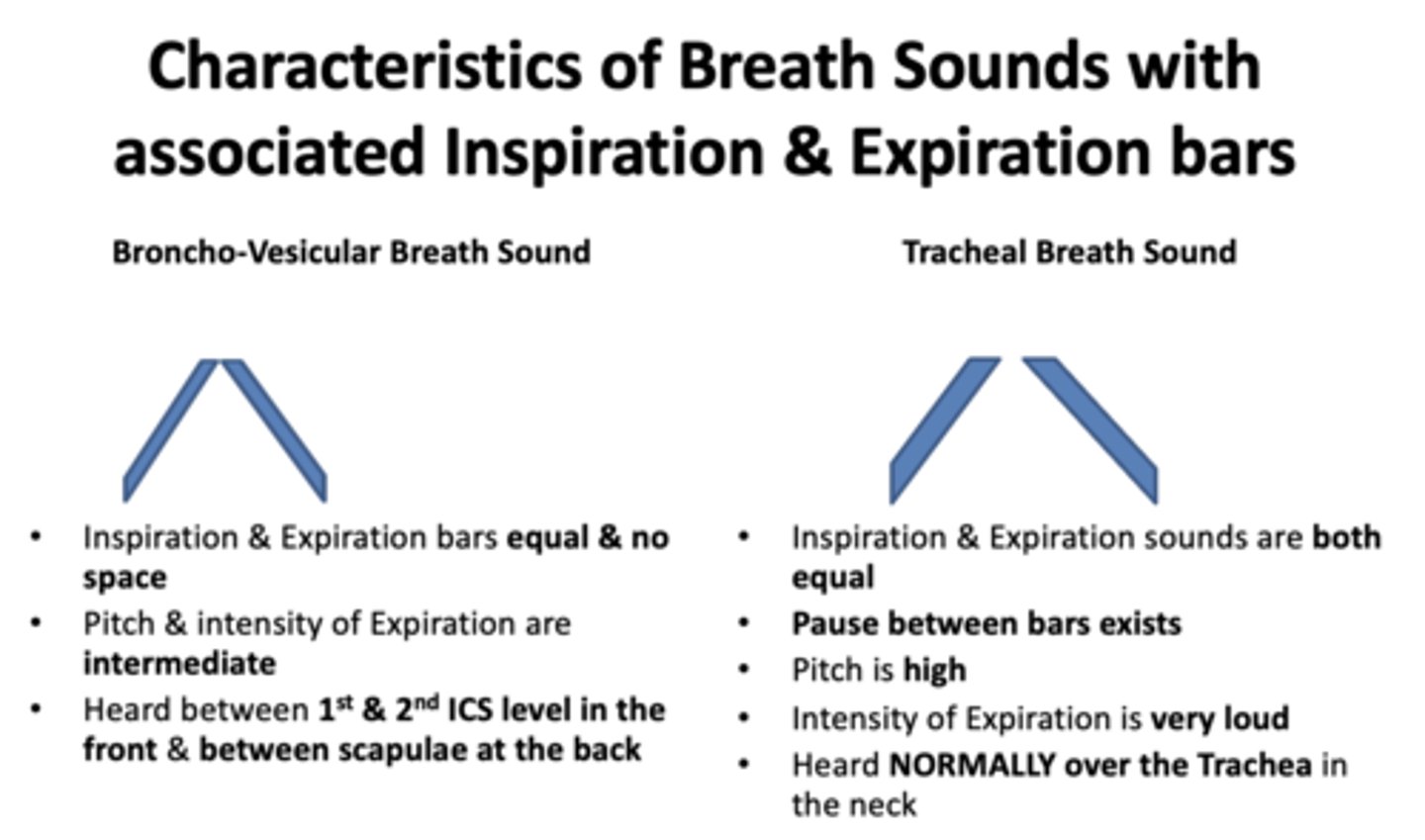
What has the following characteristics?
- Caused by fluid accumulation in alveolar & intersitial spaces
- Similar to rubbing stands of hair together
- Pulmonary edema most common cause
- Most common in elderly & results in symmetric findings
- Occurs first in lower lobes & extends towards apices as disease progresses
rales/crackles

What is the most common cause of rales/crackles sound?
Pulmonary edema
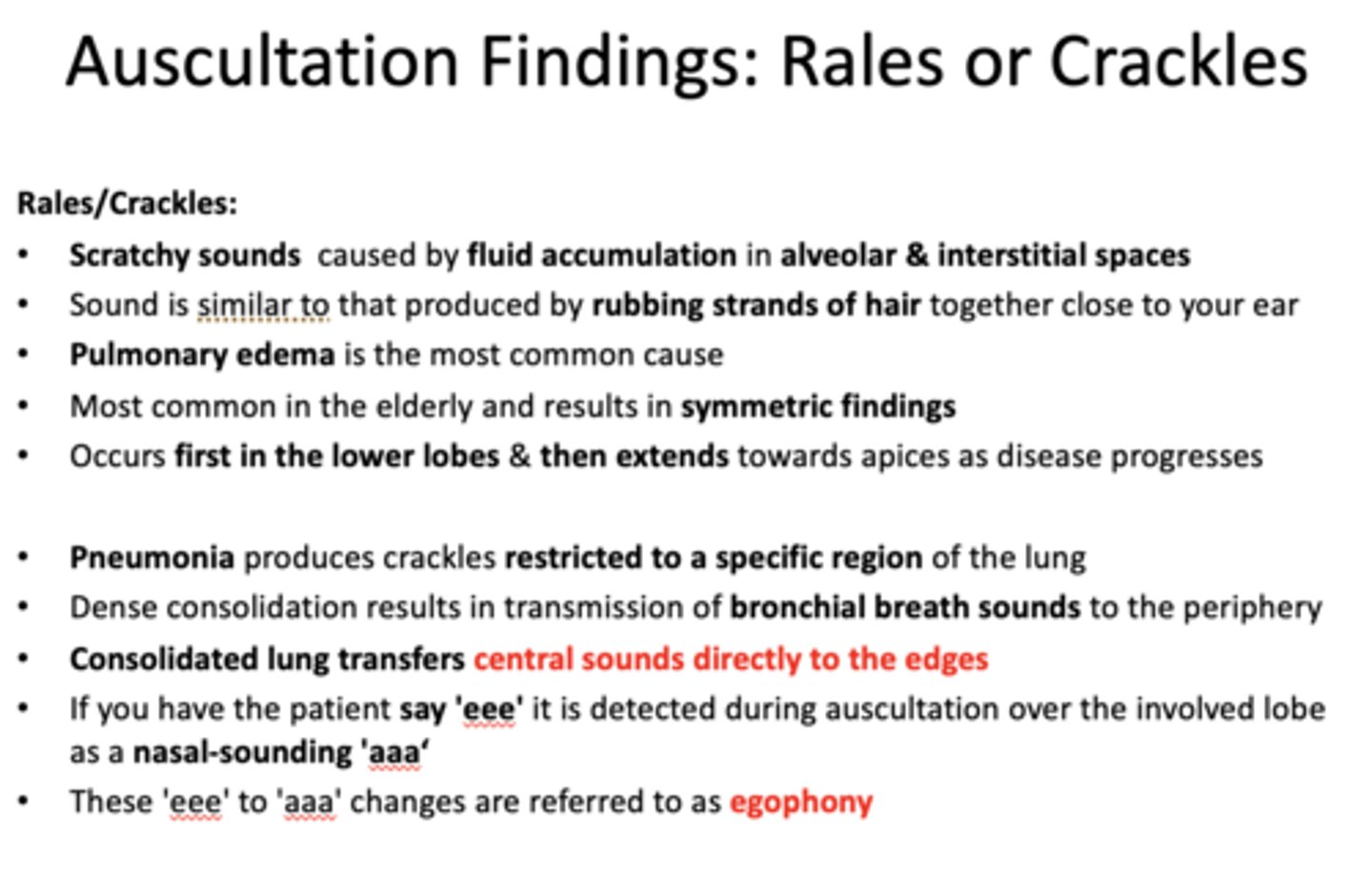
penumonia produces crackles restricted to where?
specific region of lung
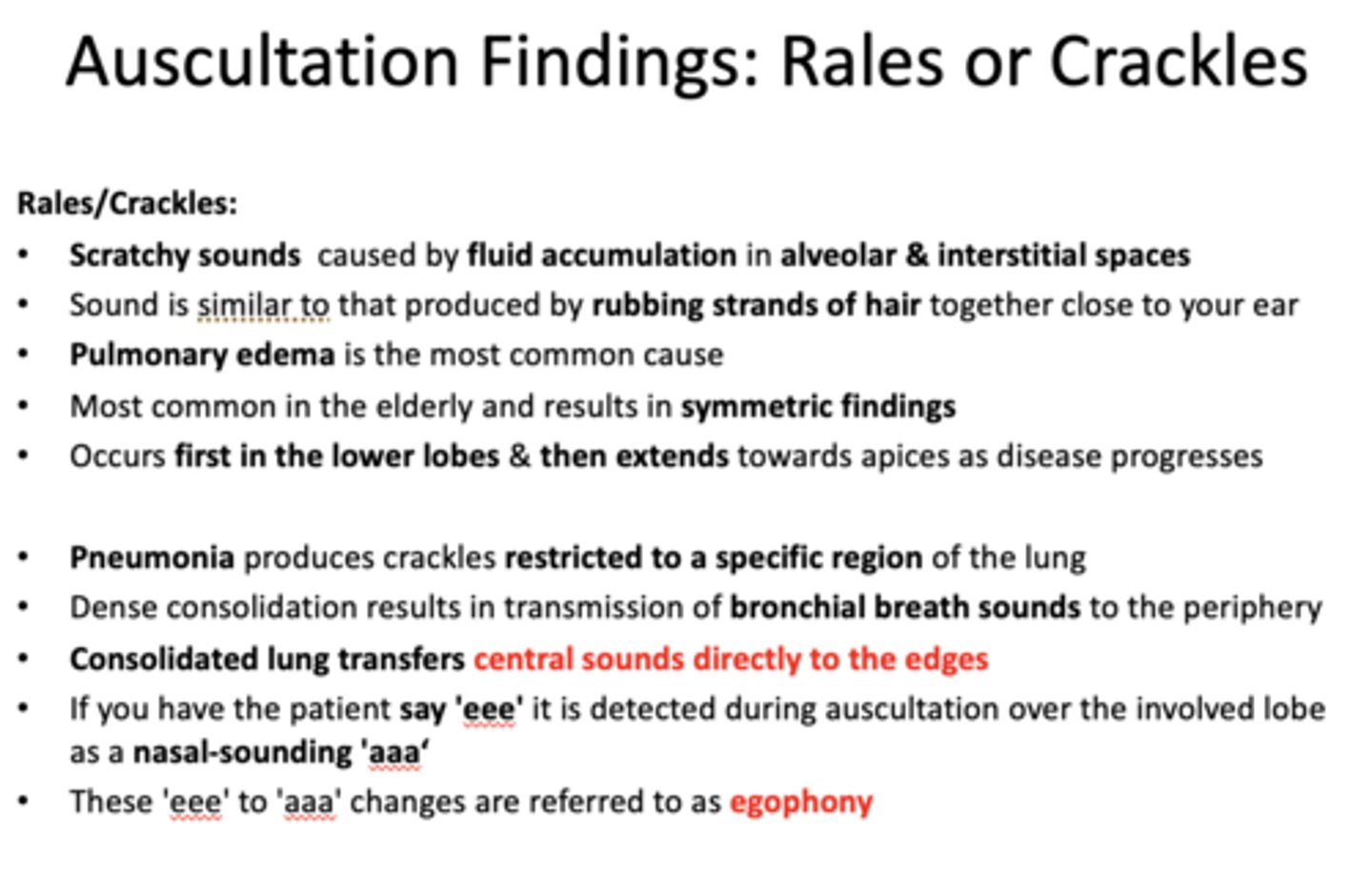
Consolidated lung transfers central sounds directly to the _______
edges
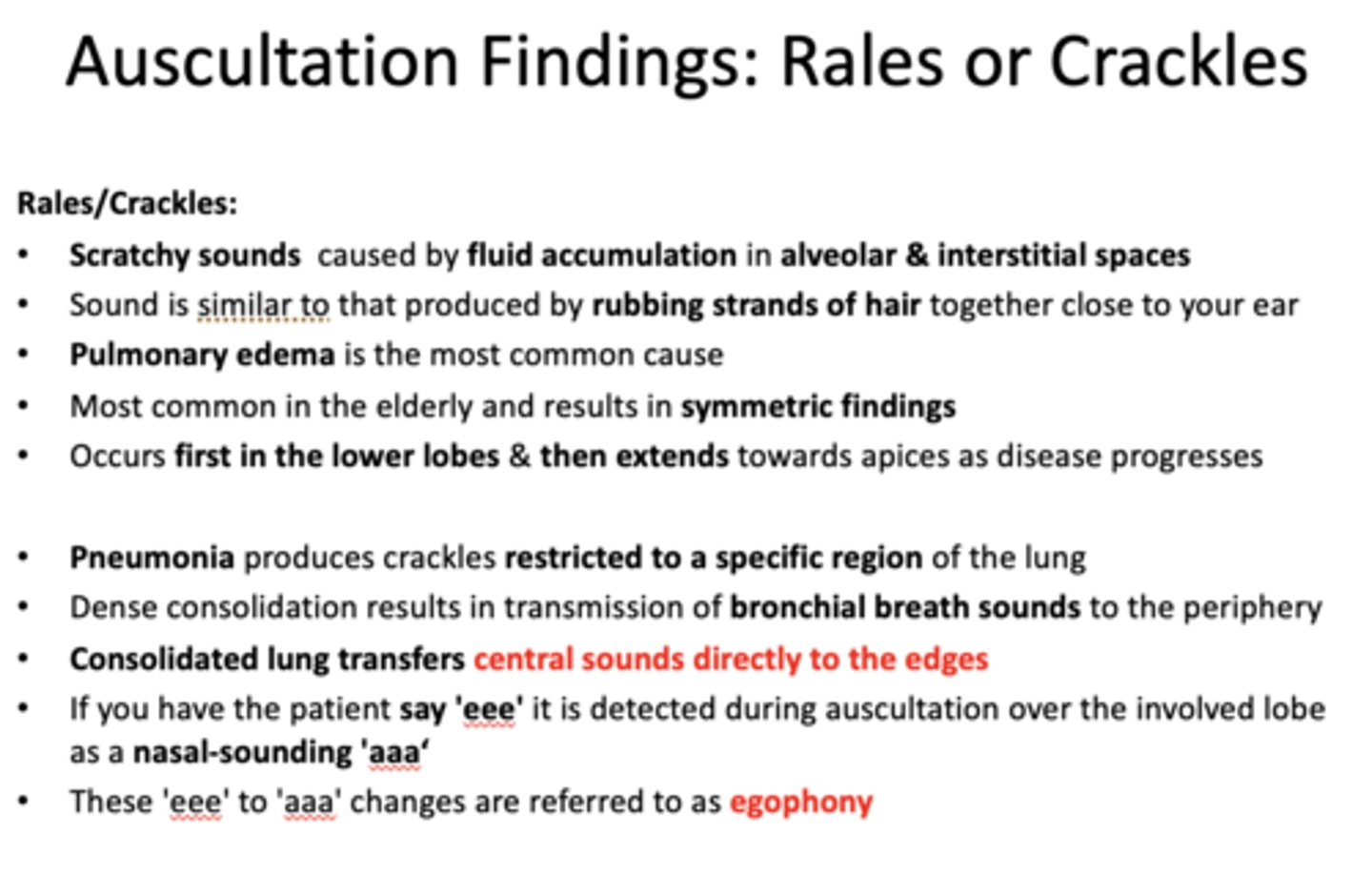
dense consolidation results in transmission of _________ to periphery
bronchial breath sounds

consolidated lung transfers central sounds directly to ____________
edges
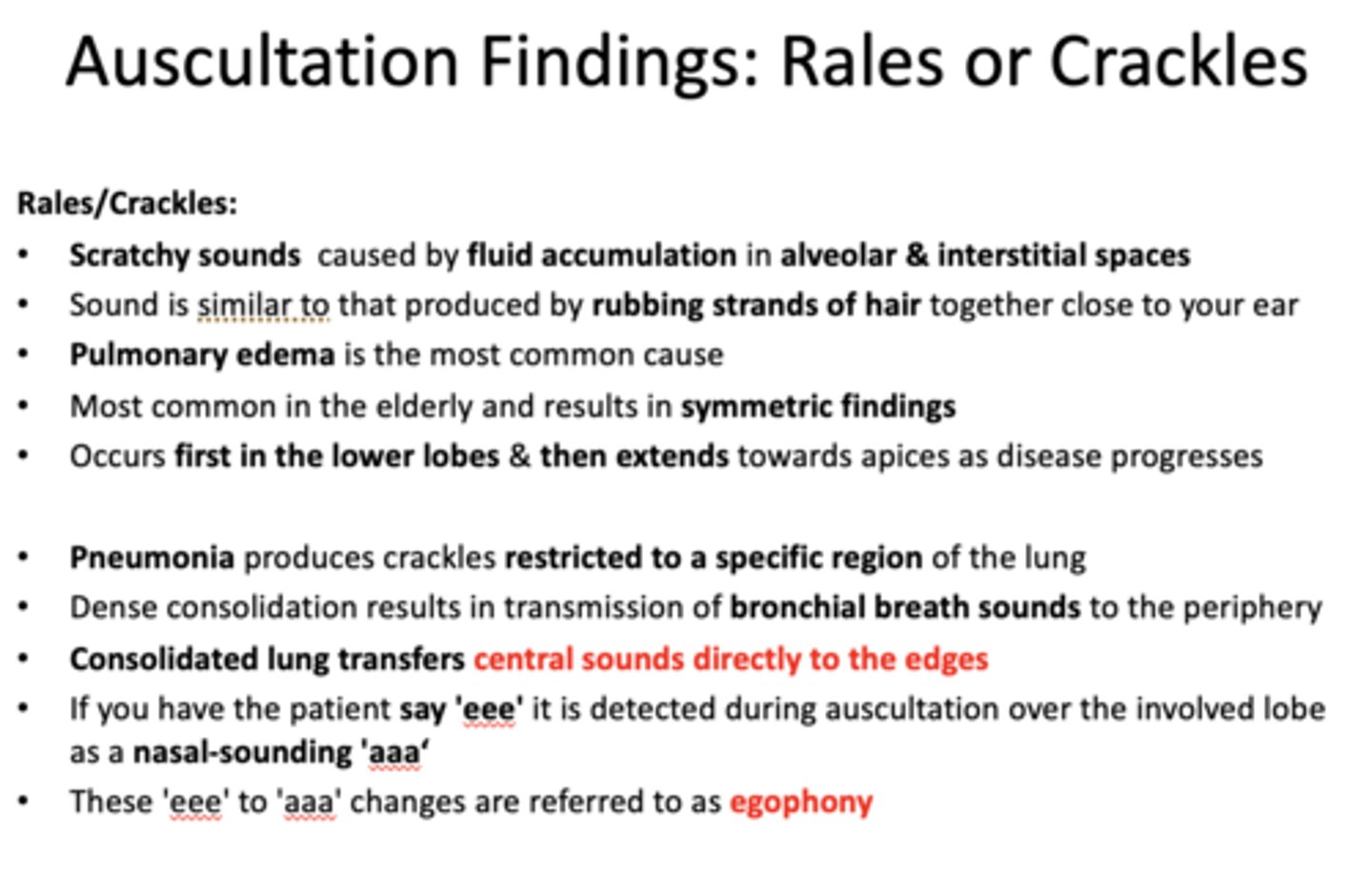
These 'eee' to 'aaa' changes are referred to as ____________
egophony
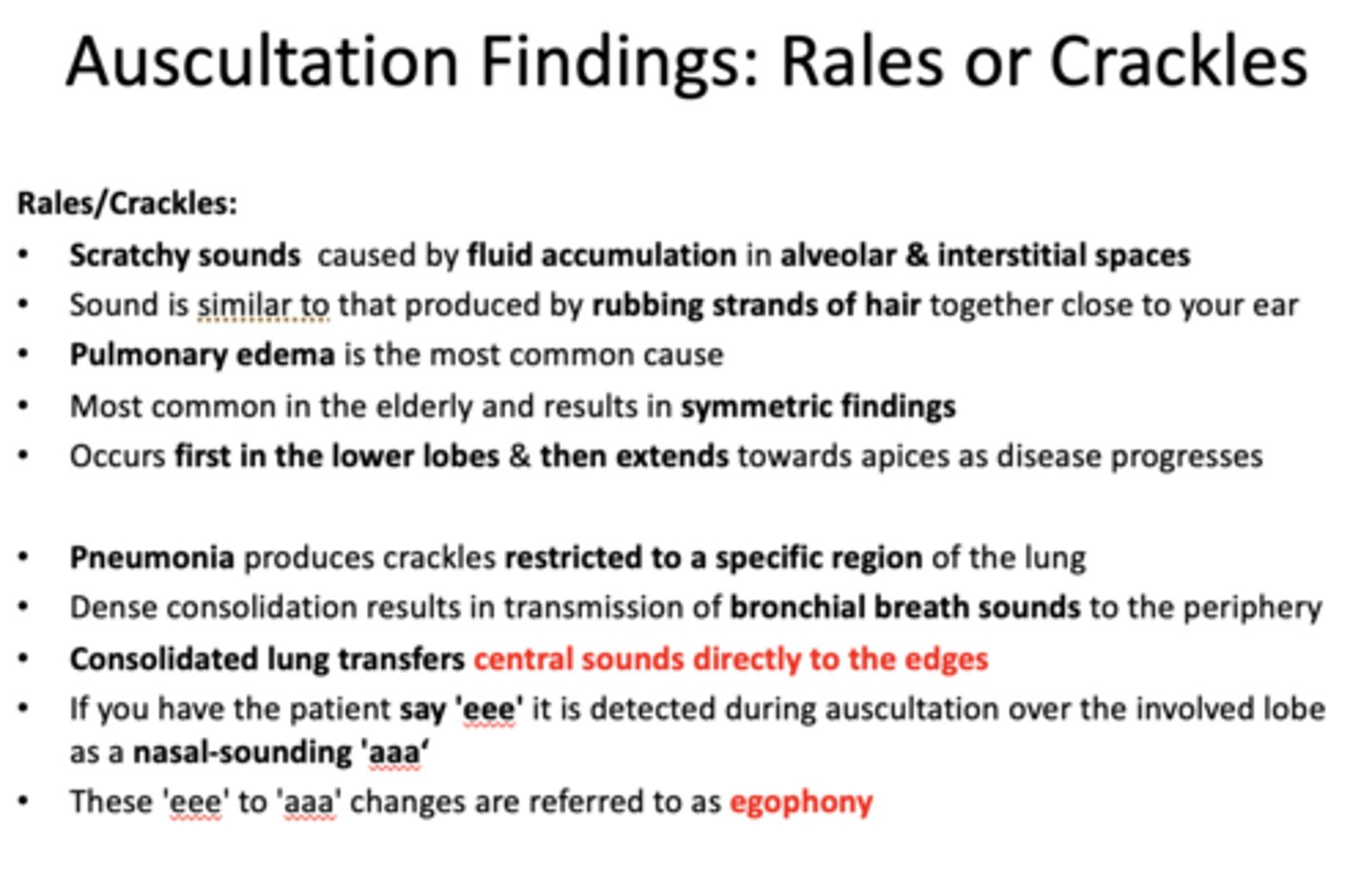
What has the following characteristics?
- High pitched whistling sounds produced by air going through narrowed airways
- Most often heard when patient breathes out/expiration
- Caued by bronchoconstriction, secretions, mucosal edema
wheezes
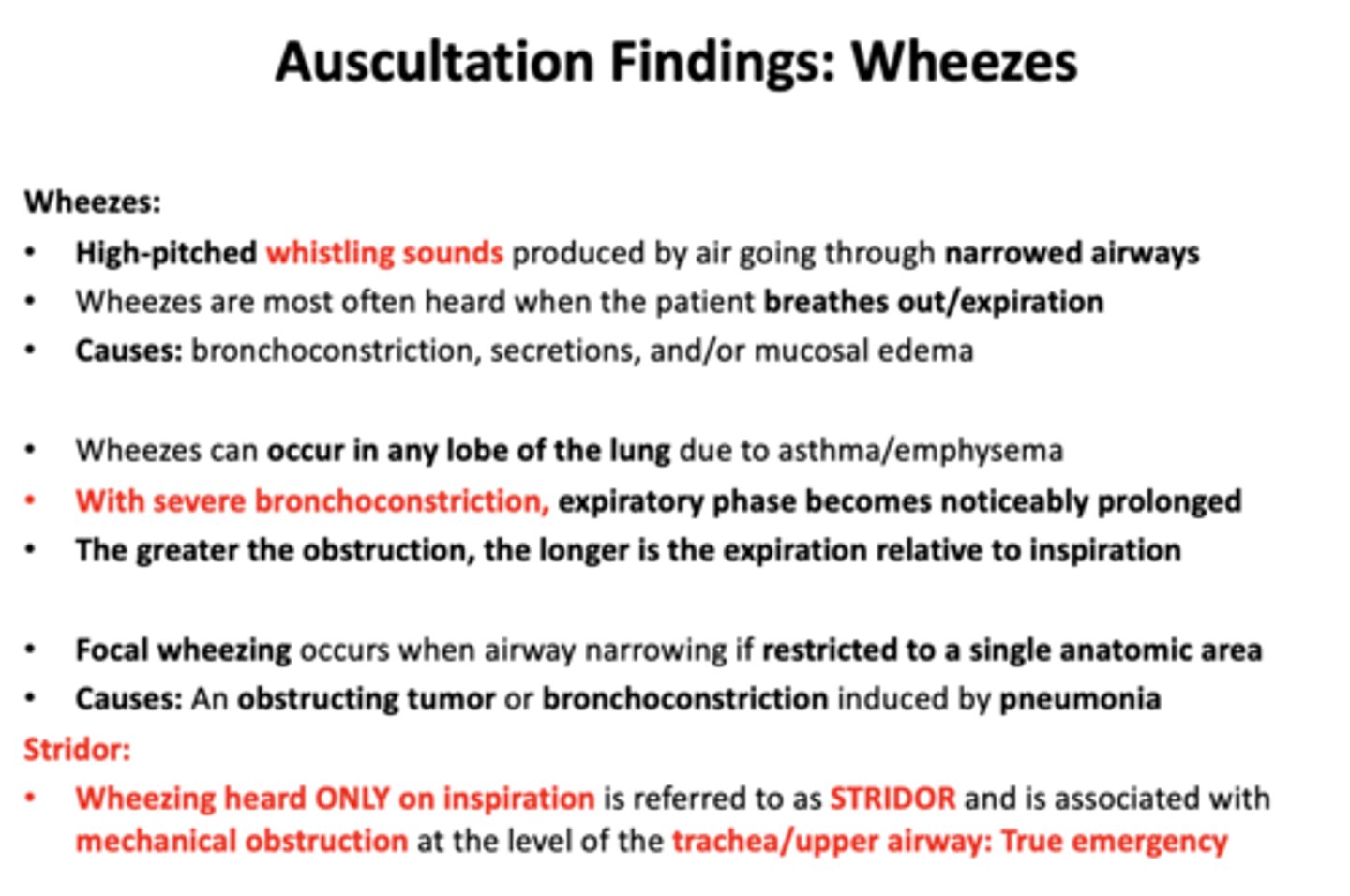
Wheezes can occur in any lobe of the lung due to asthma/emphysema. With _________, expiratory phase becomes noticeably prolonged. The greater the obstruction, the longer is the expiration relative to inspiration.
severe bronchoconstriction

_________ occurs when airway narrowing is restrcited to a single anatomic area
focal wheezing
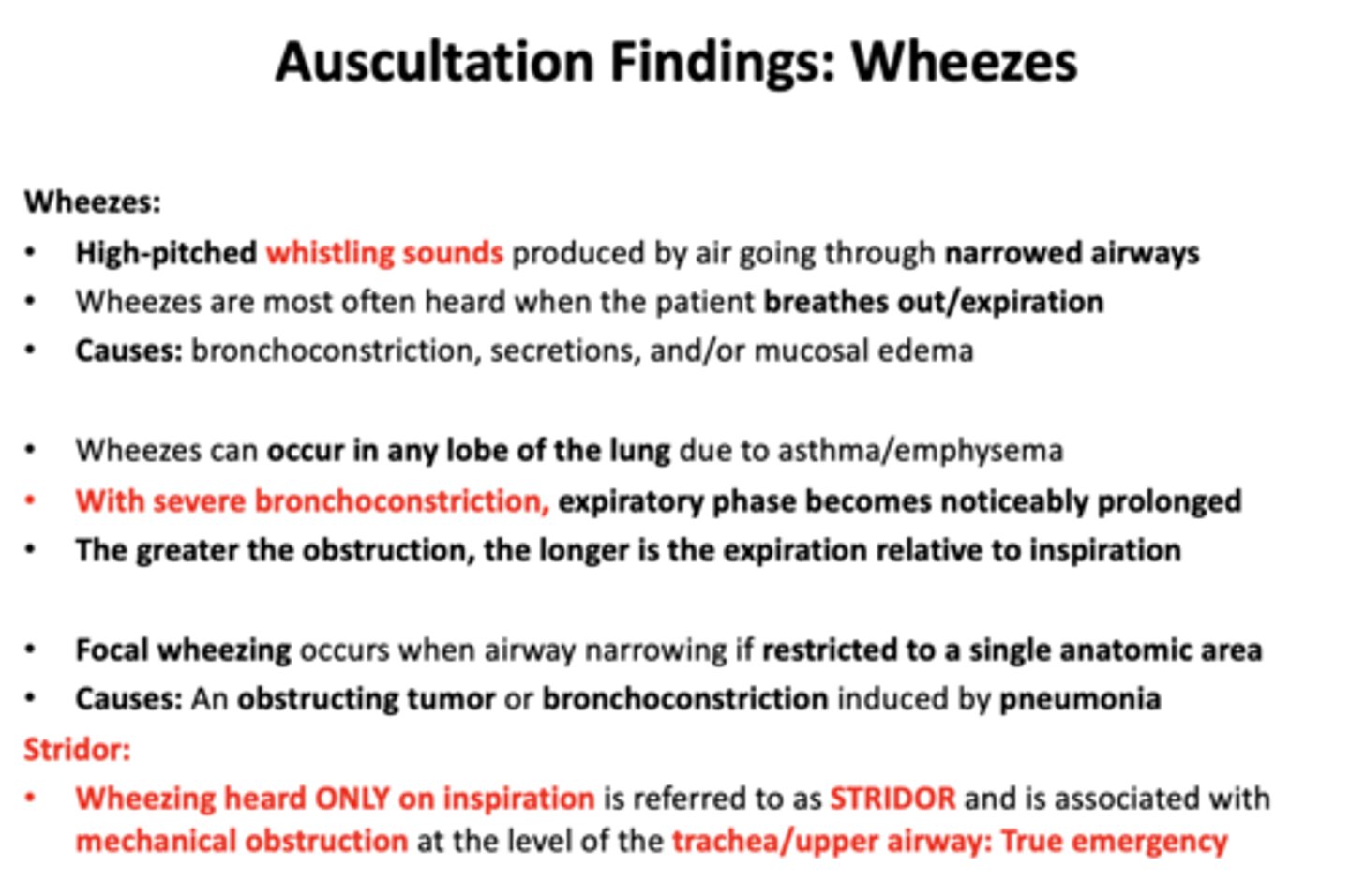
__________ is caused by an obstructing tumor or bronchoconstriction induced by pneumonia
focal wheezing

Wheezing heard ONLY on inspiration is referred to as ___________
stridor
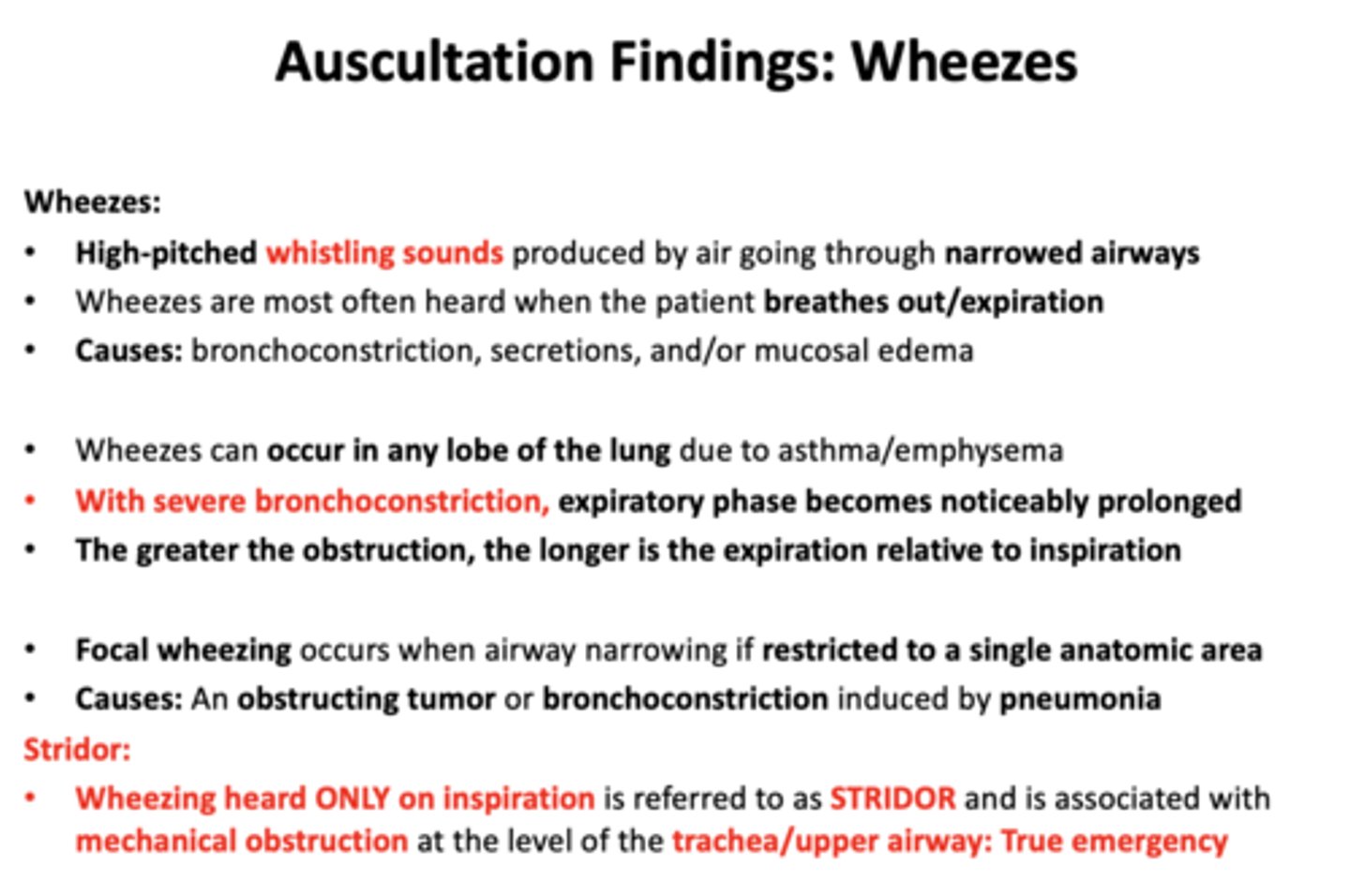
___________ is associated with mechanical obstruction at the level of the trachea/upper airway: True emergency
stridor
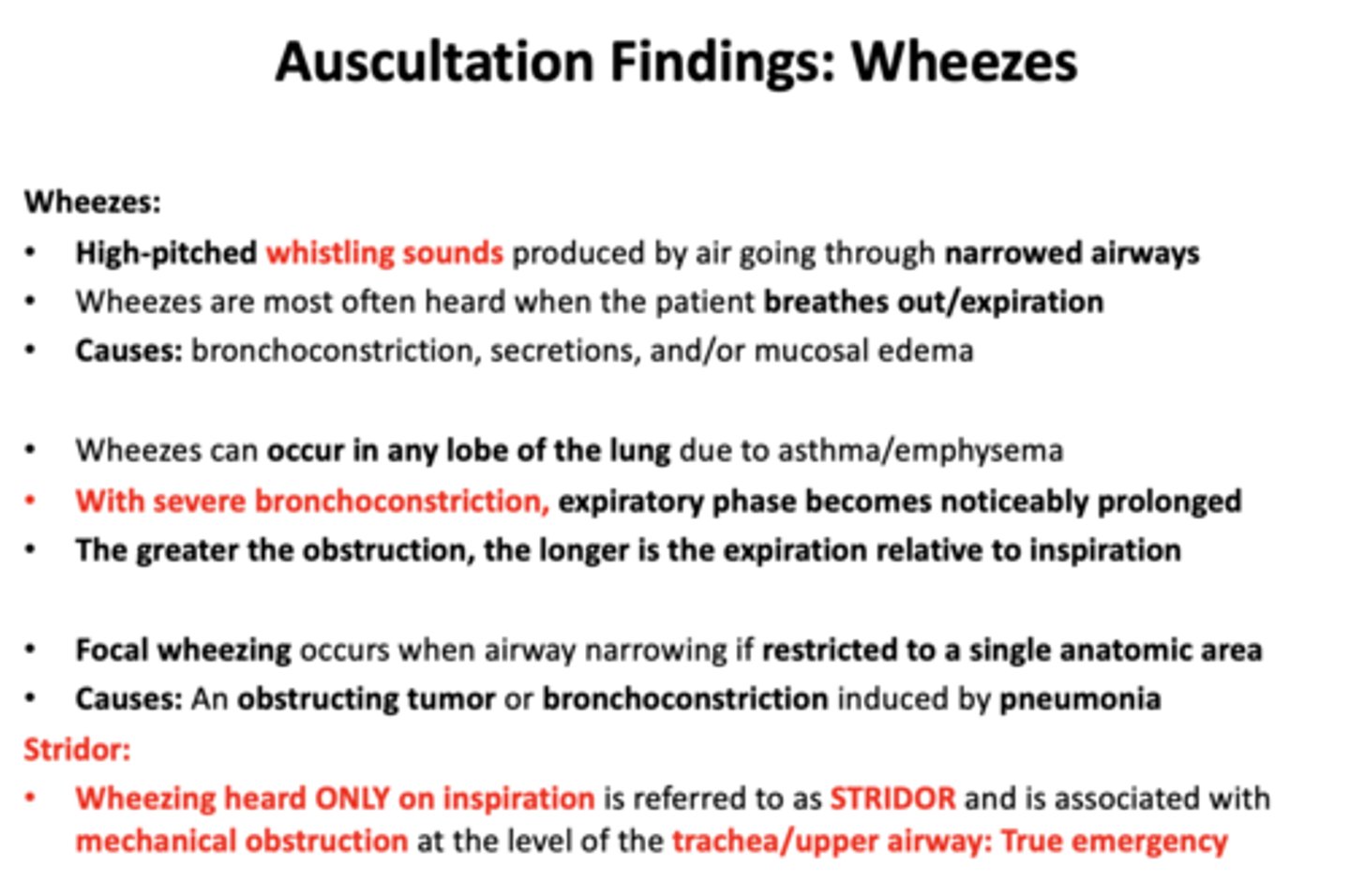
What has the following characteristics?
- Low pitched wheezes
- Causes a gurgling-type nose, like sucking last sips via straw
- Often caused by secretions in larger airways + obstructions
- Causes: pneumonia, chronic bronchitis, cystic fibrosis, COPD
rhonchi

patients with severe, stable emphysema produce _______
very little sound
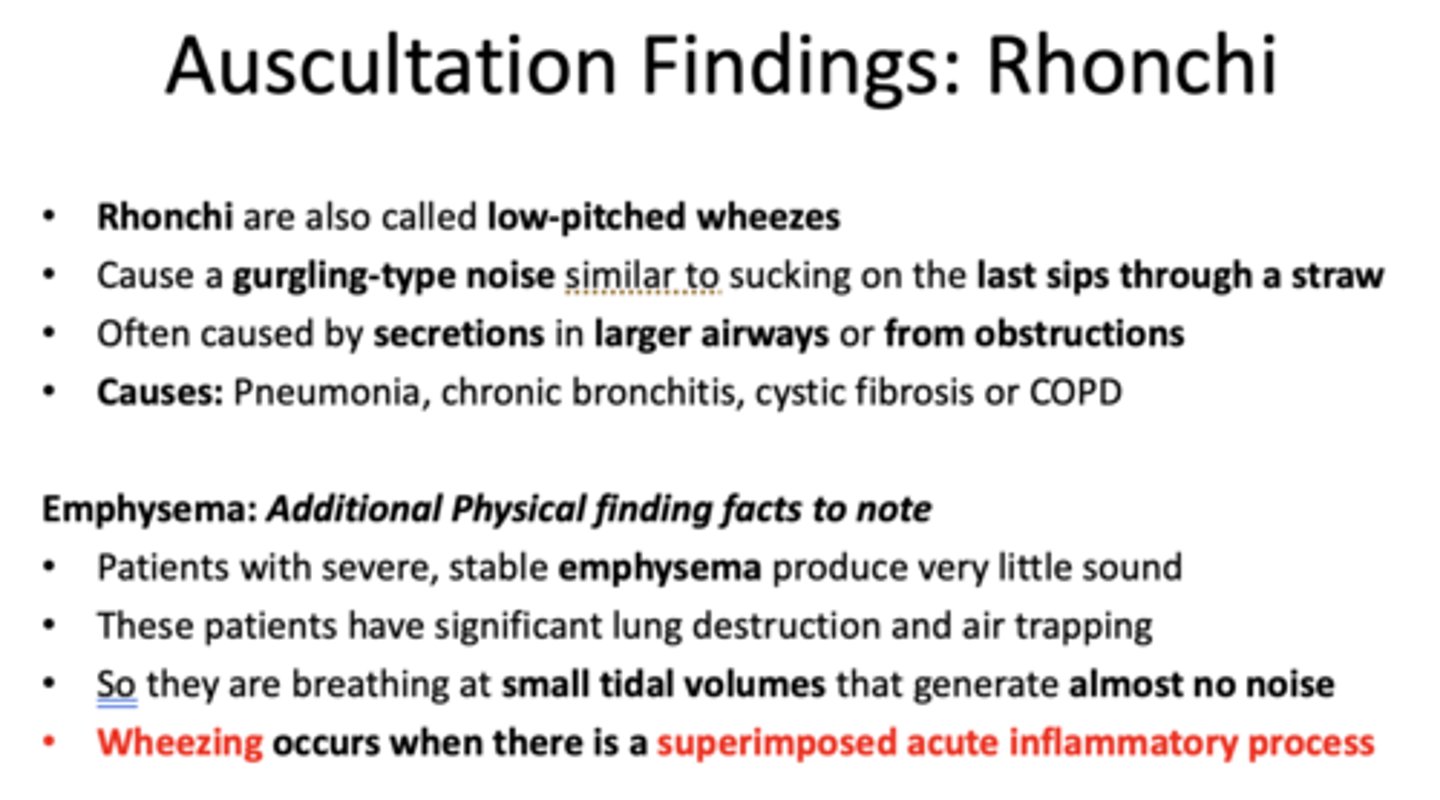
In emphysema, __________ occurs when there is a superimposted acute inflammatory process
wheezing
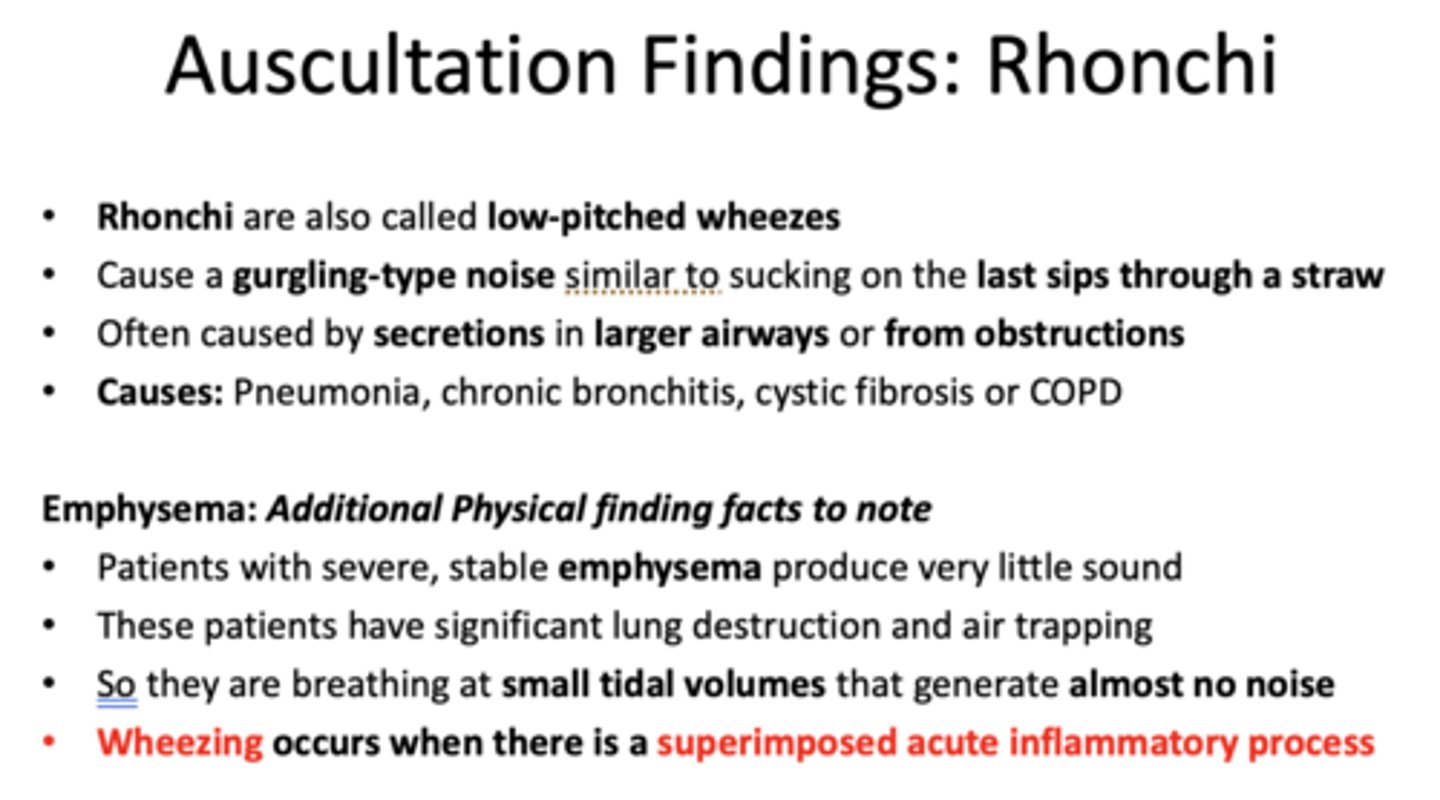
Dullness on percussion can be from ___________ or ___________
consolidation, effusion
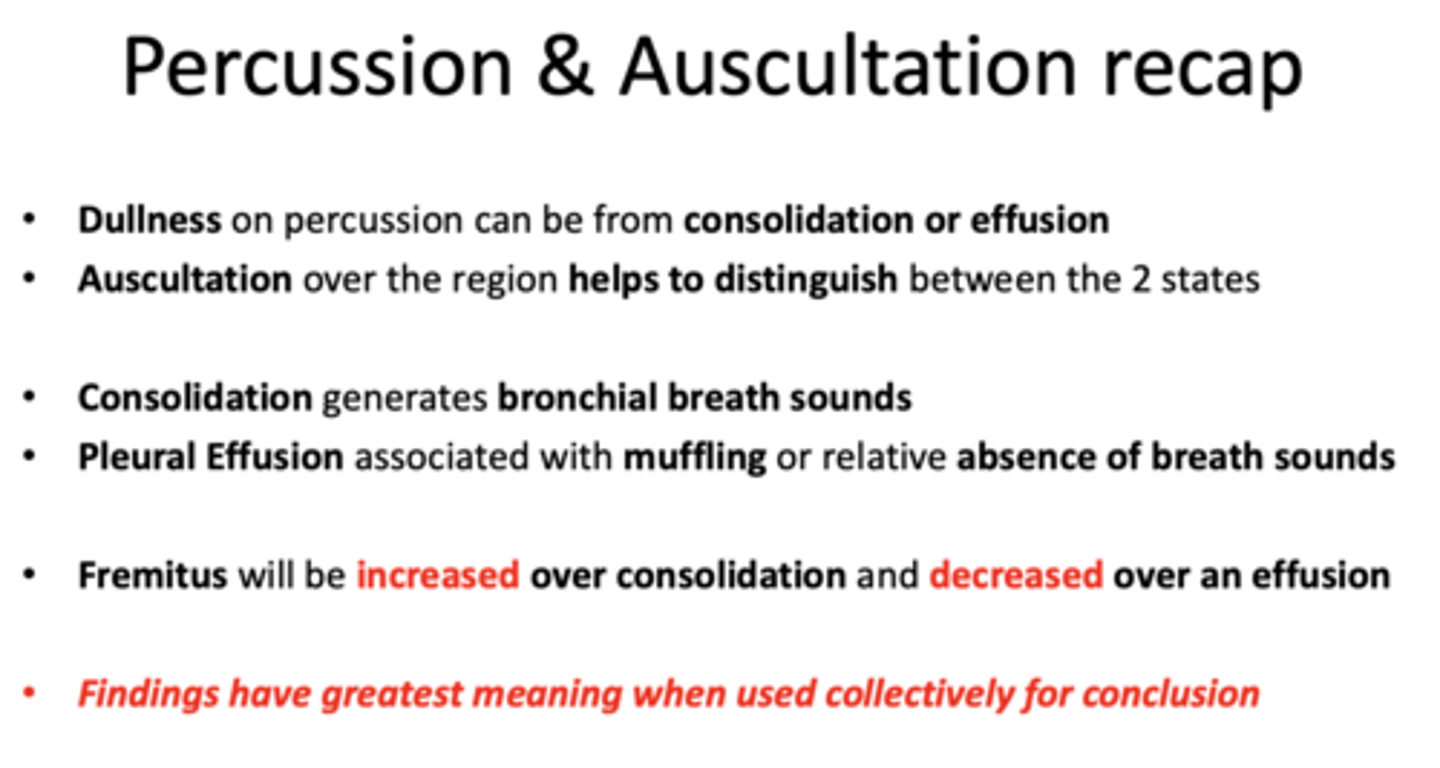
Consolidation generates what breath sounds?
Bronchial breath sounds
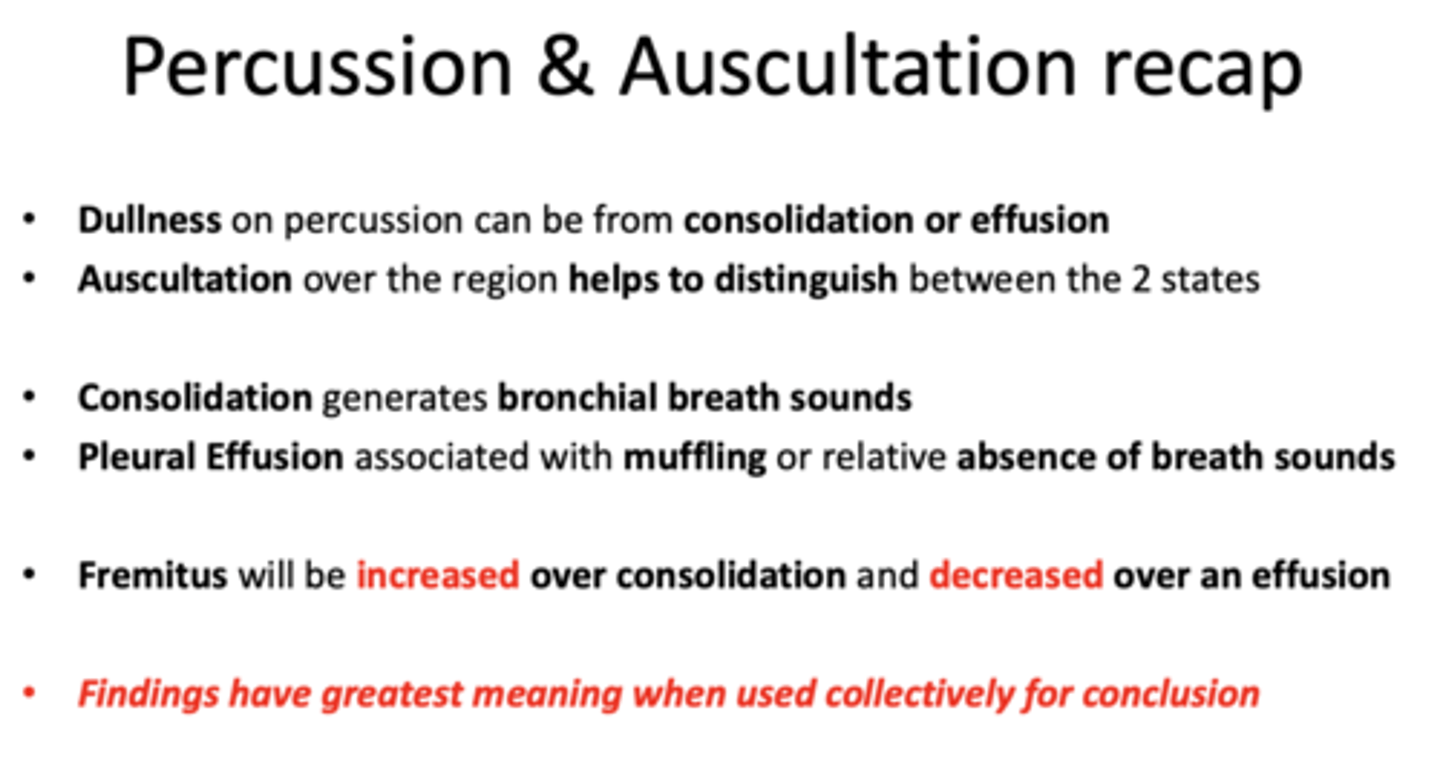
________ is associated with muffling or relative absence of breath sounds
Pleural Effusion
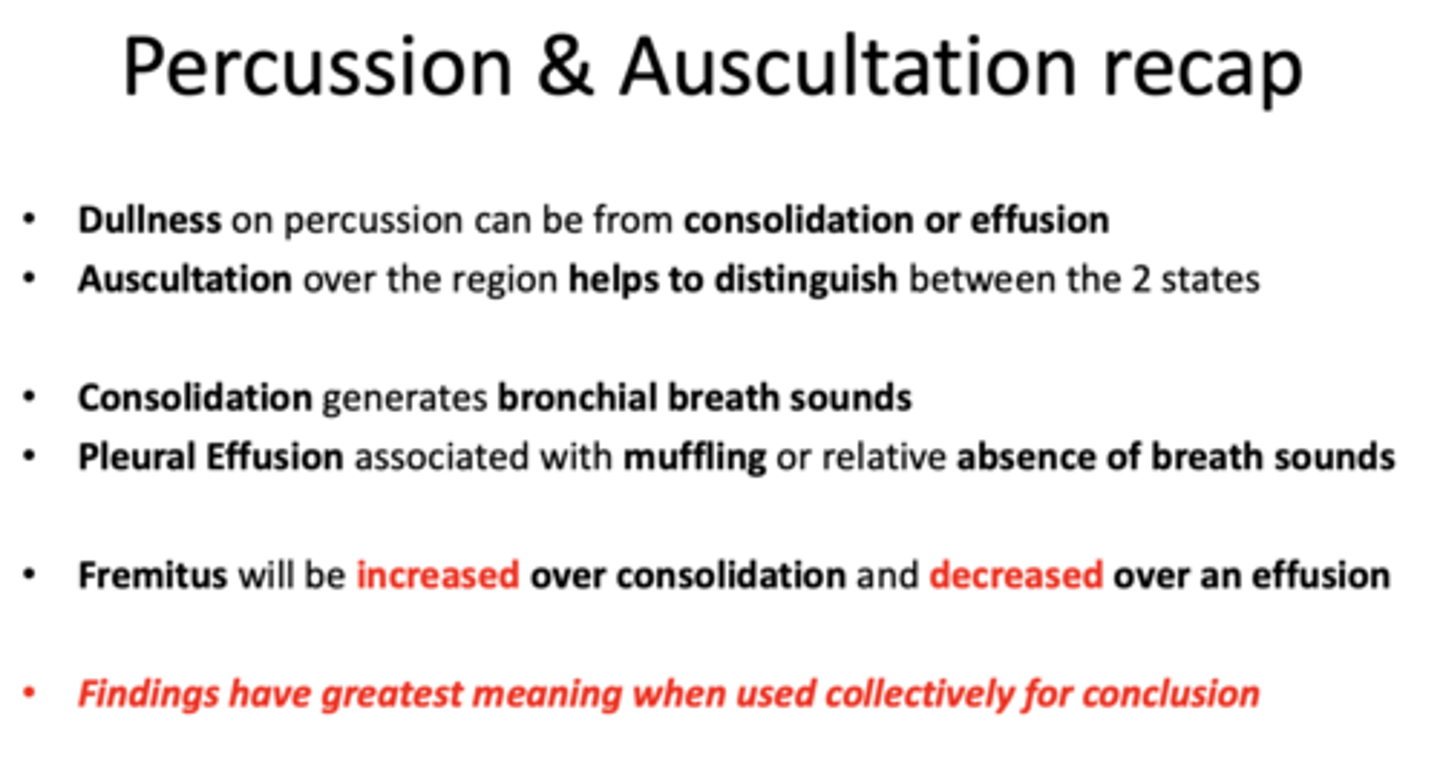
__________ will be increased over consolidation and decreased over an effusion
Fremitus

T/F: Findings have greatest meaning when used collectively for conclusion
True
